Geometry and consistency of principal binets
Jan Techter
joint work with Niklas Affolter
Part 1: Geometry
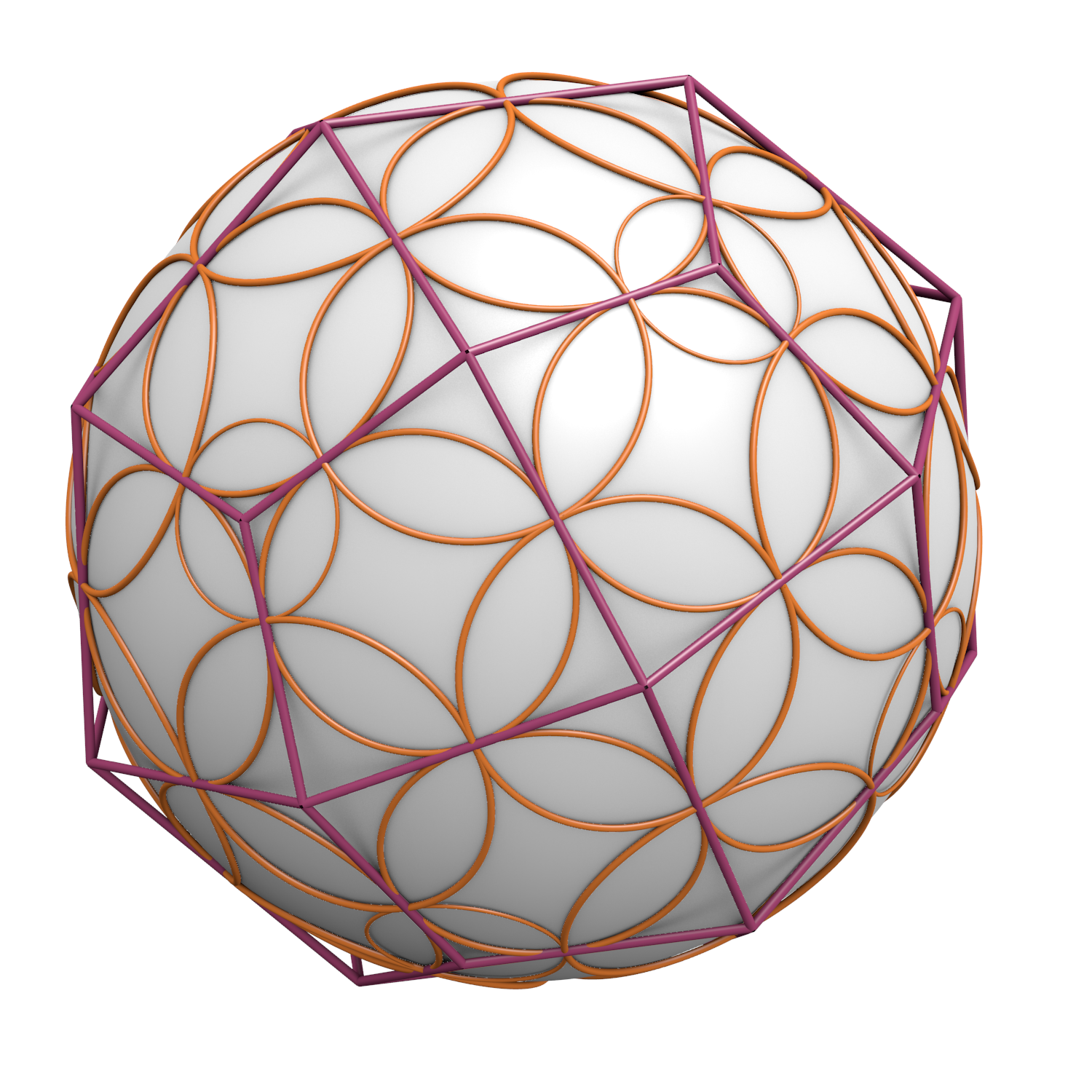
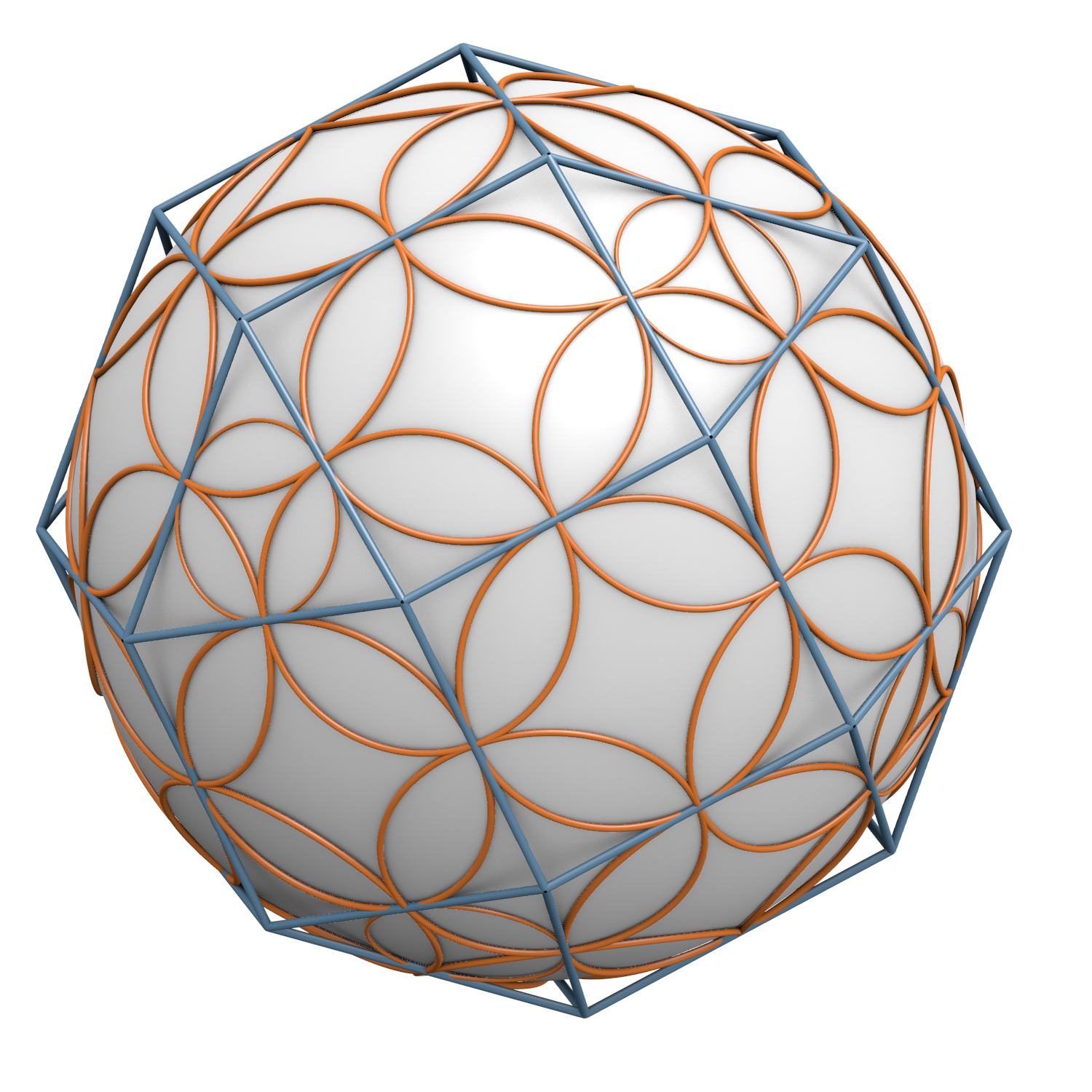
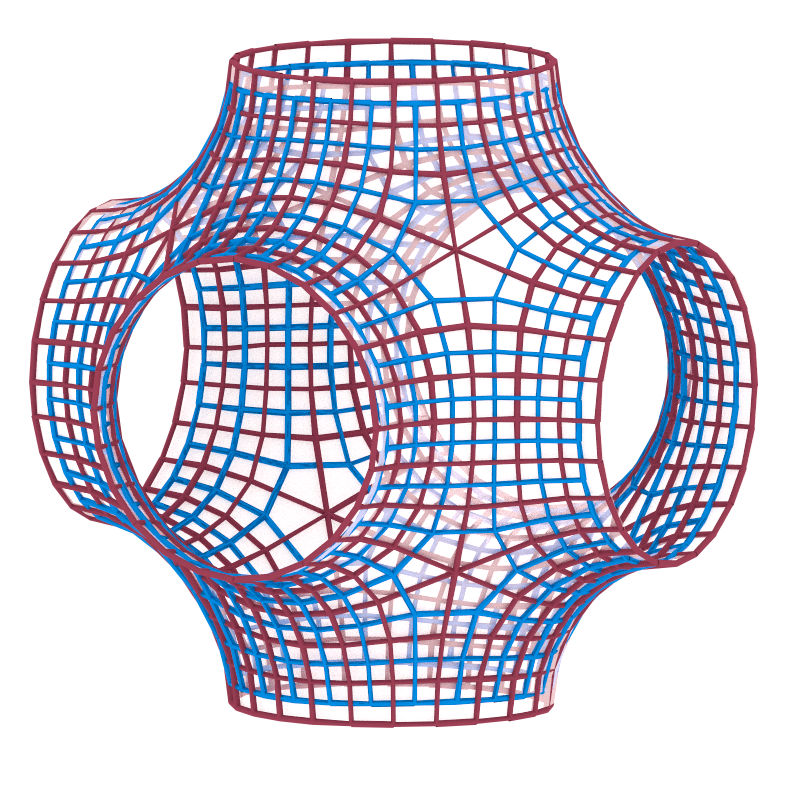
-
[BHS08] Minimal surfaces from circle patterns: Geometry from combinatorics
Bobenko, Hoffmann, Springborn.

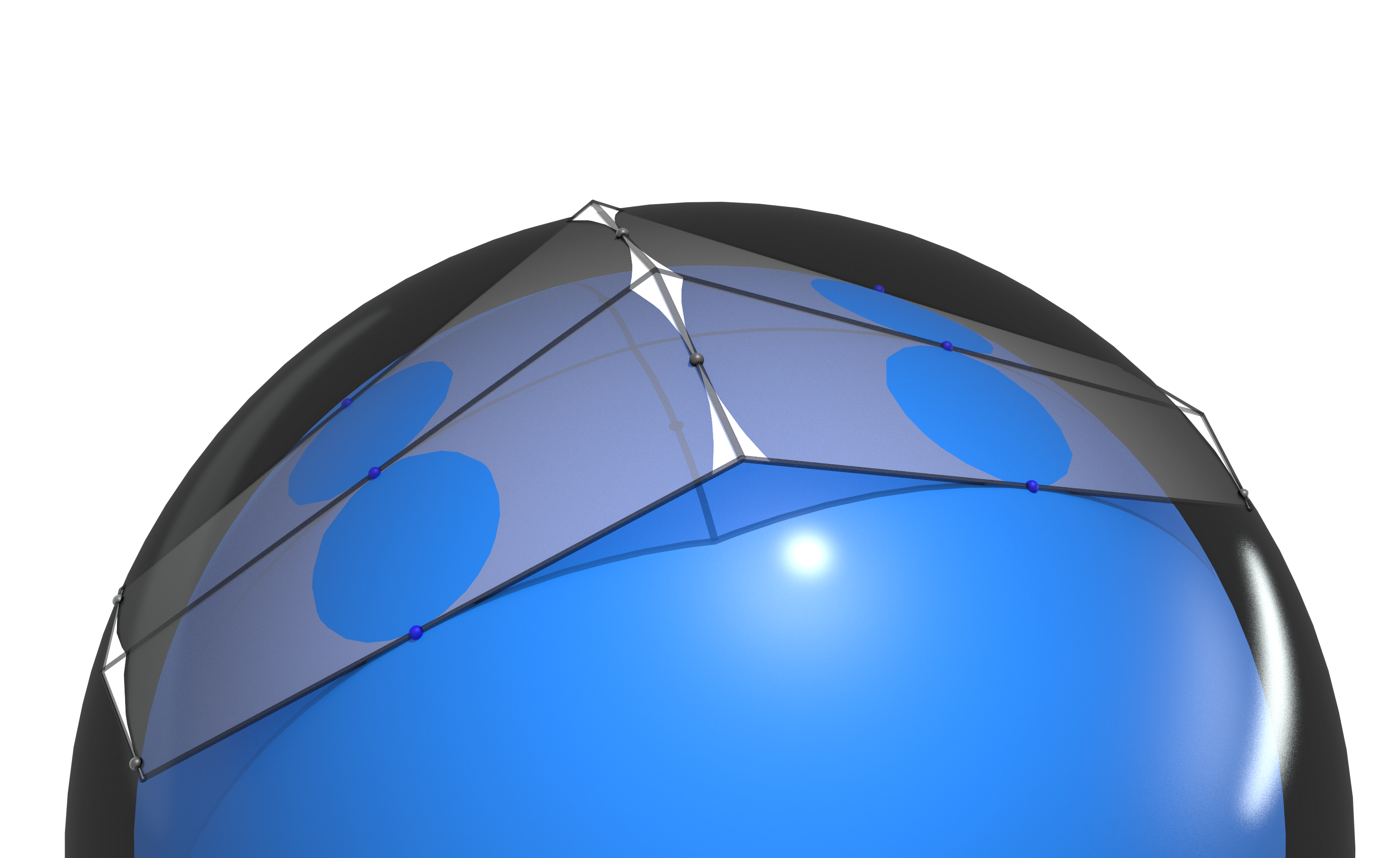
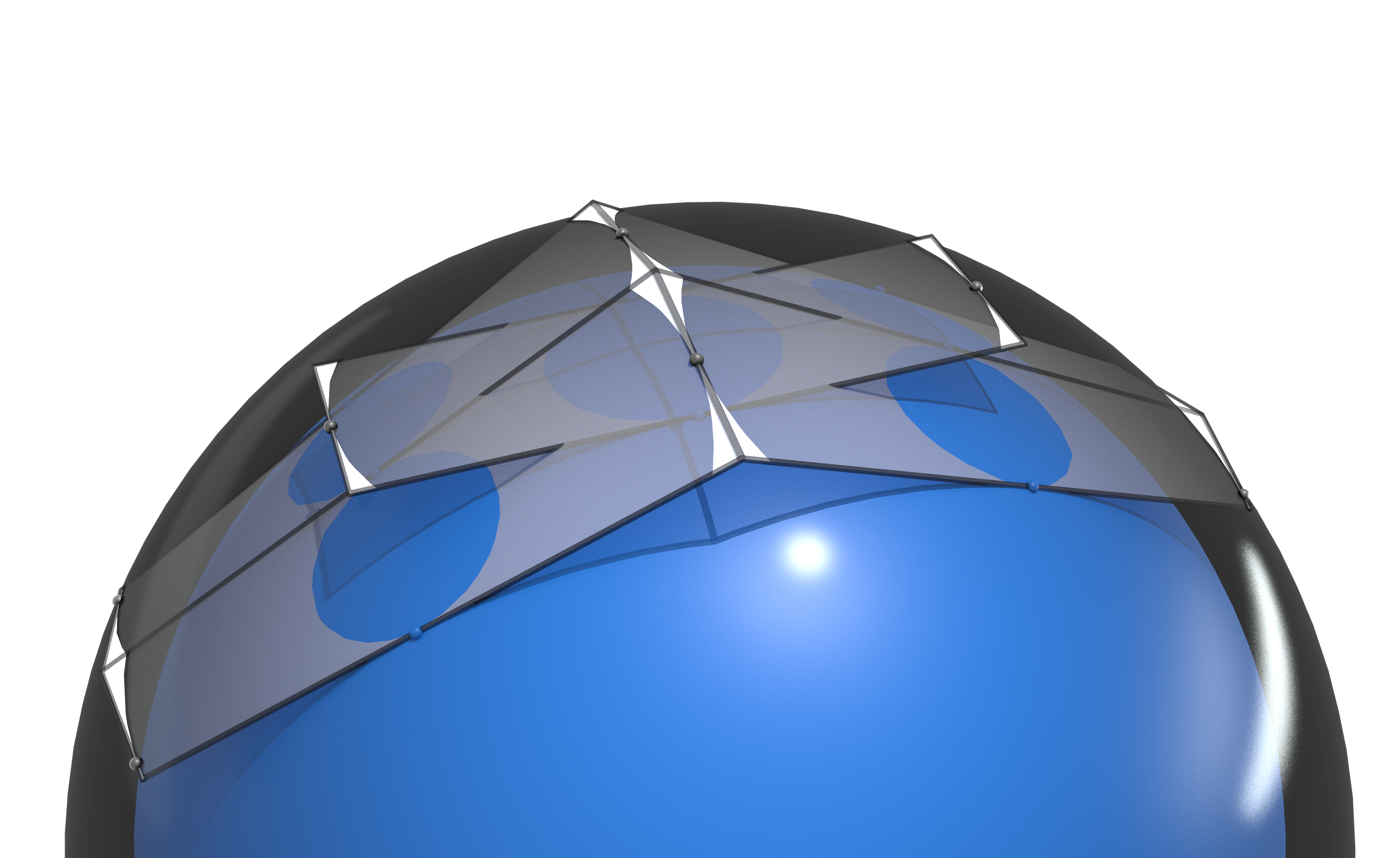
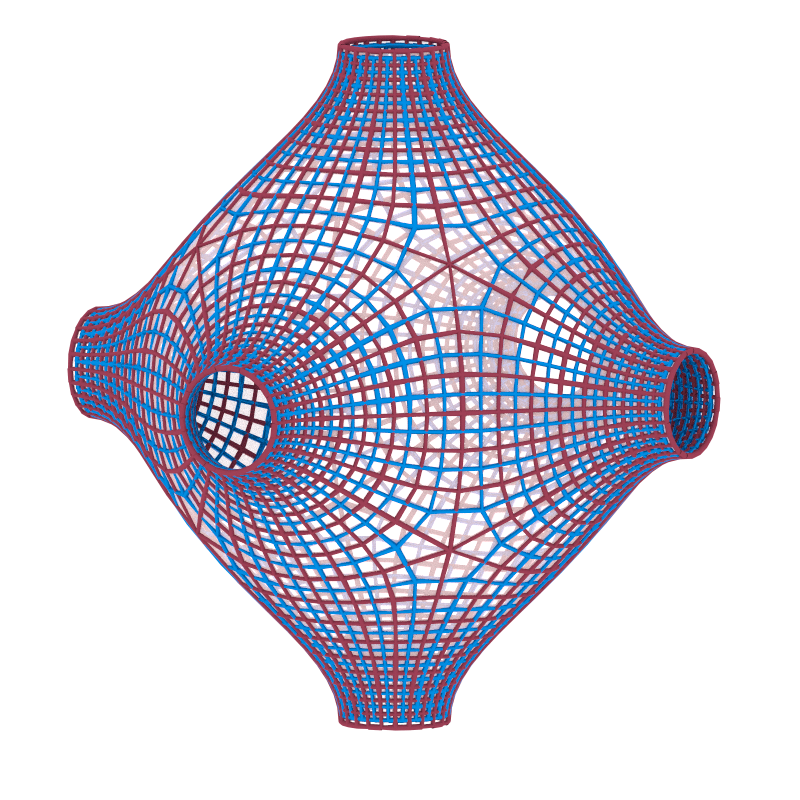
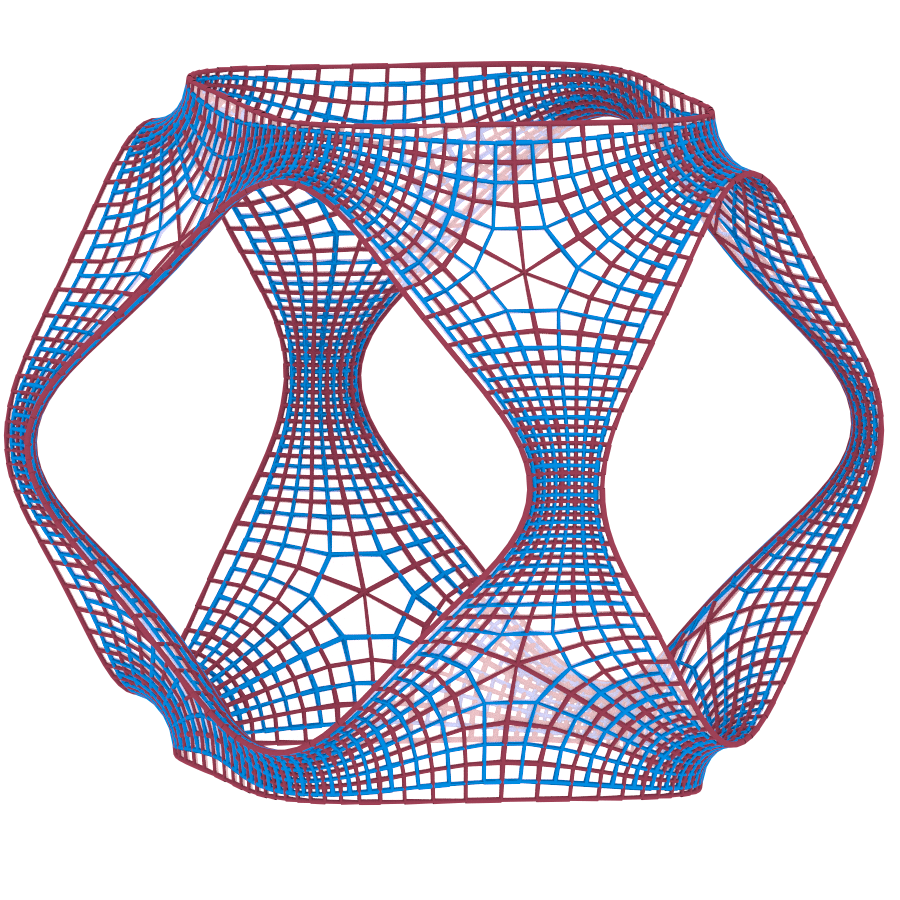
-
[BHR19] Orthogonal ring patterns
Bobenko, Hoffmann, Rörig. -
[BHS23+] Constant mean curvature surfaces from ring patterns: Geometry from combinatorics
Bobenko, Hoffmann, Smeenk.
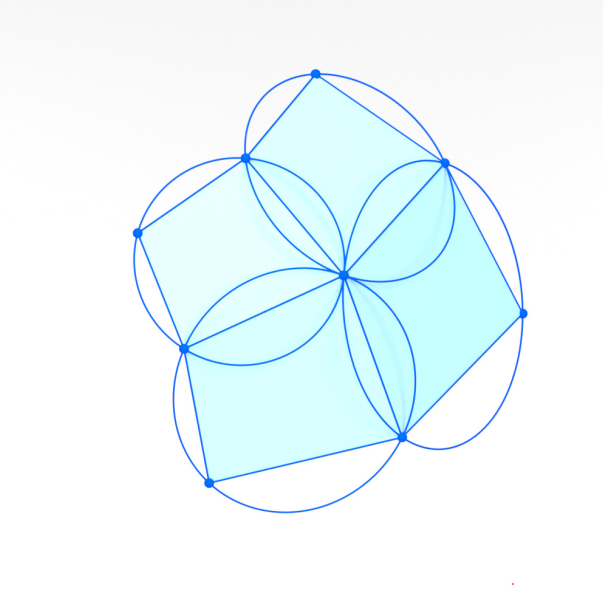
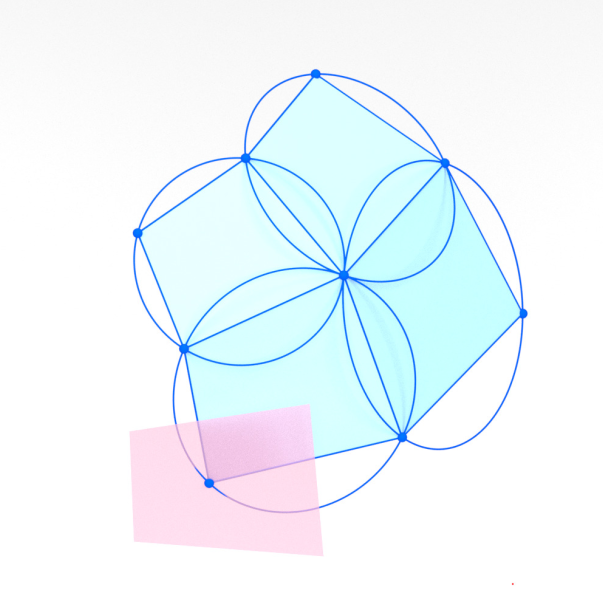
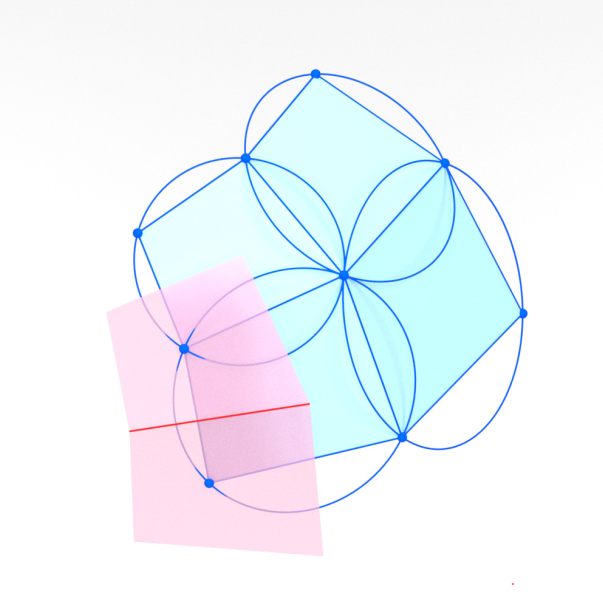
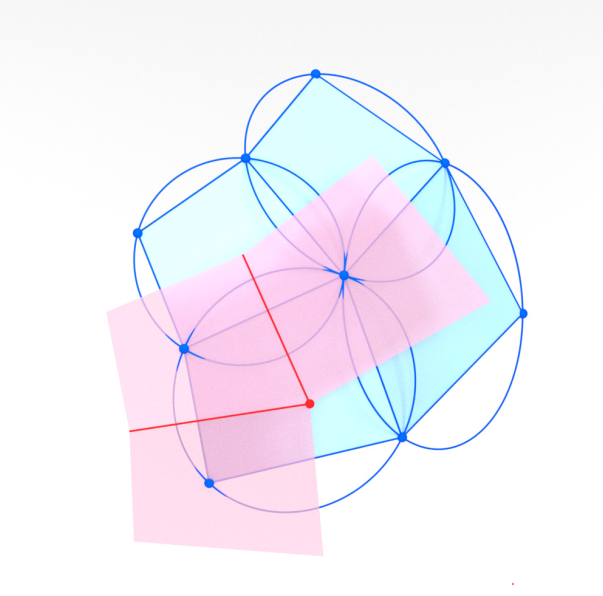
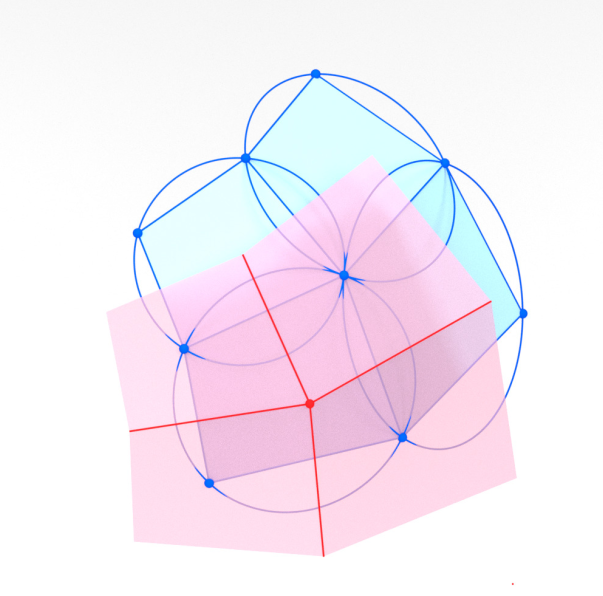
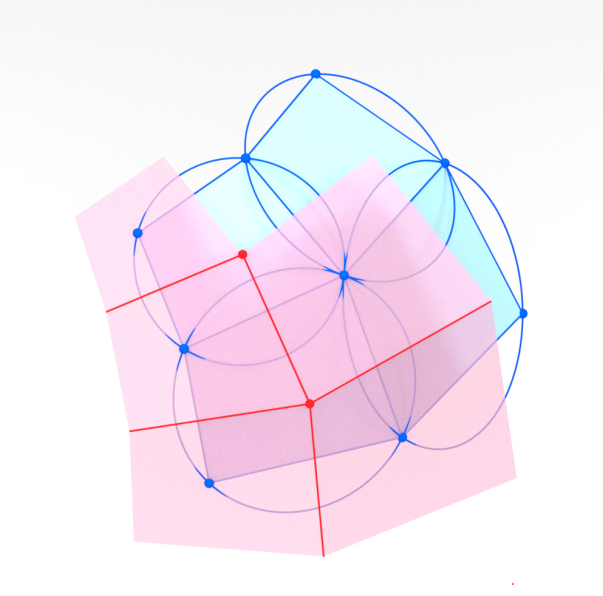
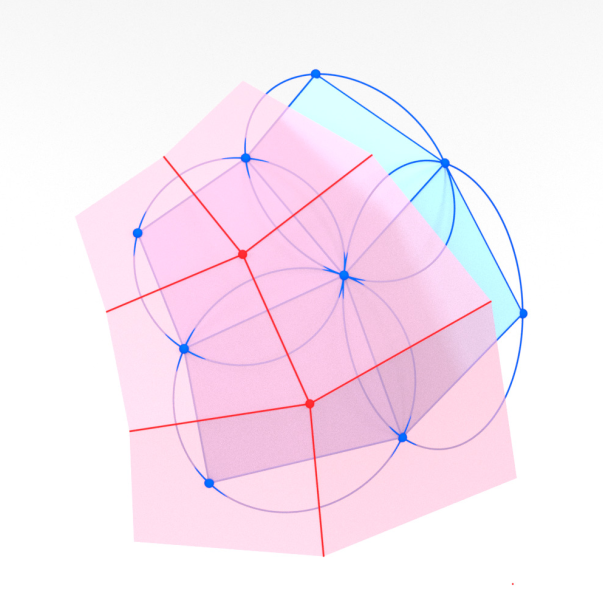
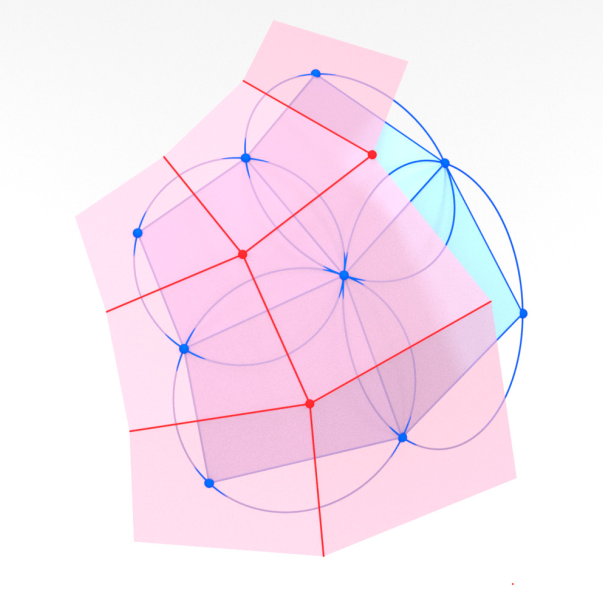

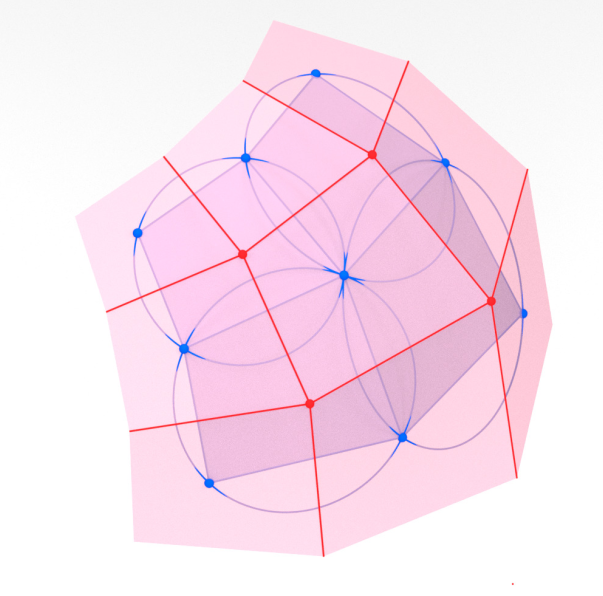
-
[BS07] On organizing principles of Discrete Differential Geometry. The geometry of spheres
Bobenko, Suris. -
[PW08] The focal geometry of circular and conical meshes
Pottmann, Wallner.

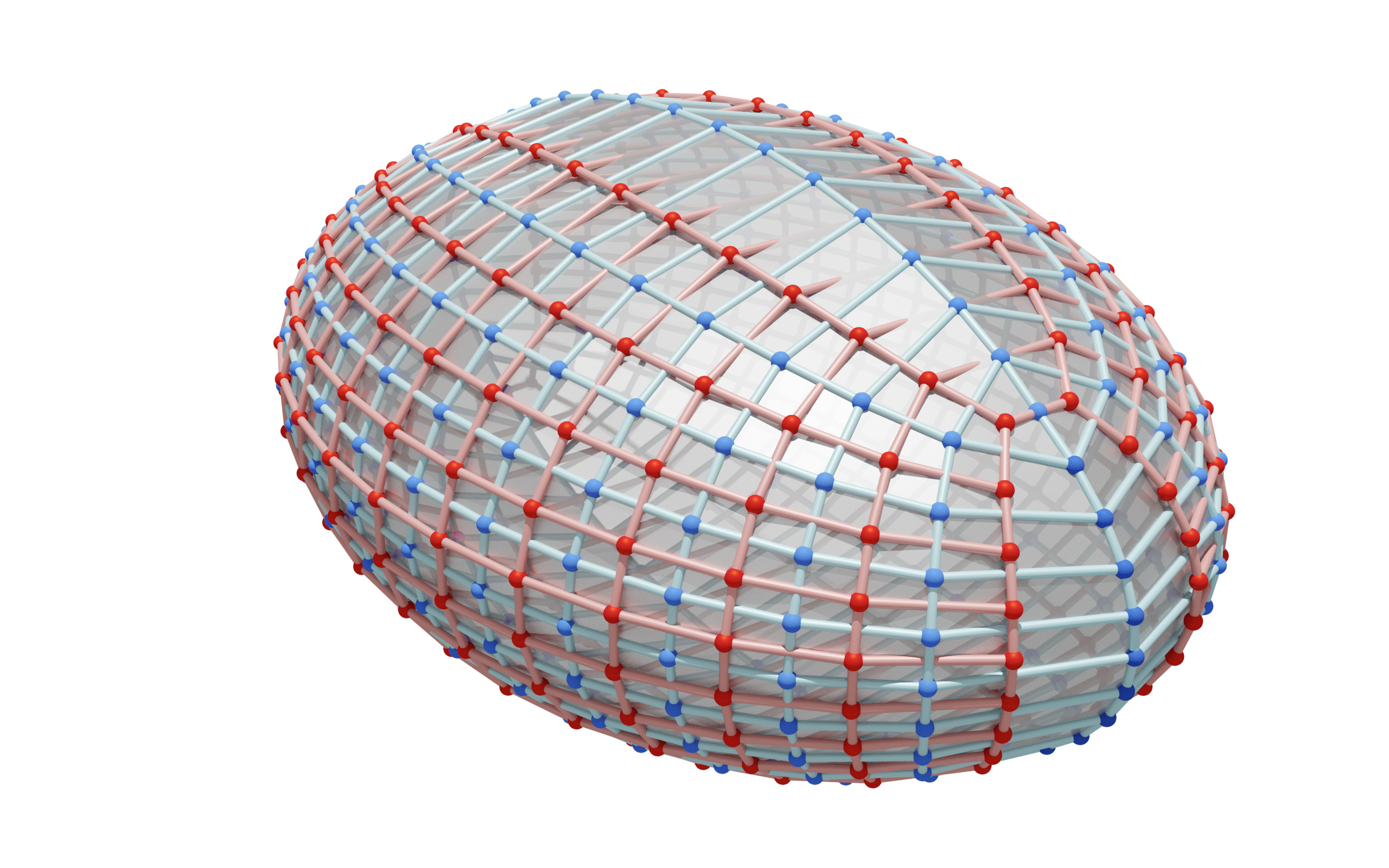
-
[BSST18] On a Discretization of Confocal Quadrics. A Geometric Approach to General Parametrizations
Bobenko, Suris, Schief, T. -
[HST23+]
A canonical discrete analogue of the classical circular cross sections of ellipsoids and their isometric deformation
Huang, Schief, T.

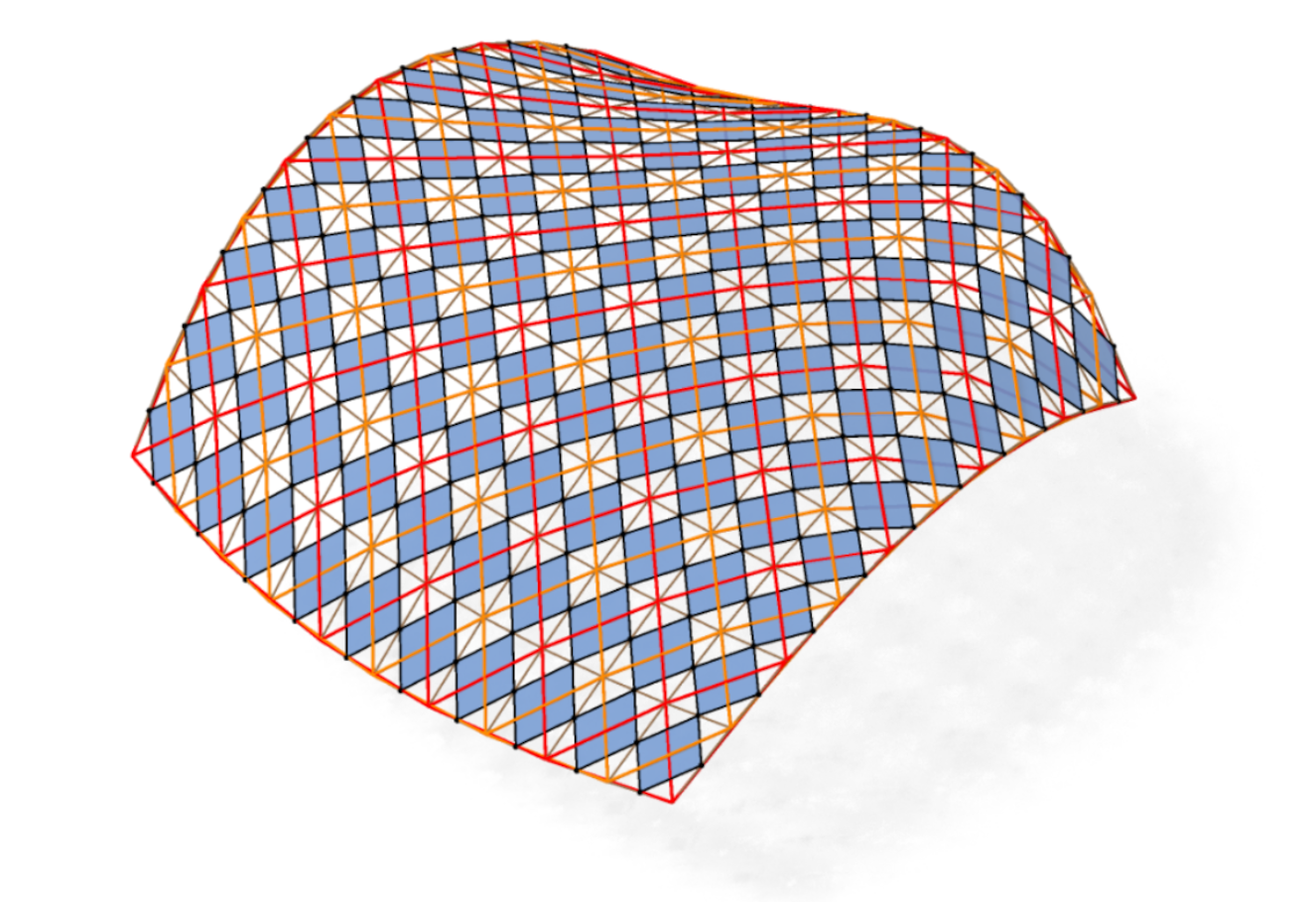
- [PJWP19] Checkerboard patterns with black rectangles
Peng, Jiang, Wonka, Pottmann. - [D22] Discrete Isothermic Nets Based on Checkerboard Patterns
Dellinger.
A ("classical" discrete) net is a map
$\Z^2 \rightarrow \R\mathrm{P}^n$.
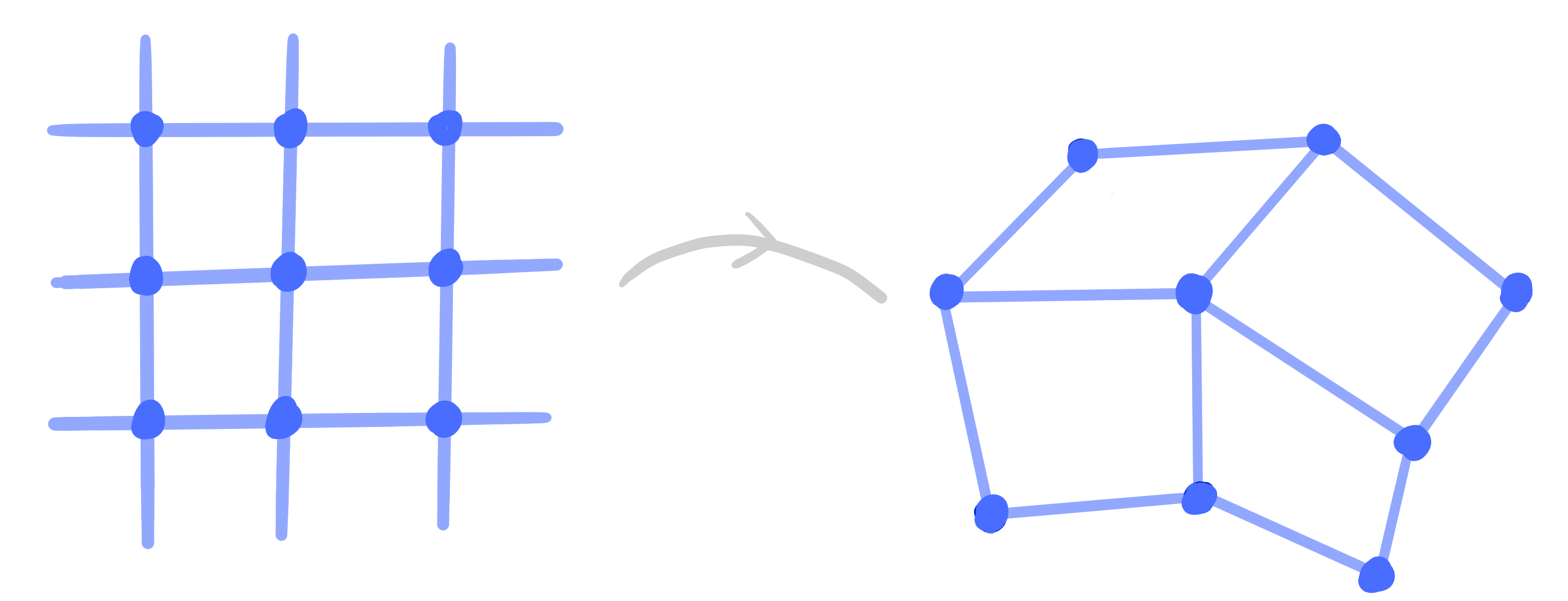
Definition:
A binet is a map
$\Z^2 \cup (\Z^2)^* \rightarrow \R\mathrm{P}^n$,
$(\Z^2)^* = F(\Z^2)$.
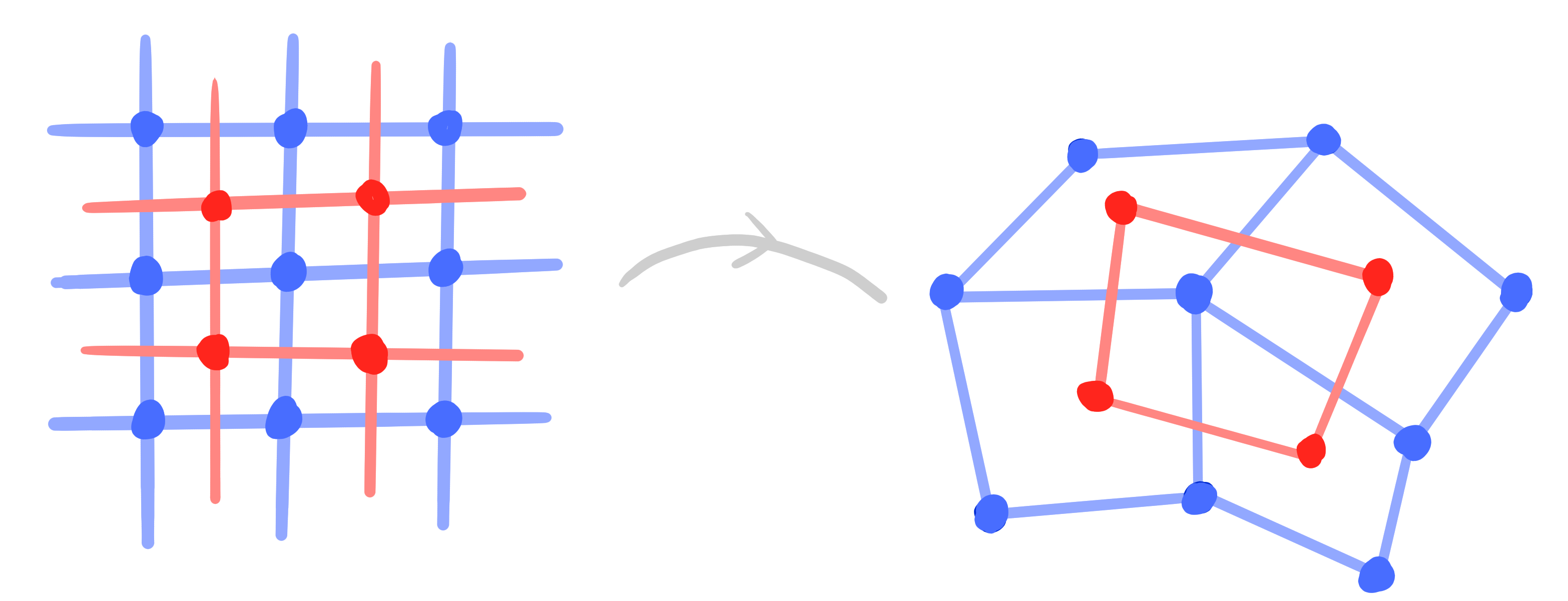
- vertices $V = V(\Z^2) = \Z^2$
- edges $E = E(\Z^2)$
- faces $F = F(\Z^2) = (\Z^2)^*$
- double graph $D = V \cup F$ ,$\qquad\qquad$ then a binet is a map $D \rightarrow \R\mathrm{P}^n$
- crosses $C = \left\{ (v, f, v', f') ~|~ v,v'\in V,\quad f, f'\in F,\quad v, v' \text{ incident to } f, f' \right\}$

Definition:
A binet $\quad b : D \rightarrow \R^3 \quad$ is called orthogonal
$\quad \Leftrightarrow \quad b(v) \vee b(v') \perp b(f) \vee b(f') \quad$ for all crosses $\quad (v, f, v', f') \in C$
$\quad \Leftrightarrow \quad b(v) \vee b(v') \perp b(f) \vee b(f') \quad$ for all crosses $\quad (v, f, v', f') \in C$
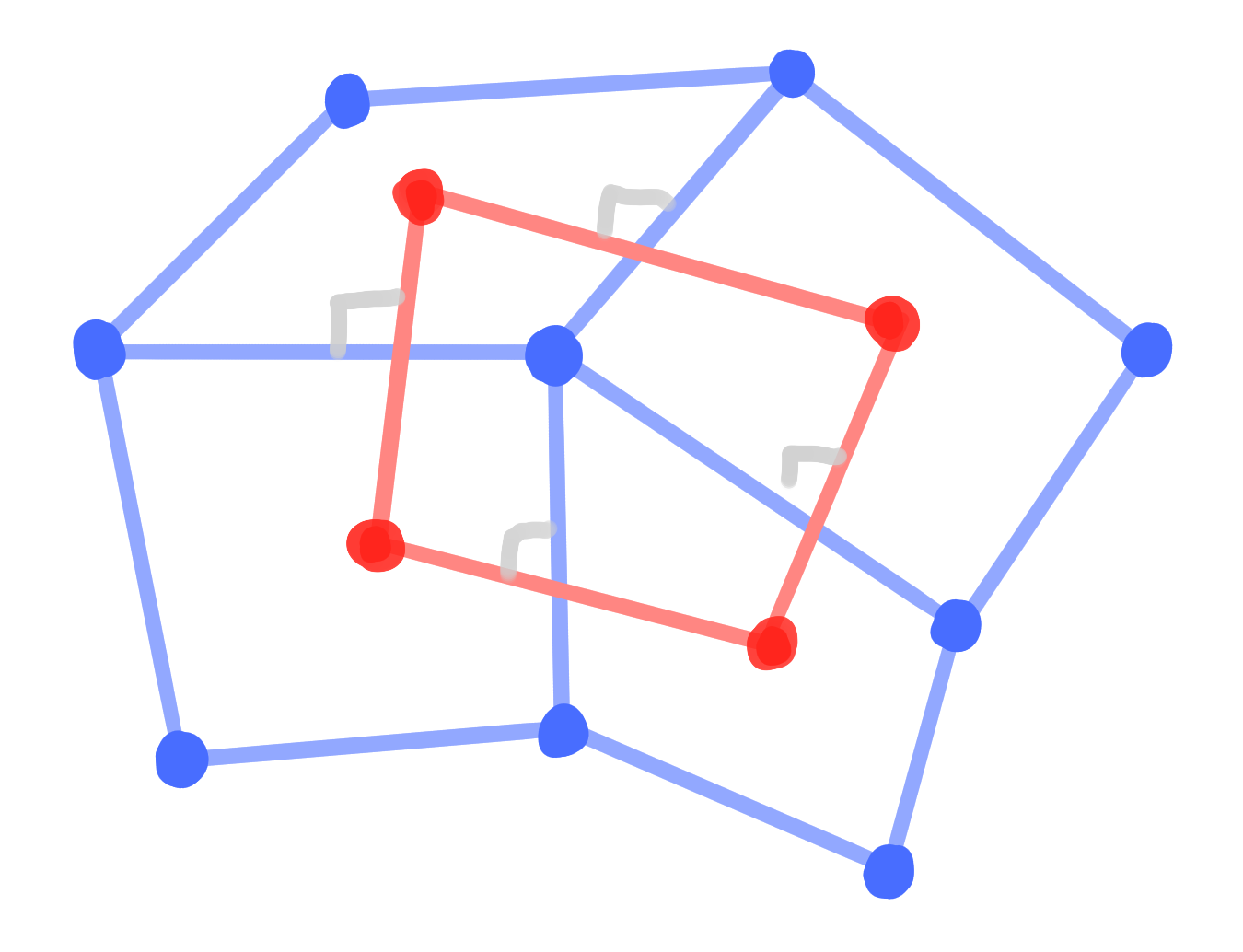
Invariances:
- independent translation of $b|_V$ and $b|_F$
- similarity transformations
- a priori, not Möbius invariant
Theorem:
Let $\quad b : D \rightarrow \R^3\quad$ be an orthogonal binet.
Then there exists a map $\quad S : D \rightarrow \left\{ \text{spheres in } \R^3\right\} \quad$ such that
Then there exists a map $\quad S : D \rightarrow \left\{ \text{spheres in } \R^3\right\} \quad$ such that
- for $d \in D$ the point $b(d)$ is the center of $S(d)$, and
- for incident $v \in V$ and $f \in F$: $\quad S(v) \perp S(f)$.
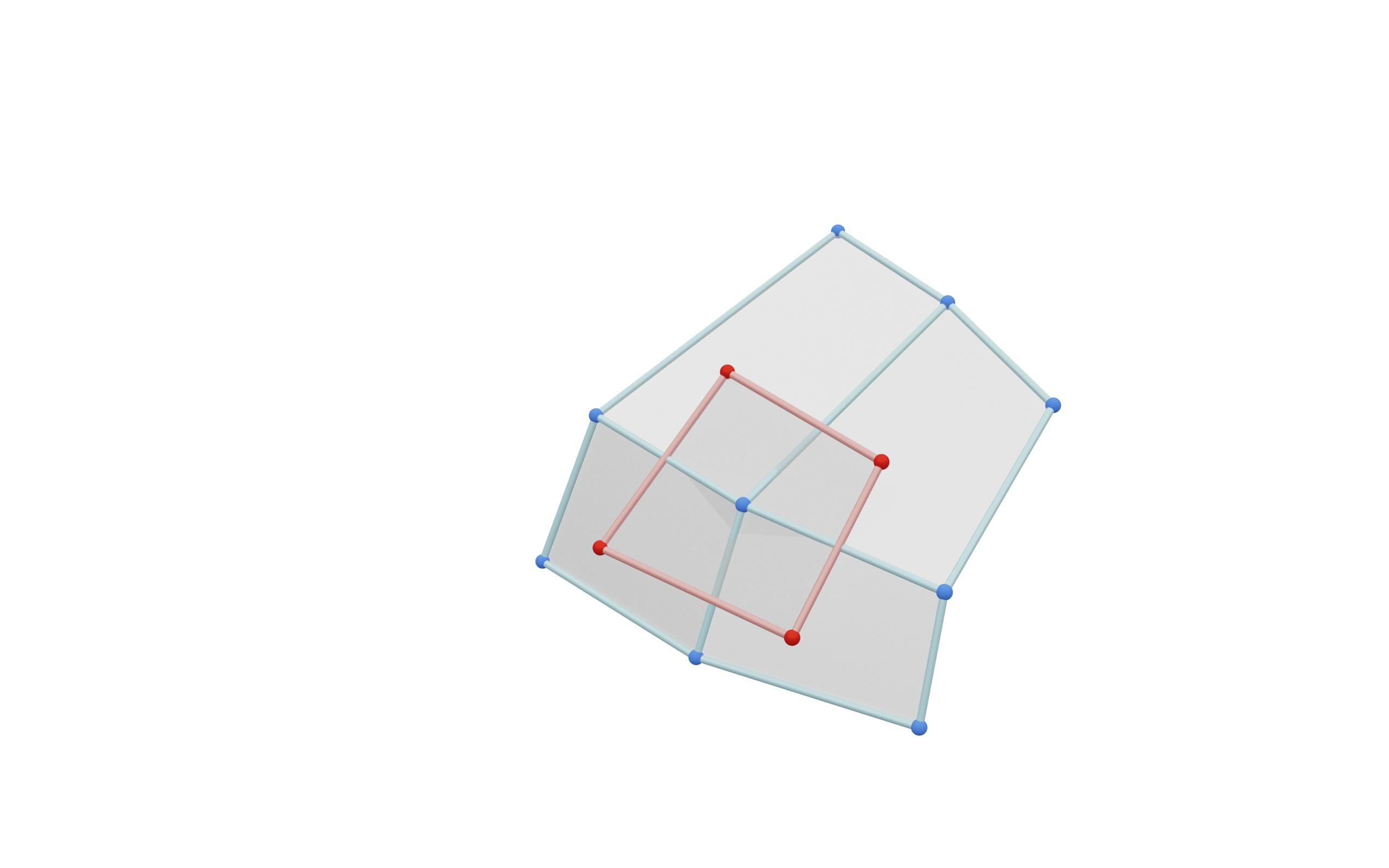
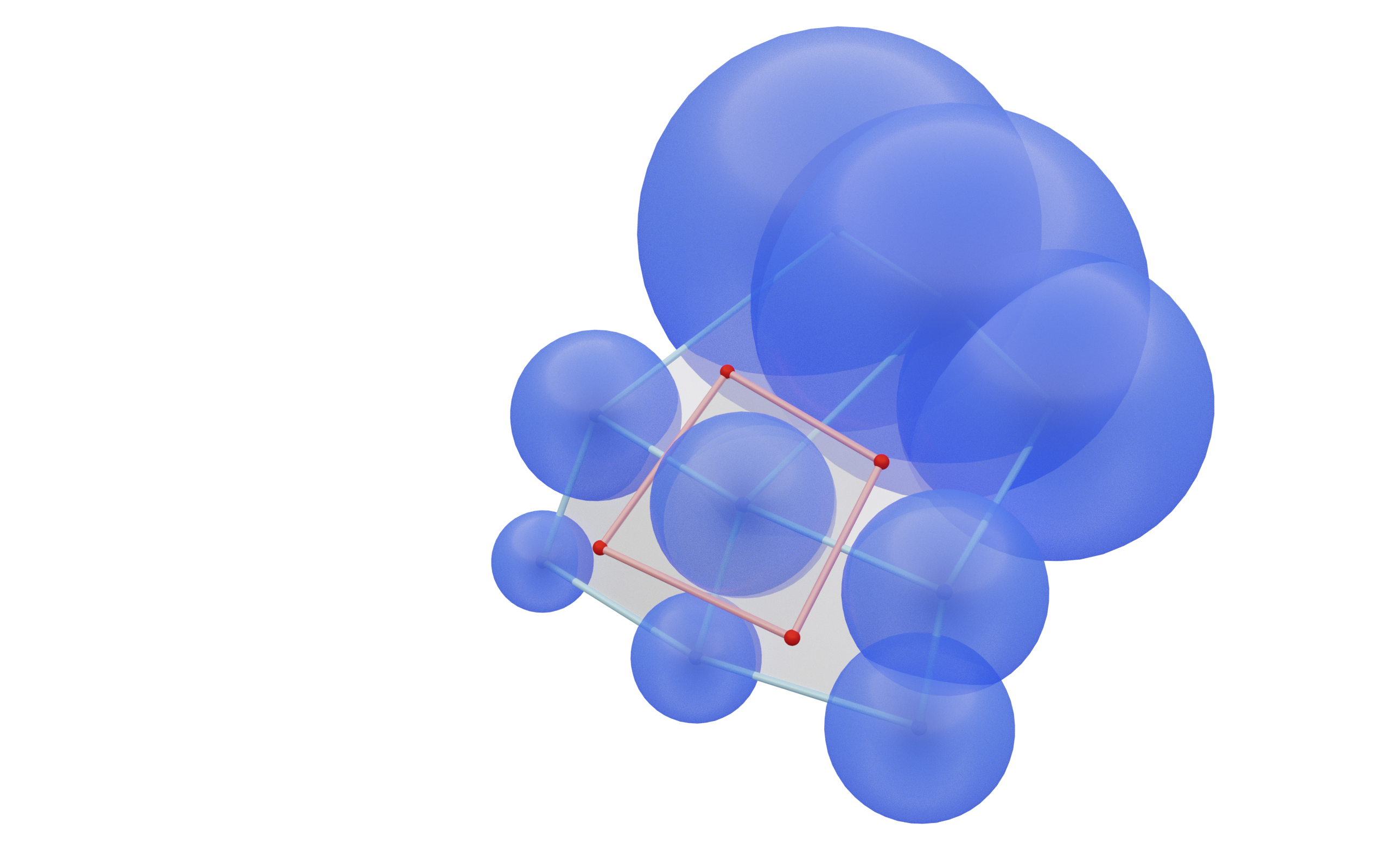
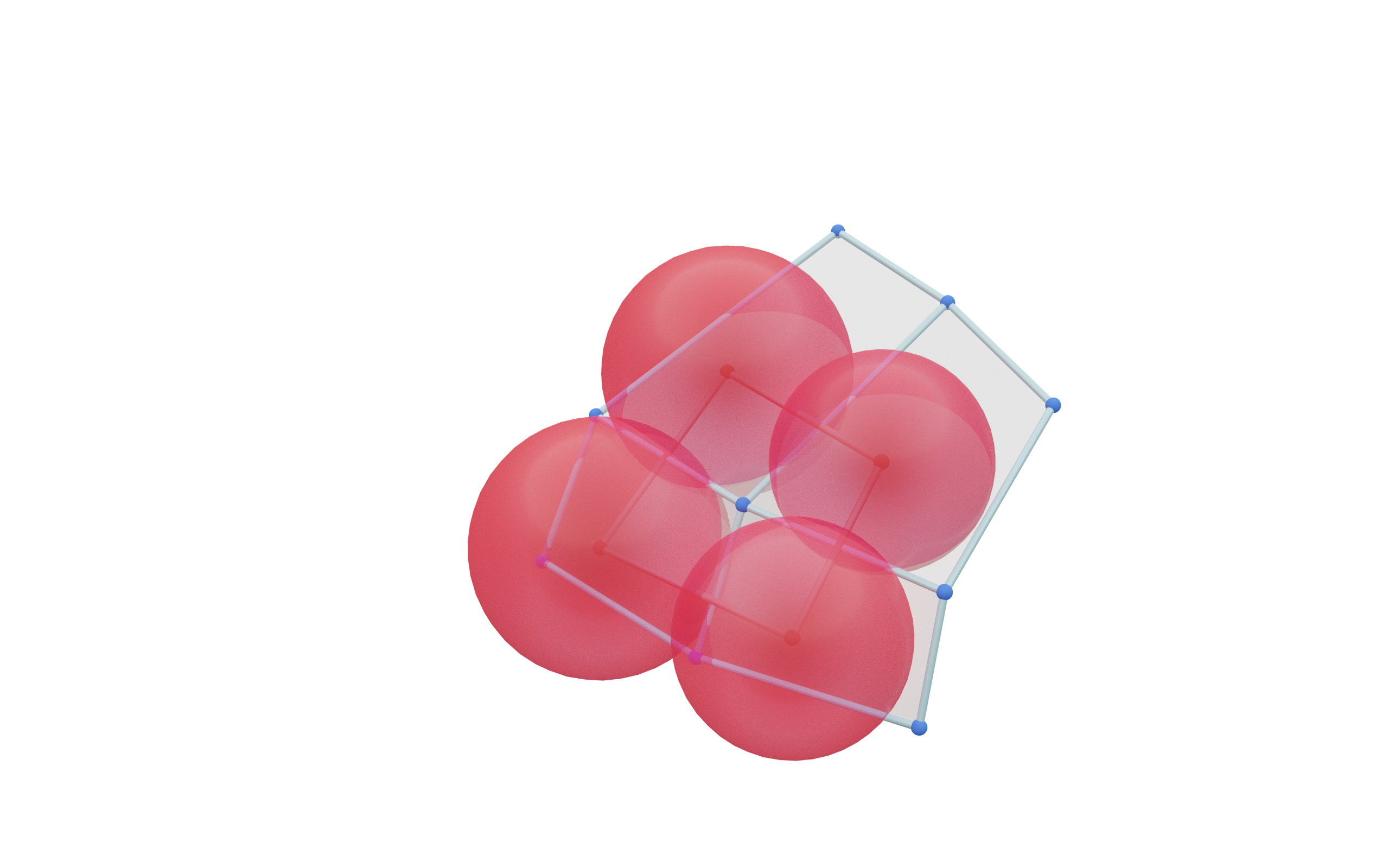
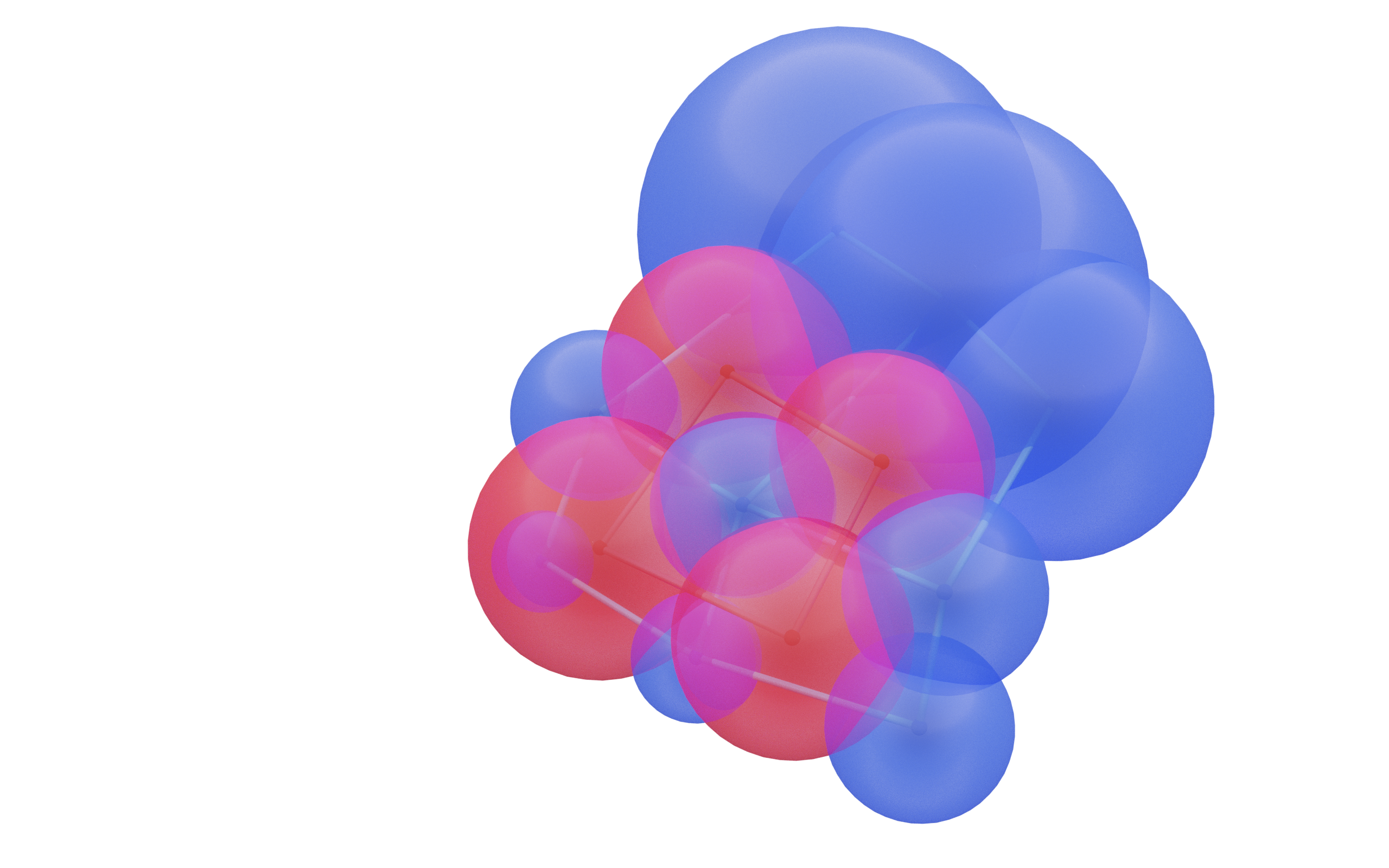


- The construction of $S$ has 1 degree of freedom (radius of one sphere).
- Orthogonal binets are Möbius invariant (apply Möbius transformations to the spheres).
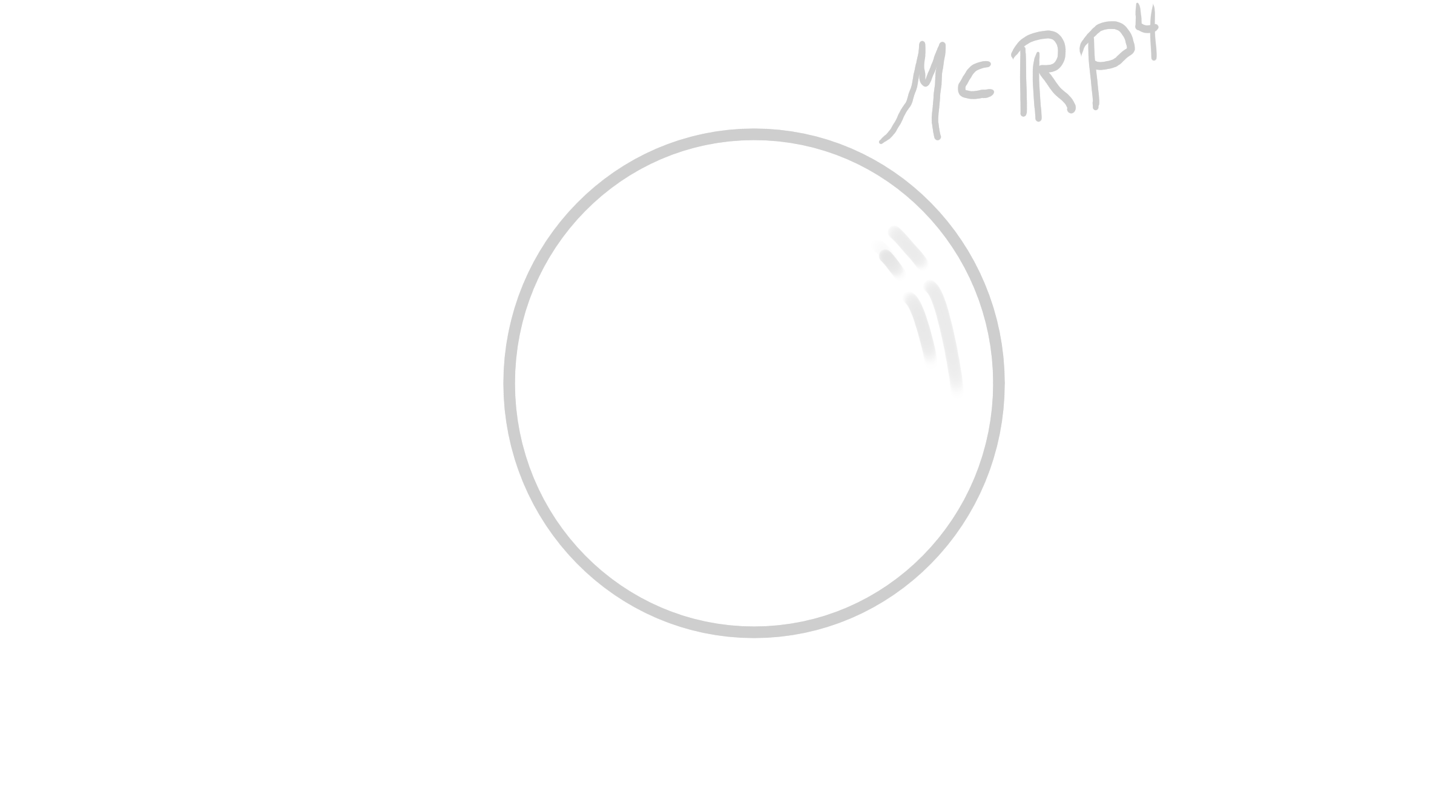
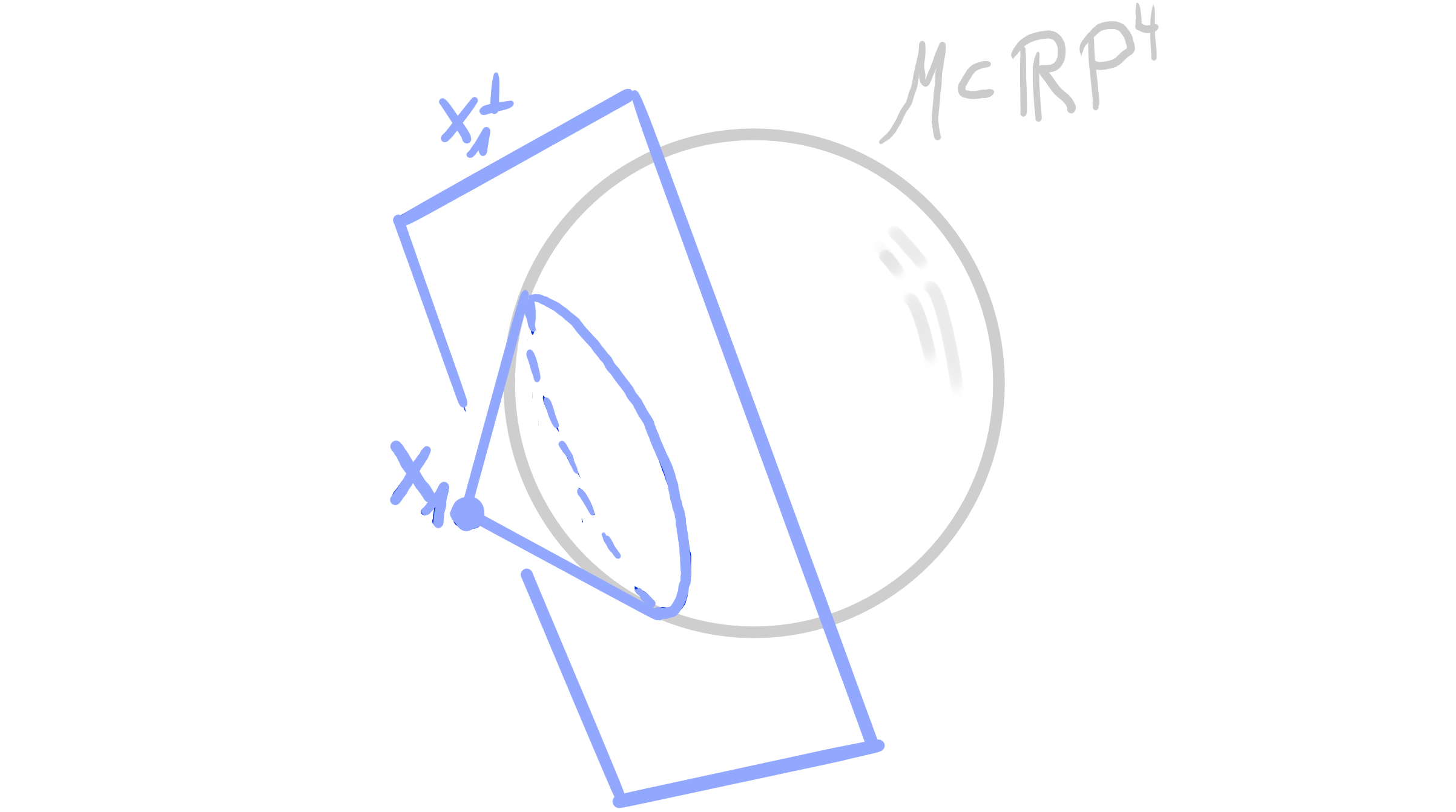
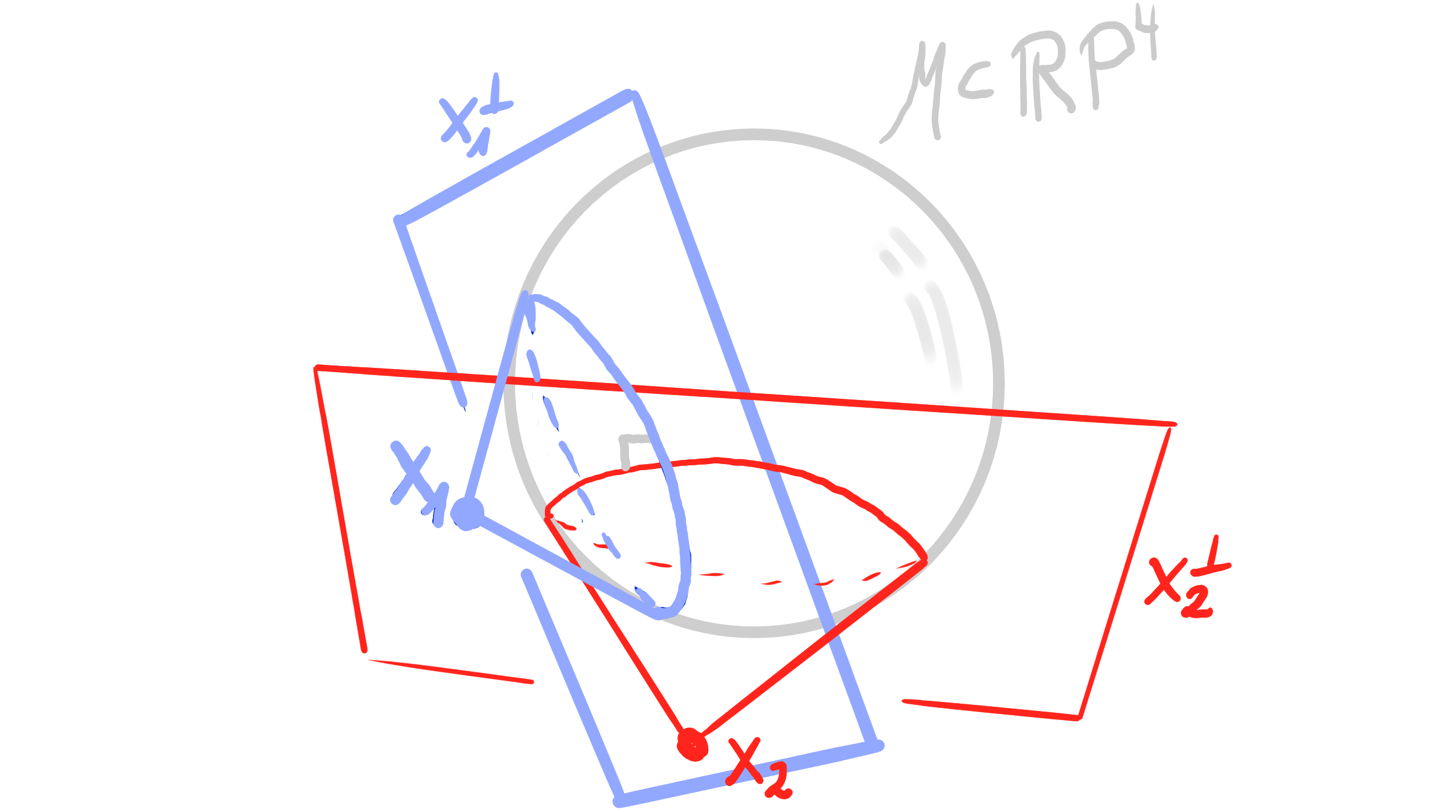
- a sphere $S \subset \mathcal{M}$ is represented by a point $\mathbf{x} \in \R\mathrm{P}^4$ via polarity: $\qquad S = \mathbf{x}^\perp \cap \mathcal{M}$
- $ S_1 \perp S_2 \quad \Leftrightarrow \quad \mathbf{x}_1 \perp \mathbf{x}_2 \quad \Leftrightarrow \quad \langle x_1, x_2 \rangle_{\mathcal{M}} = 0 $
|
Theorem:
Let $~ b : D \rightarrow \R^3\,$ be an orthogonal binet. Then there exists a lift $~b_{\mathcal{M}} : D \rightarrow \R P^4$ such that \[ \begin{aligned} &\pi_{\mathbf{B}} \circ b_{\mathcal{M}}= b\\ &b_{\mathcal{M}}(v) \perp b_{\mathcal{M}}(f) \end{aligned} \] |
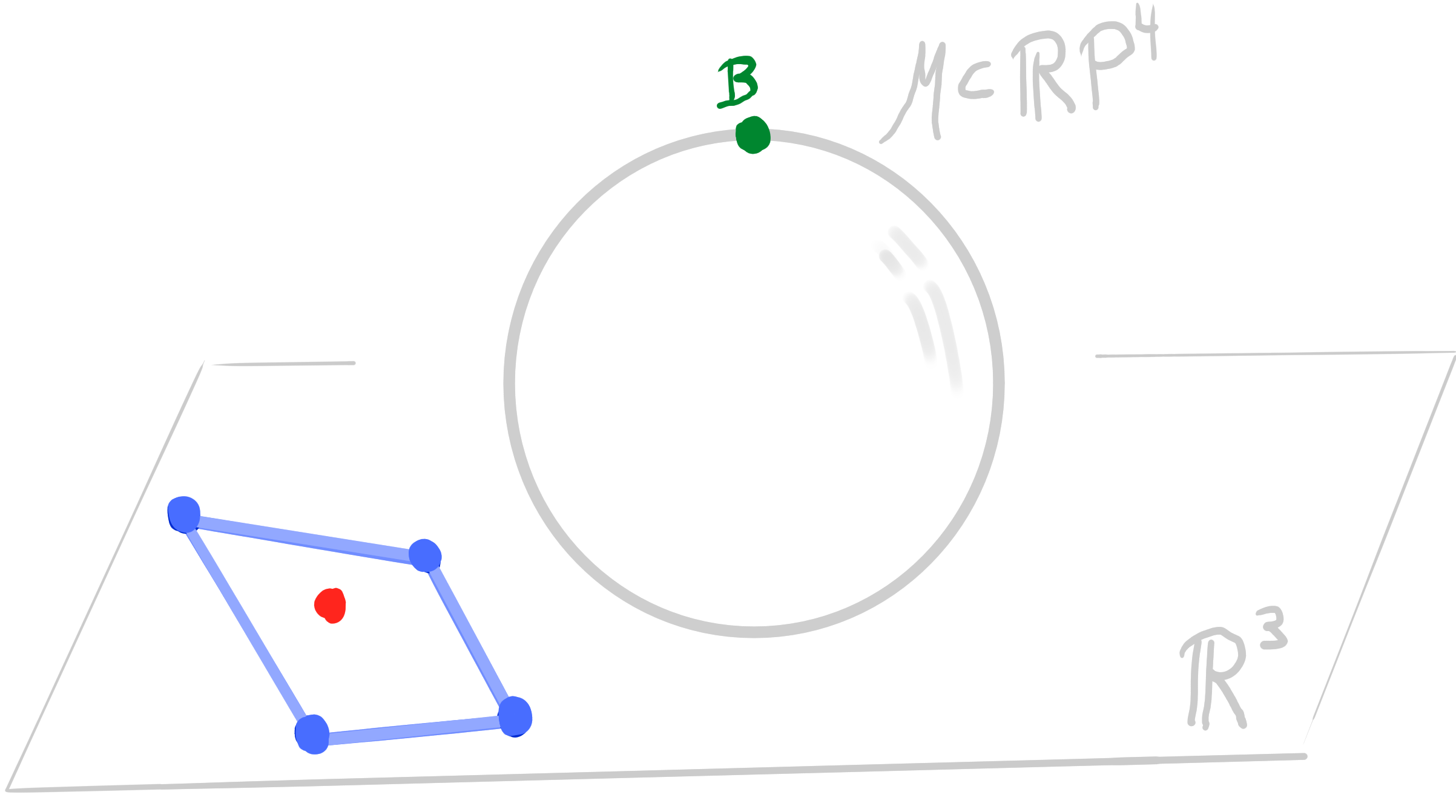
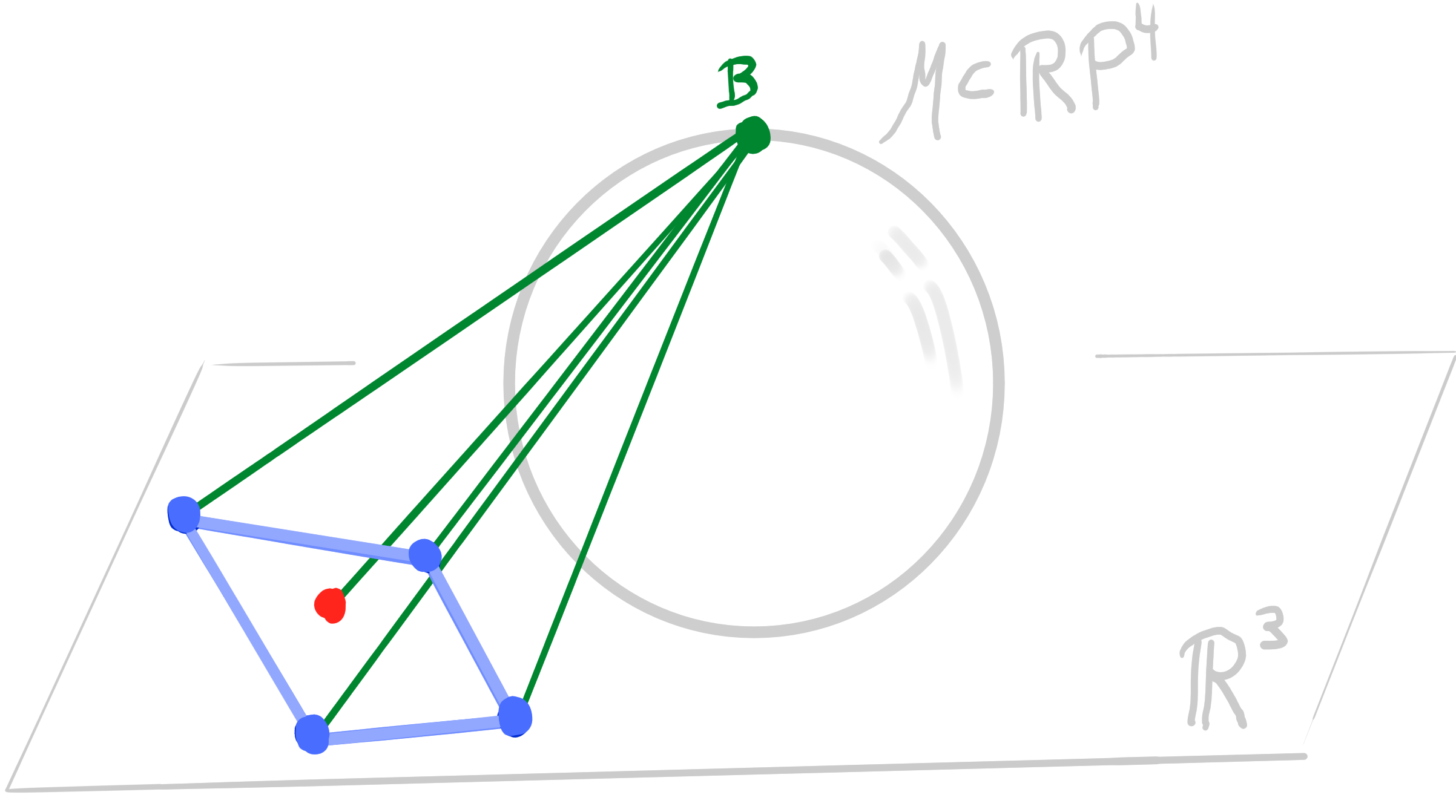
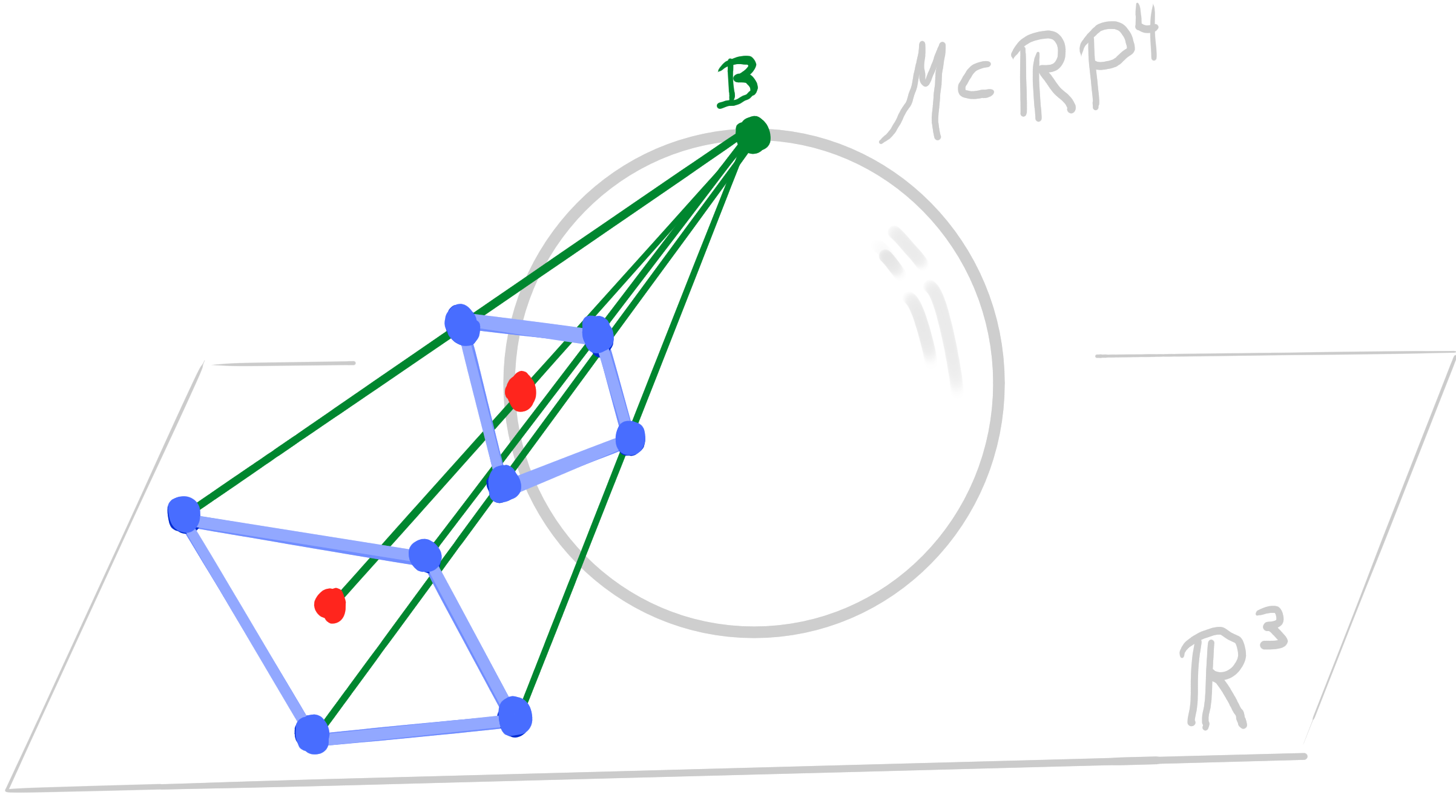
|
- Orthogonality in $\R^3$ becomes polarity in $\R\mathrm{P}^4$ in the lift.
- The Möbius lift has 1 degree of freedom (radius of one sphere).
- Points of the lift can lie inside $\mathcal{M}$ (spheres with imaginary radius).
Definition:
Let $\mathcal{Q} \subset \R\mathrm{P}^n$ be a quadric.
A polar binet is a map $~ b : D \rightarrow \R\mathrm{P}^n ~$ such that
for any two incident $v \in V$ and $f \in F$ the two points $b(v)$ and $b(f)$ are polar: \[ b(v) \perp b(f) \]
Let $\mathcal{Q} \subset \R\mathrm{P}^n$ be a quadric.
A polar binet is a map $~ b : D \rightarrow \R\mathrm{P}^n ~$ such that
for any two incident $v \in V$ and $f \in F$ the two points $b(v)$ and $b(f)$ are polar: \[ b(v) \perp b(f) \]
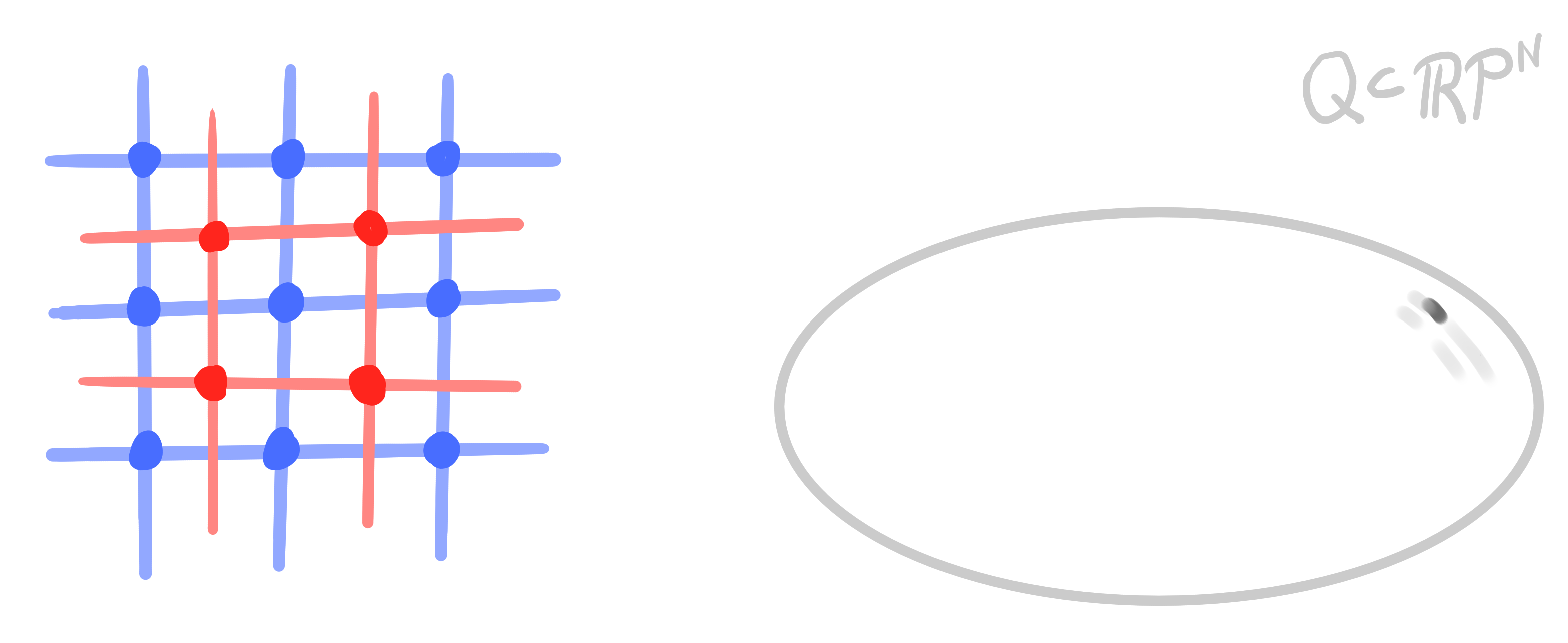

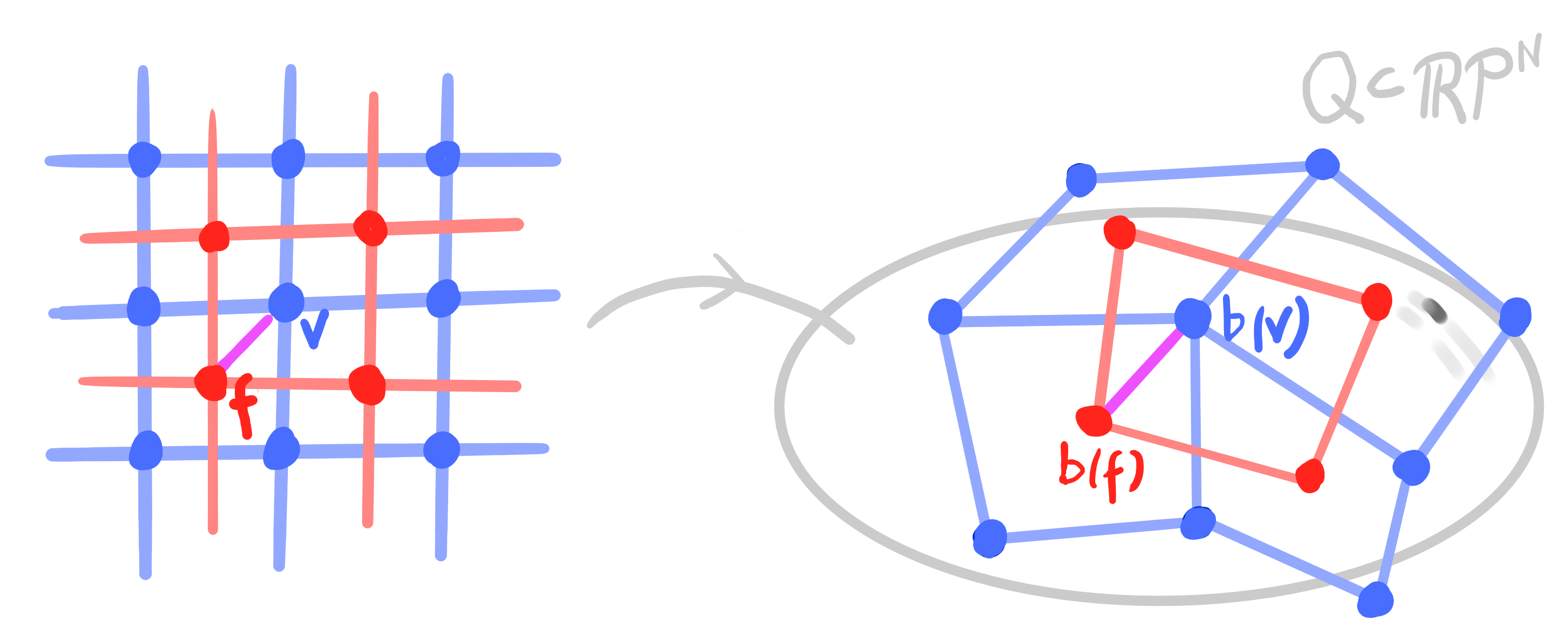
Conclusion:
Orthogonal binets in $\R^3$ can be lifted to polar binets in $\R\mathrm{P}^4$.
Vice versa, polar binets in $\R\mathrm{P}^4$ project to orthogonal binets in $\R^3$.
Orthogonal binets in $\R^3$ can be lifted to polar binets in $\R\mathrm{P}^4$.
Vice versa, polar binets in $\R\mathrm{P}^4$ project to orthogonal binets in $\R^3$.
A *net is a map
$~V \rightarrow \mathrm{Planes}(\R\mathrm{P}^n)~$
such that adjacent planes intersect in a line.
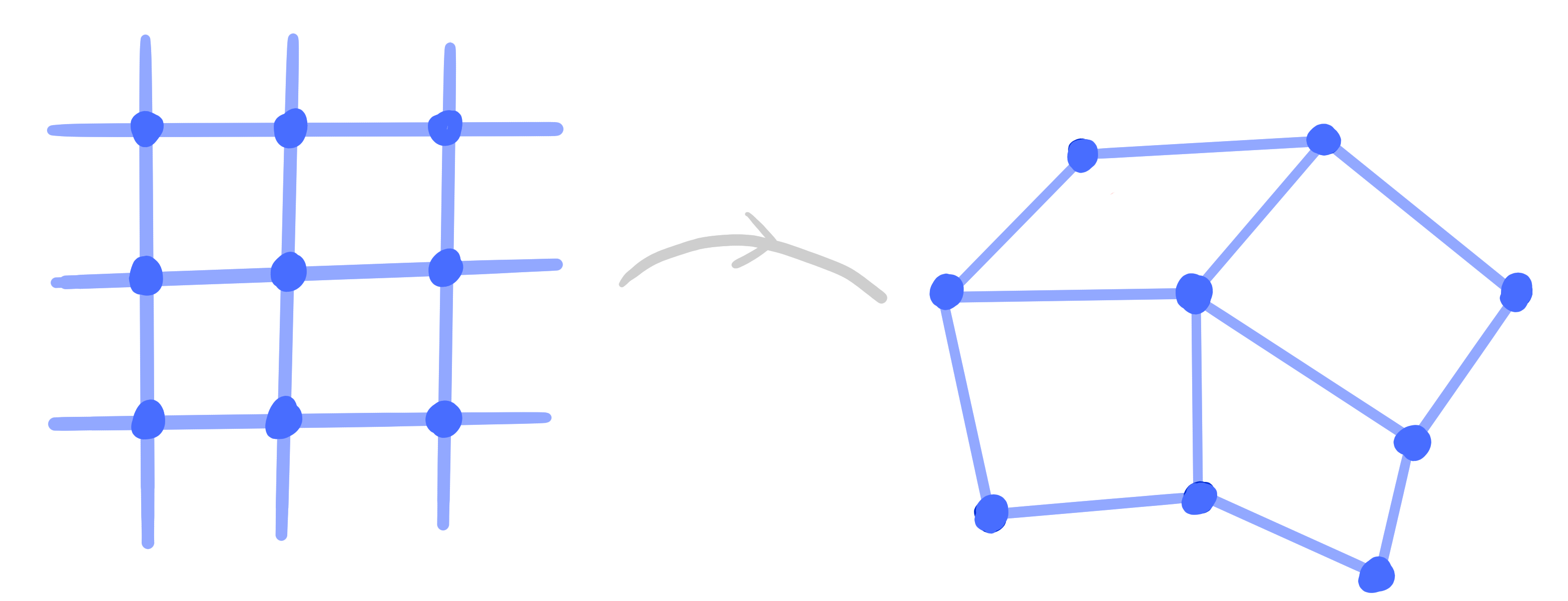
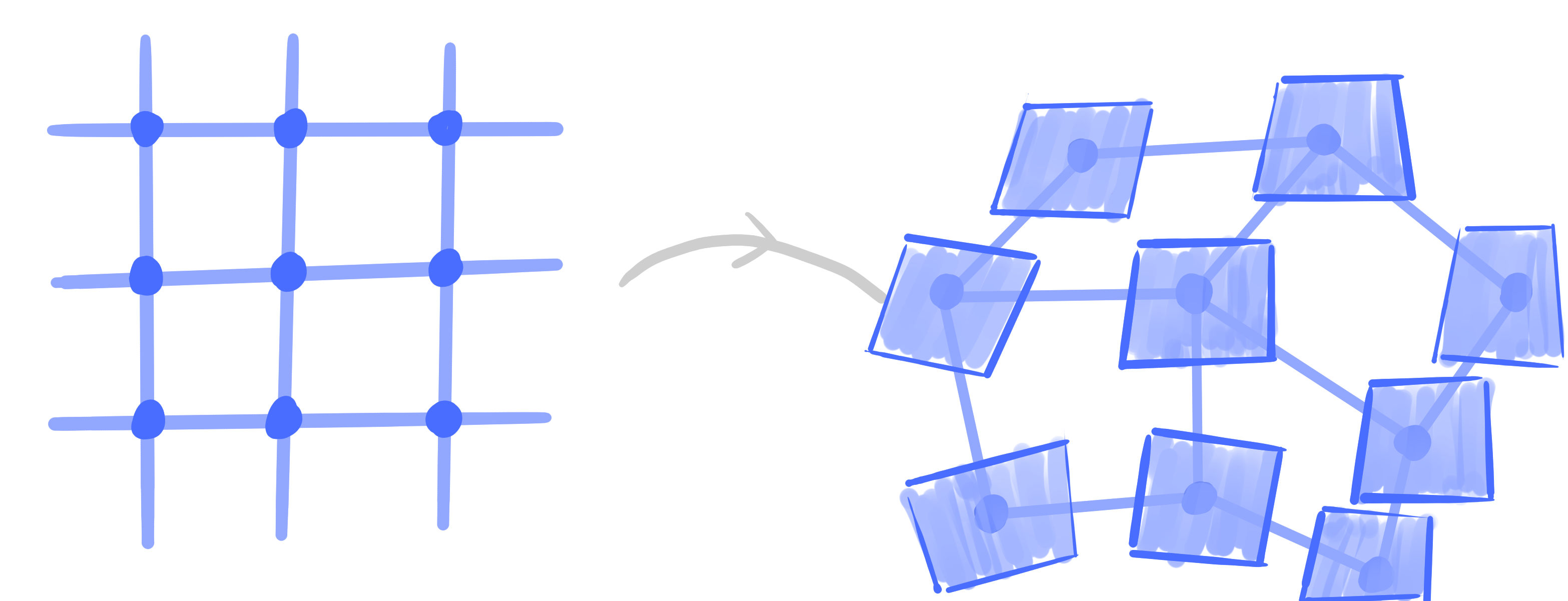
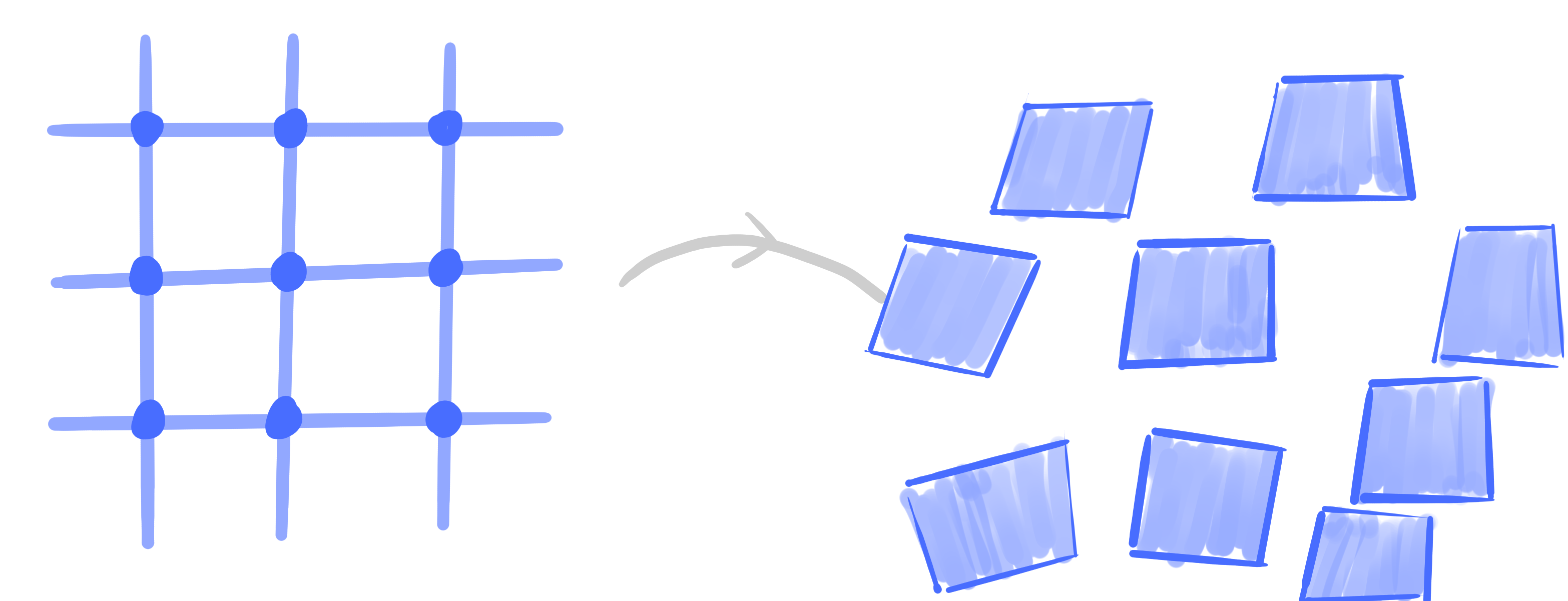
Definition
A bi*net is a map $~D \rightarrow \mathrm{Planes}(\R\mathrm{P}^n)~$ such that $b|_V$ and $b|_F$ are *nets.
A bi*net is a map $~D \rightarrow \mathrm{Planes}(\R\mathrm{P}^n)~$ such that $b|_V$ and $b|_F$ are *nets.
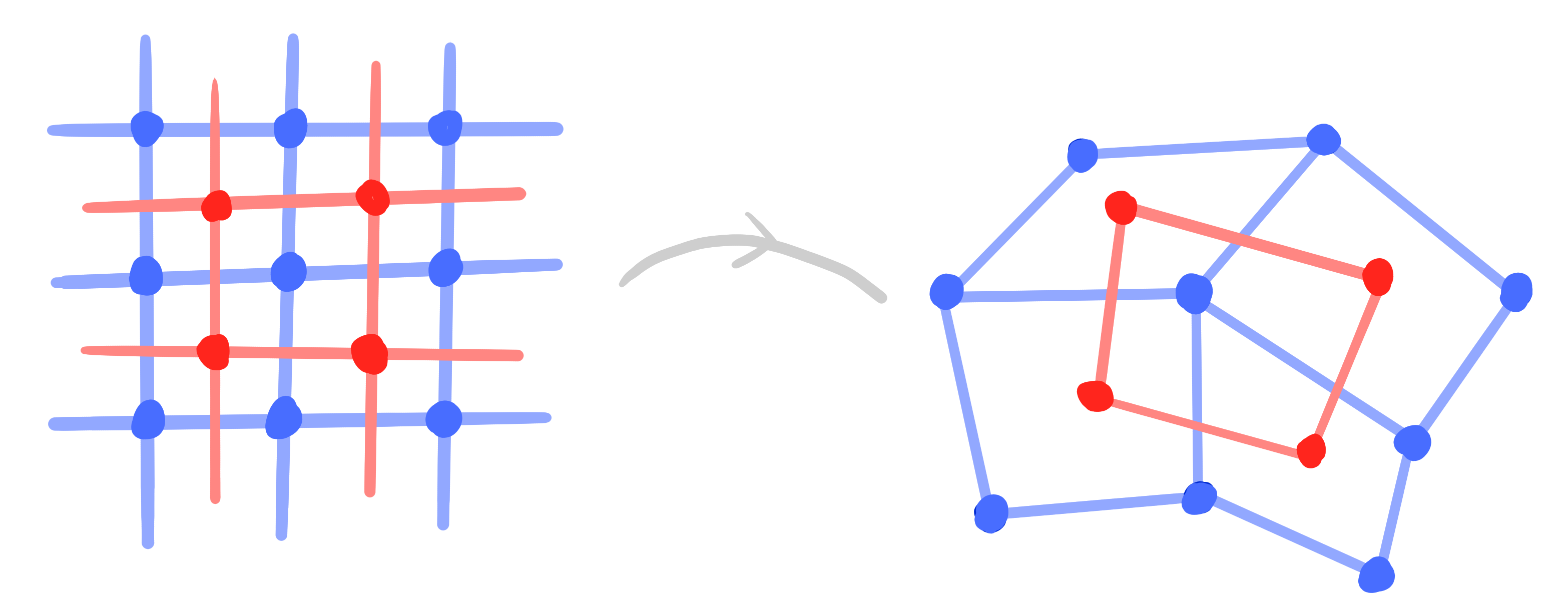
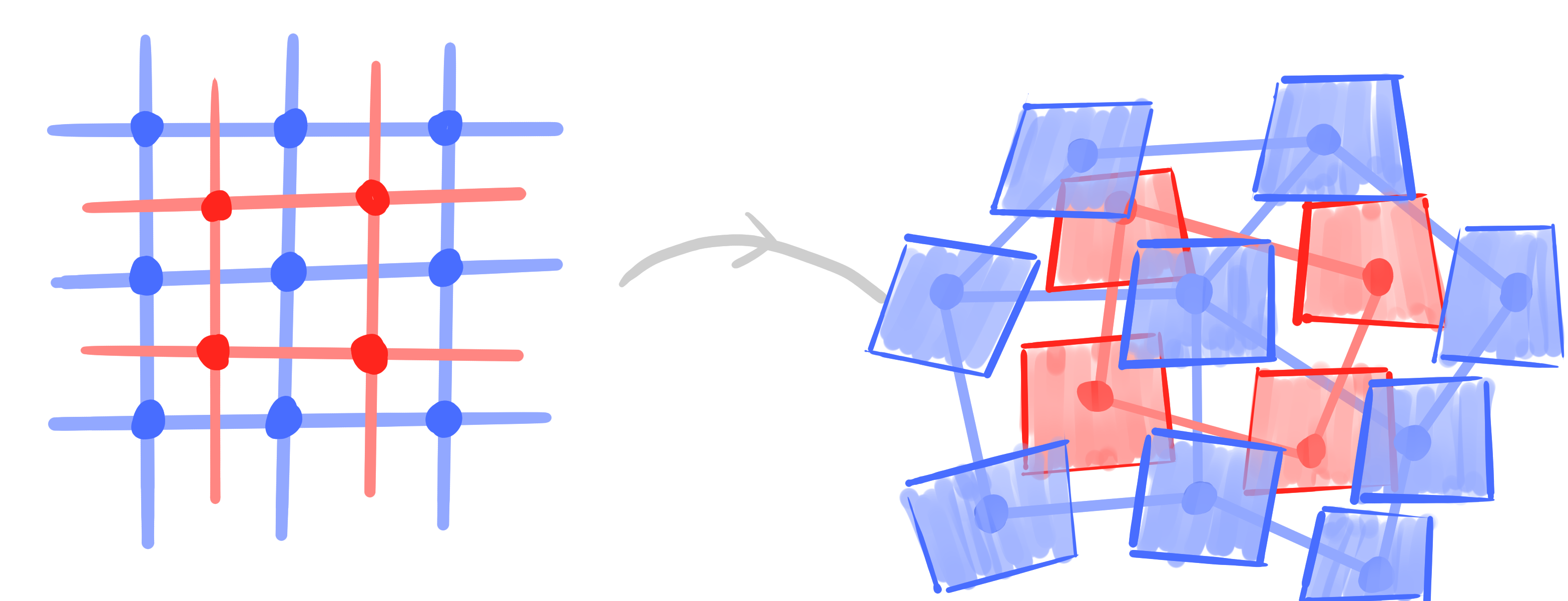
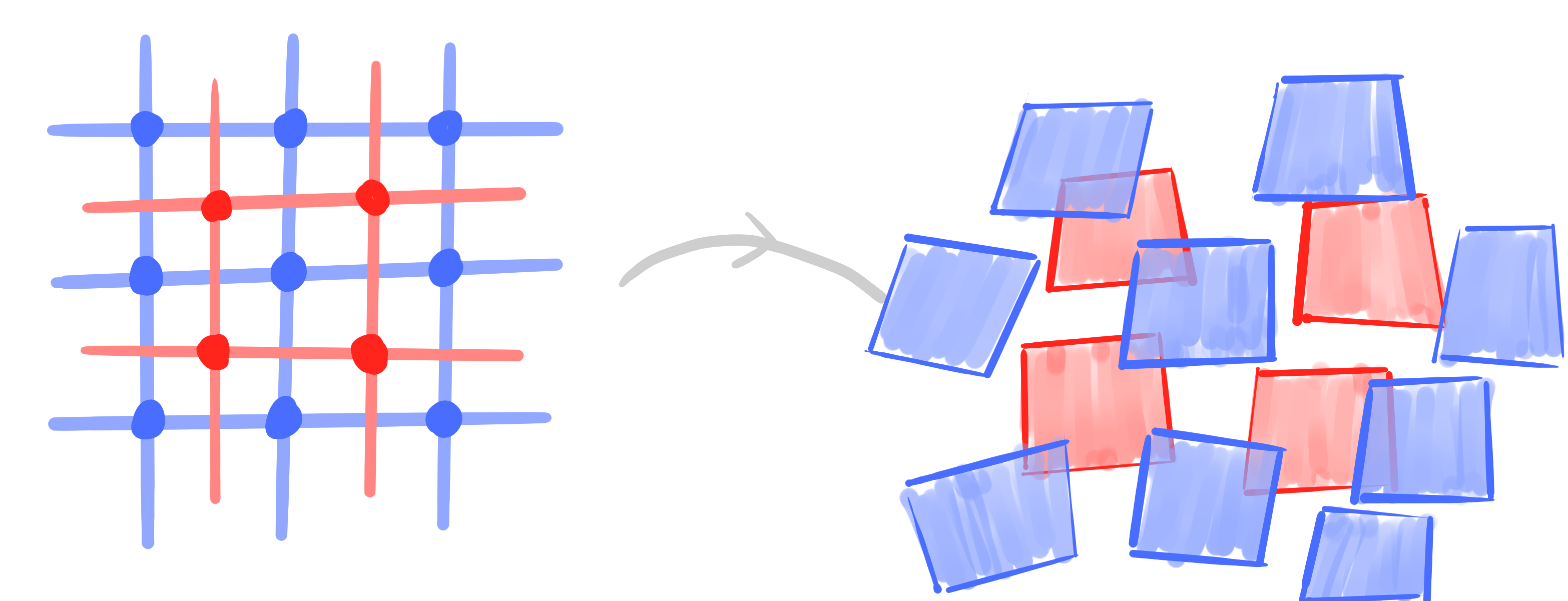
Definition:
A bi*net $\quad b : D \rightarrow \mathrm{Planes}(\R^3) \quad$ is called orthogonal
$\quad \Leftrightarrow \quad b(v) \cap b(v') \perp b(f) \cap b(f') \quad$ for all crosses $\quad (v, f, v', f') \in C$
$\quad \Leftrightarrow \quad b(v) \cap b(v') \perp b(f) \cap b(f') \quad$ for all crosses $\quad (v, f, v', f') \in C$
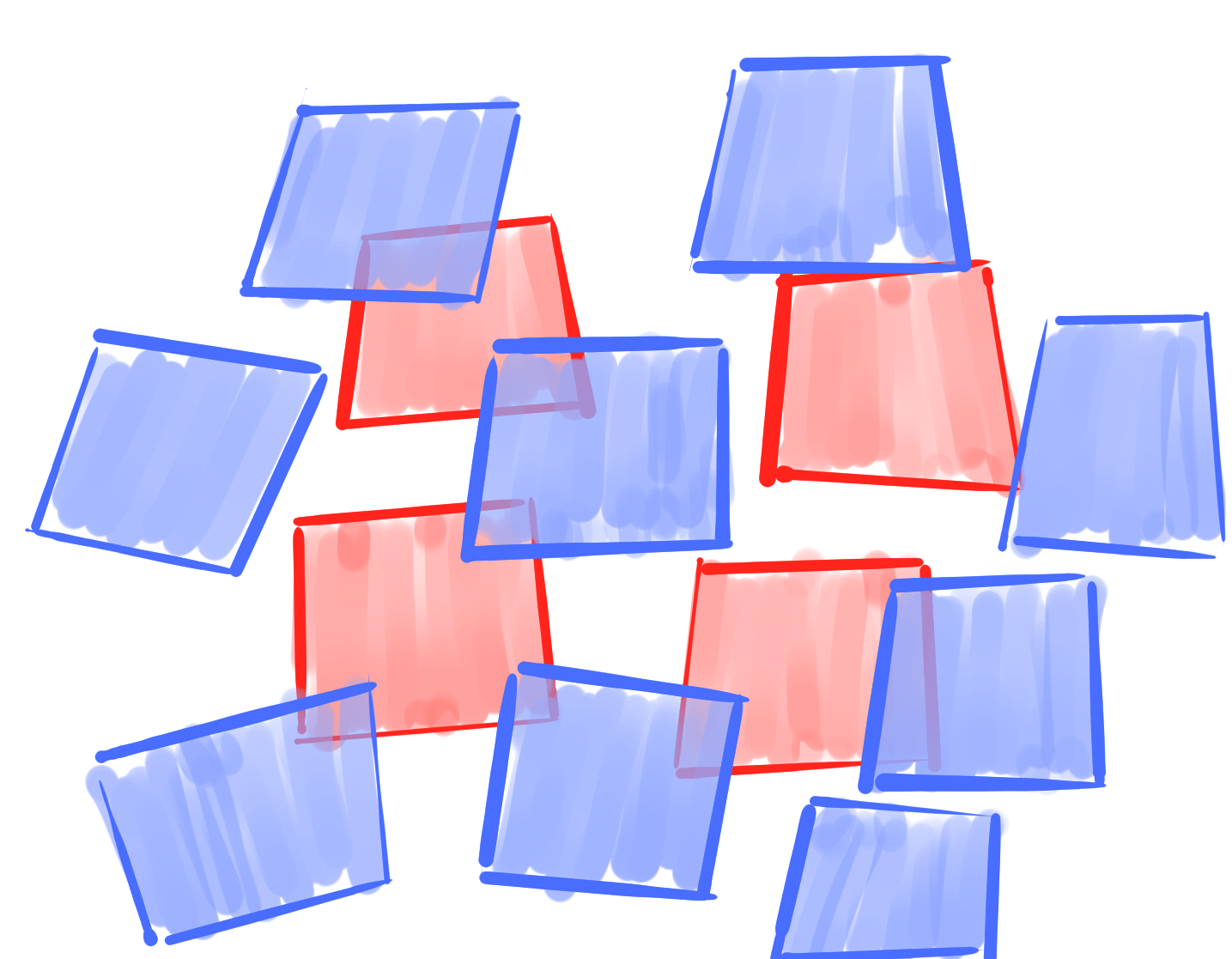
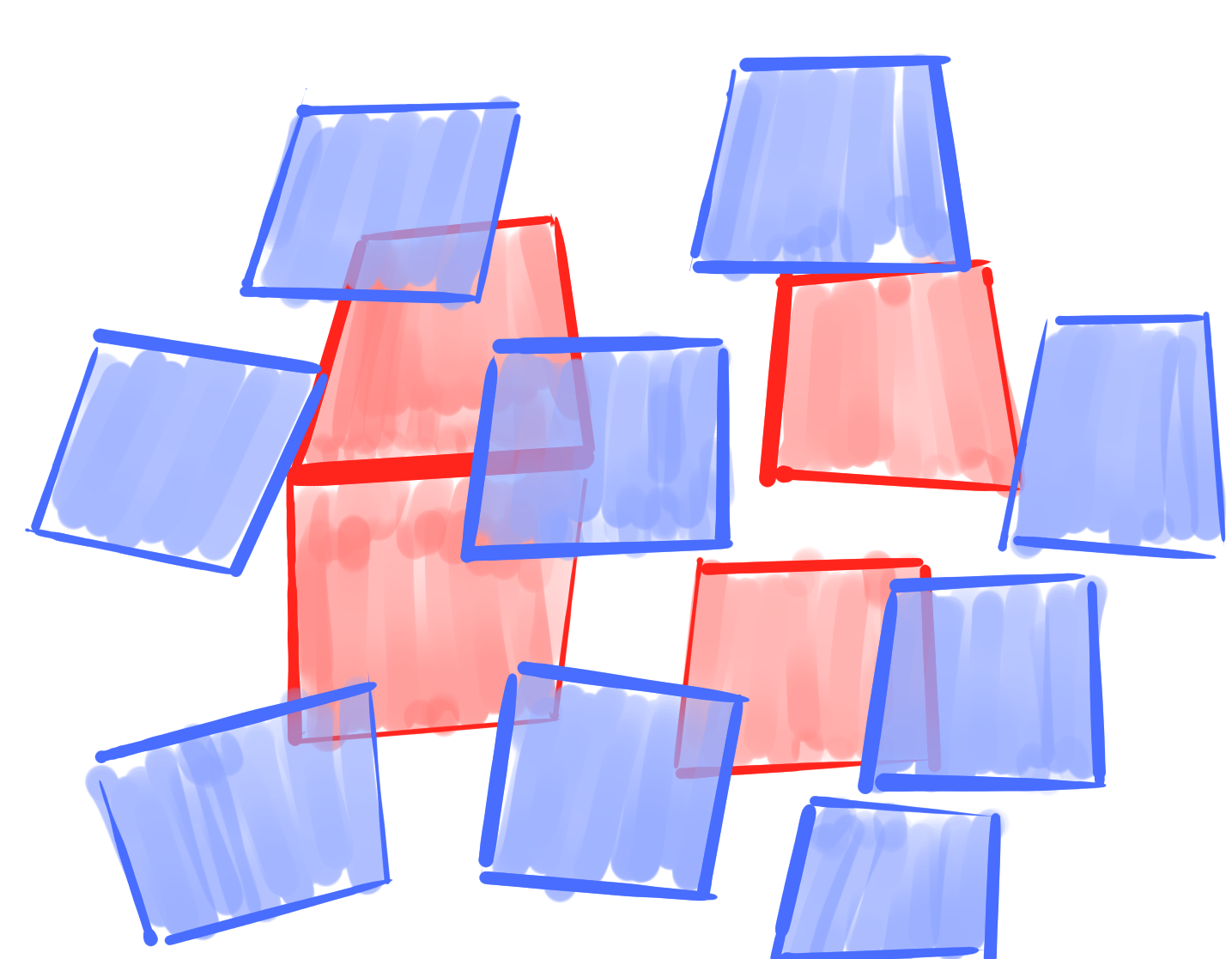
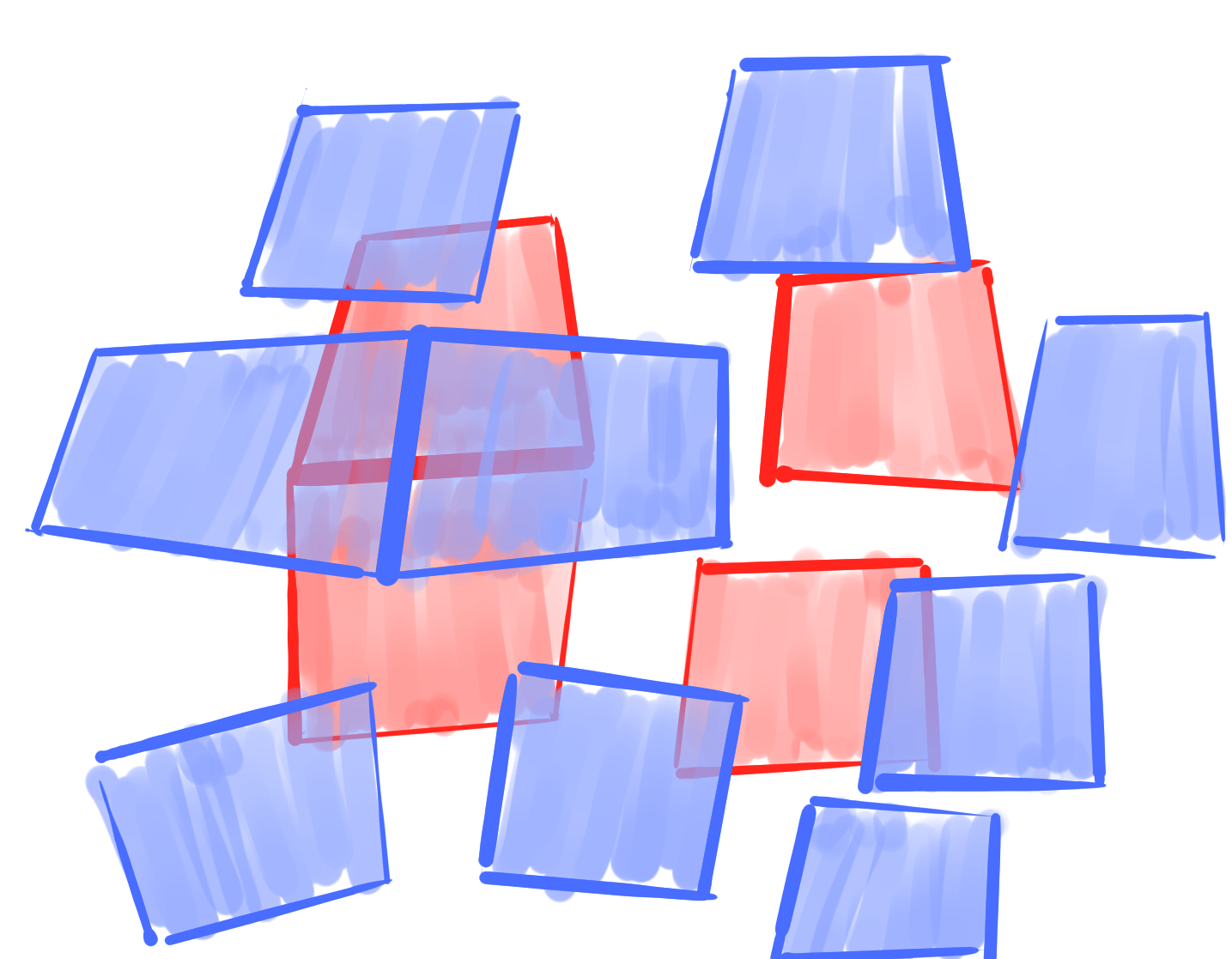
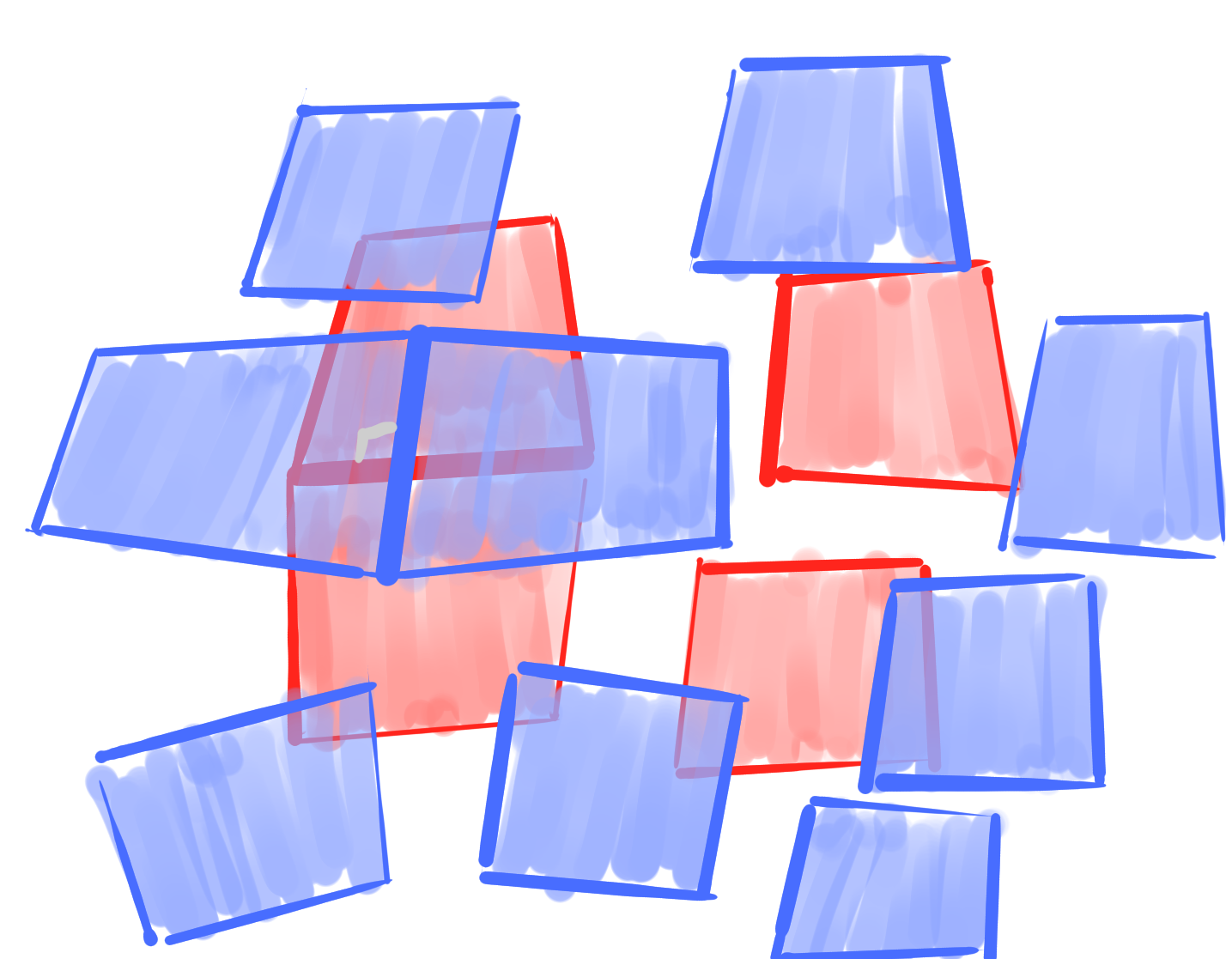
Invariances:
- independent translation of $b|_V$ and $b|_F$
- similarity transformations
- a priori, not Laguerre invariant
|
Theorem:
Let $~b : D \rightarrow \mathrm{Planes}(\R^3)$ be an orthogonal bi*net. Then there exists a lift $~b_{\mathcal{B}} : D \rightarrow \R\mathrm{P}^4$ such that \[ \begin{aligned} &\pi_{\mathbf{M}} \circ b_{\mathcal{B}}= b\\ &b_{\mathcal{B}}(v) \perp b_{\mathcal{B}}(f) \end{aligned} \] |
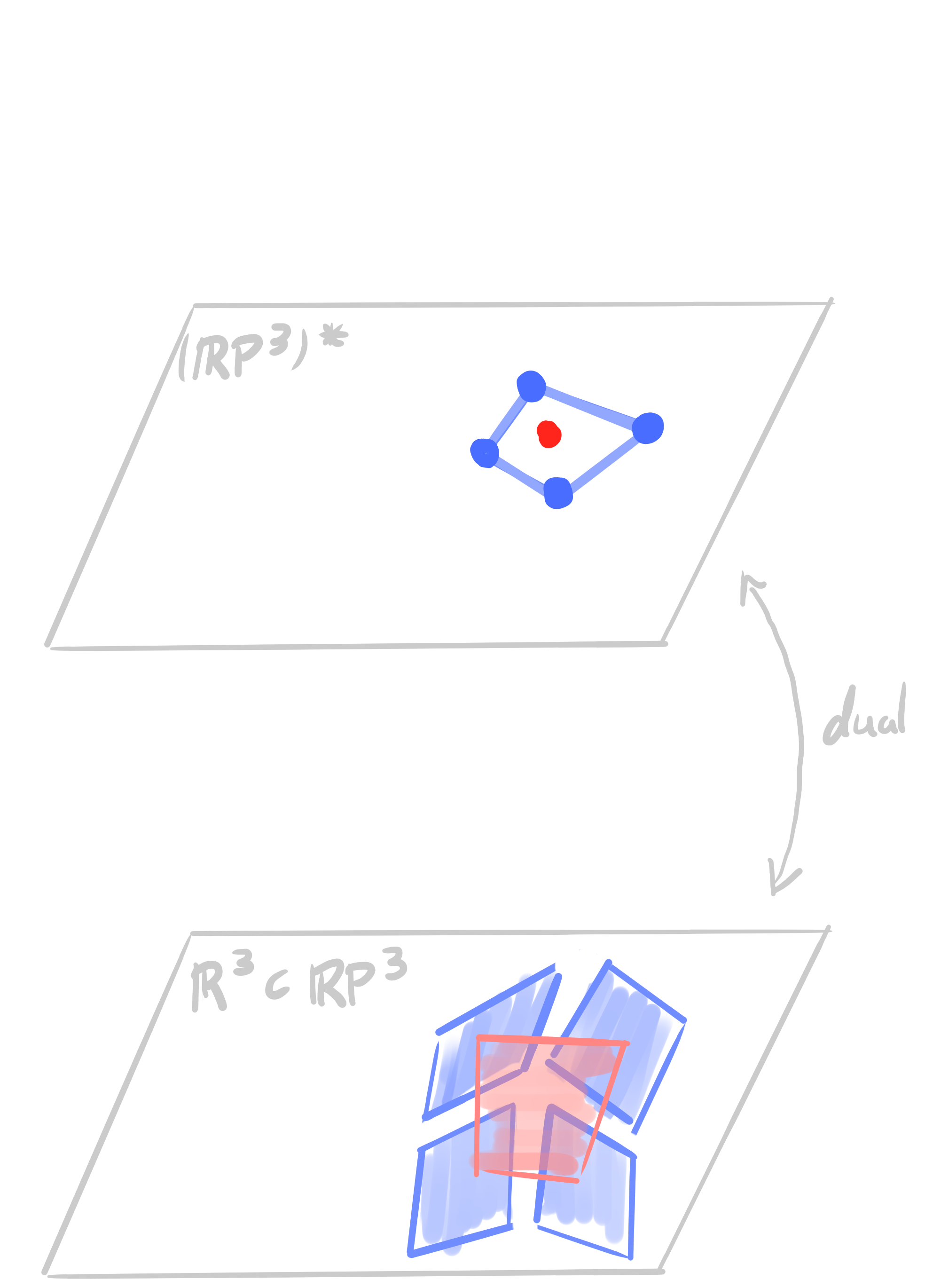
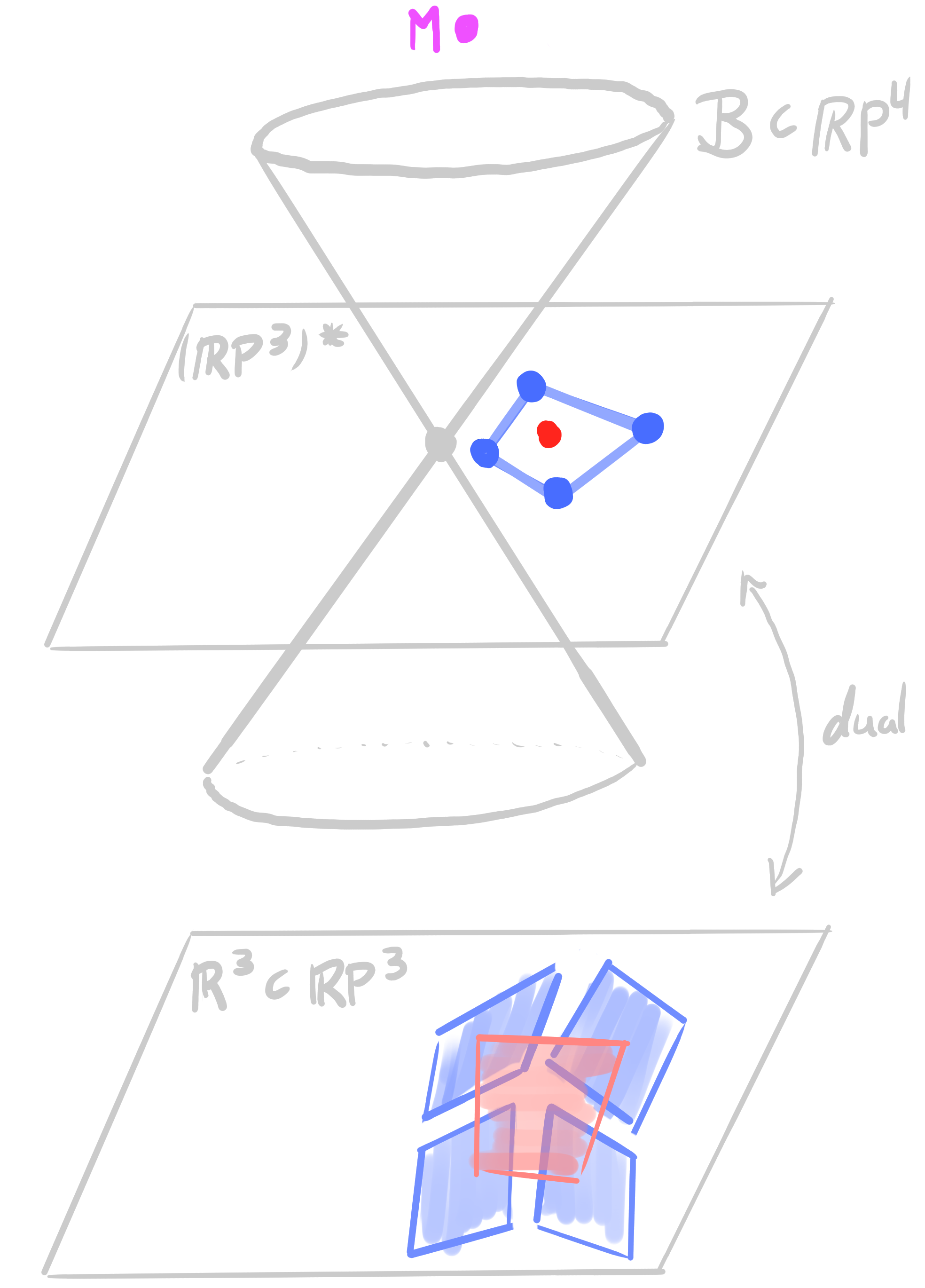
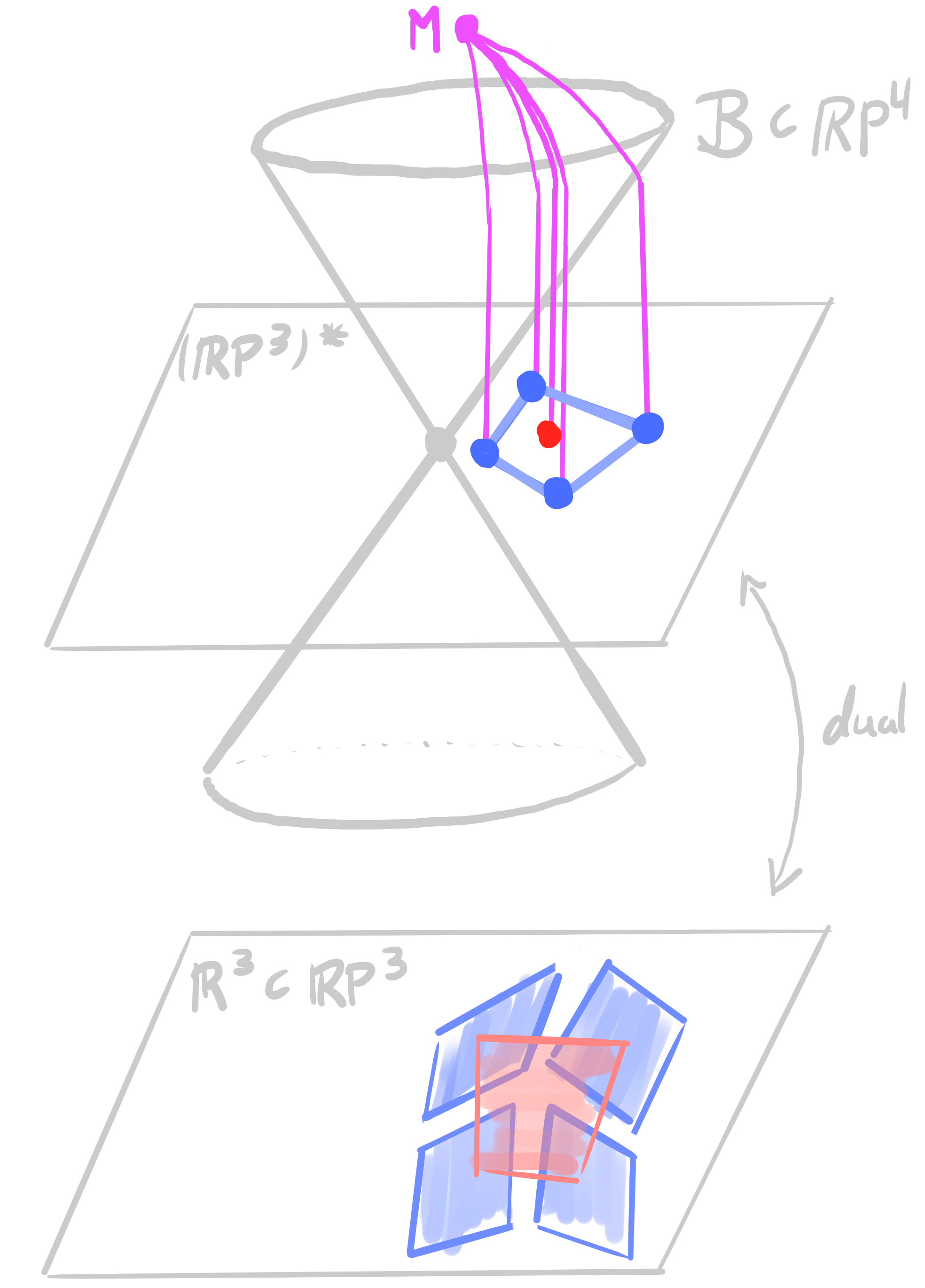
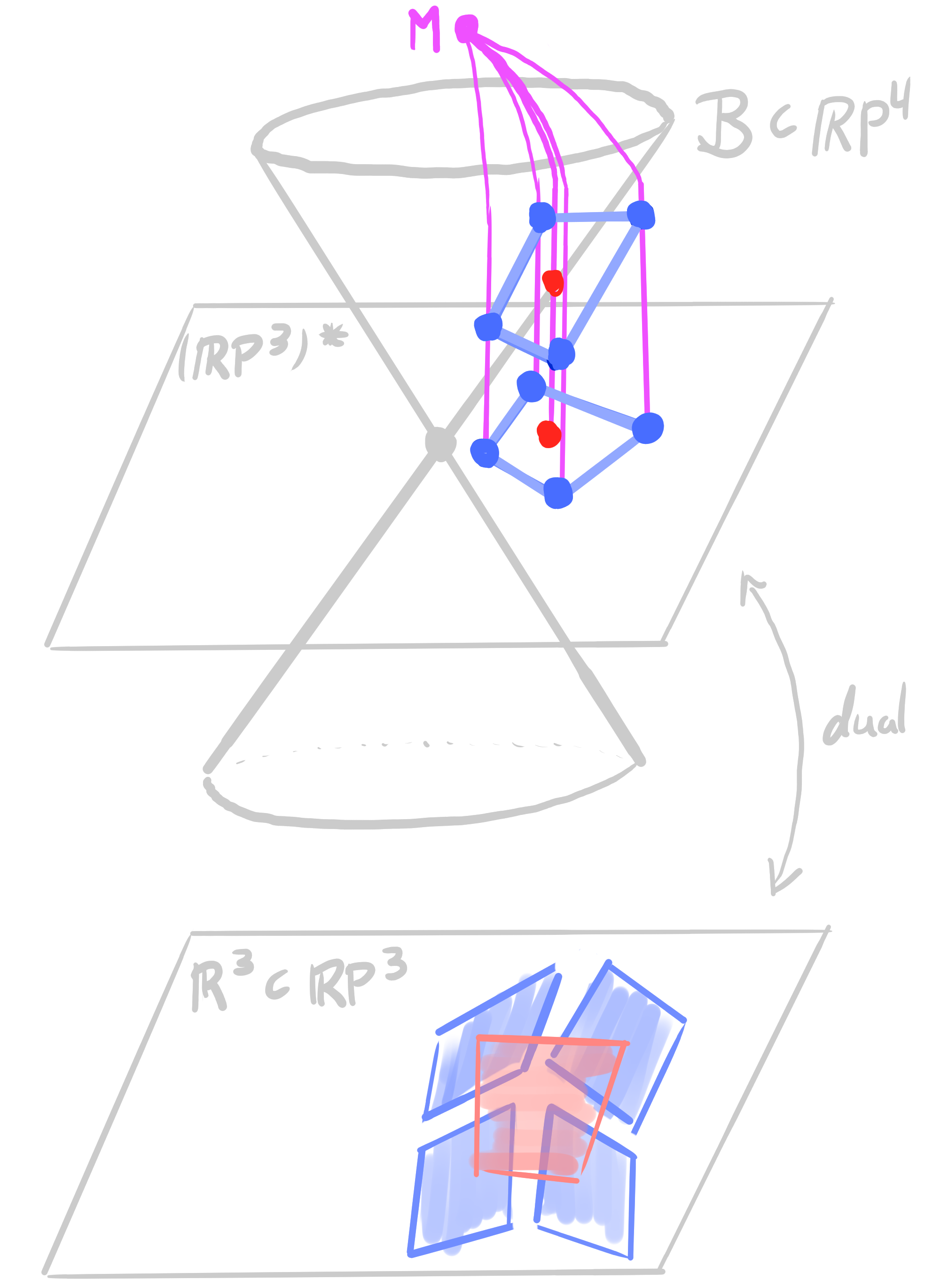
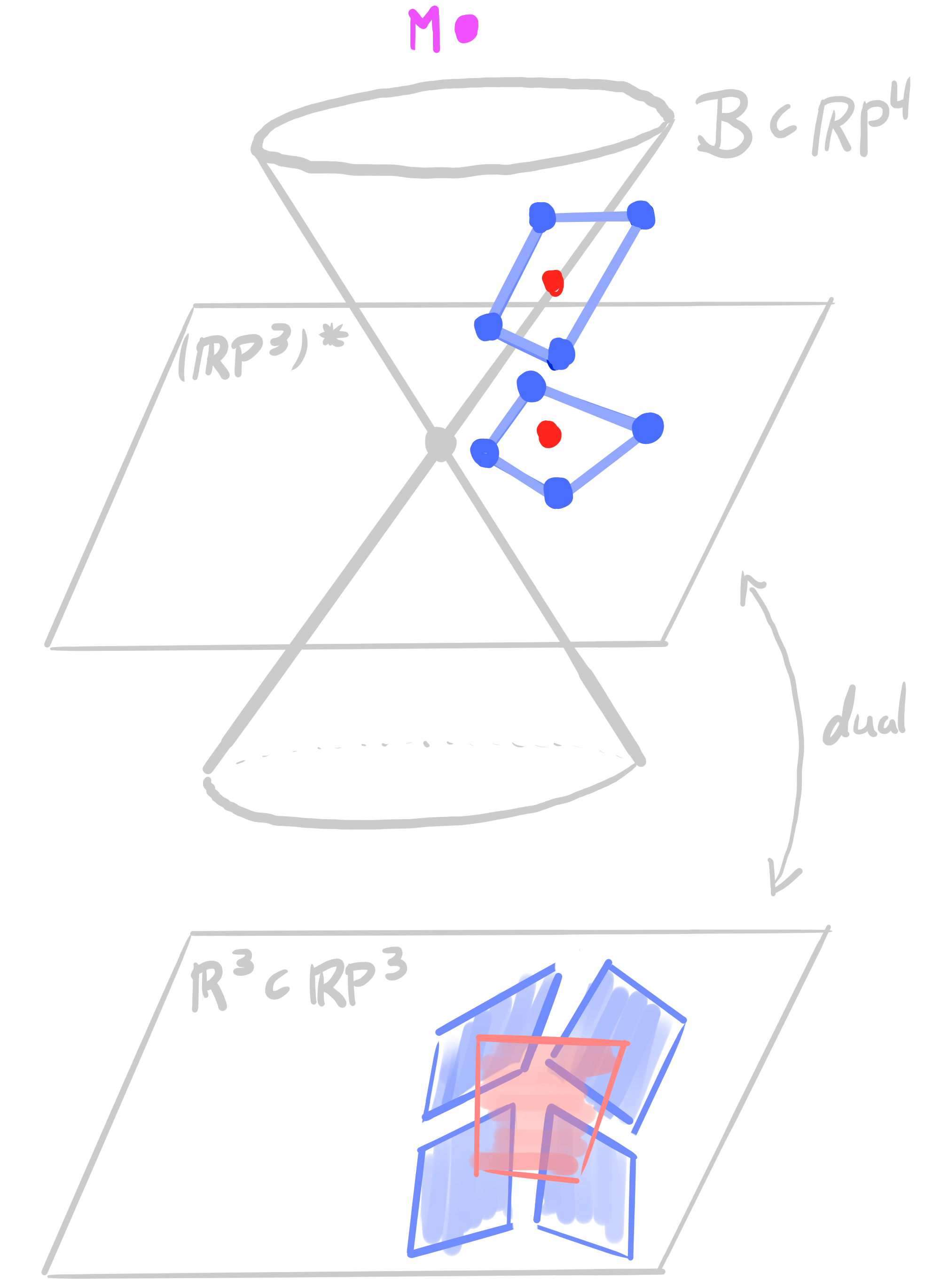
|
Conclusion:
Orthogonal bi*nets in $\R^3$ can be lifted to polar binets in $\R\mathrm{P}^4$.
Vice versa, polar binets in $\R\mathrm{P}^4$ project to orthogonal bi*nets in $\R^3$.
Orthogonal bi*nets in $\R^3$ can be lifted to polar binets in $\R\mathrm{P}^4$.
Vice versa, polar binets in $\R\mathrm{P}^4$ project to orthogonal bi*nets in $\R^3$.
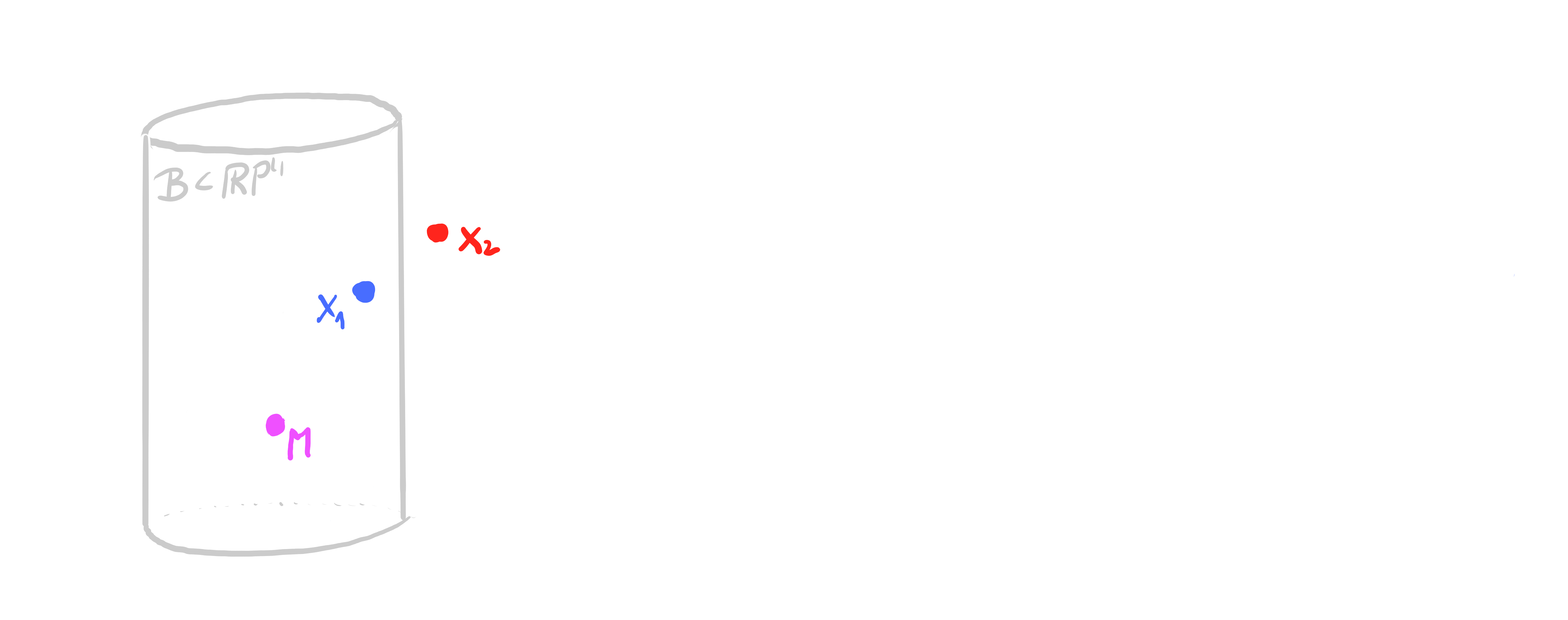
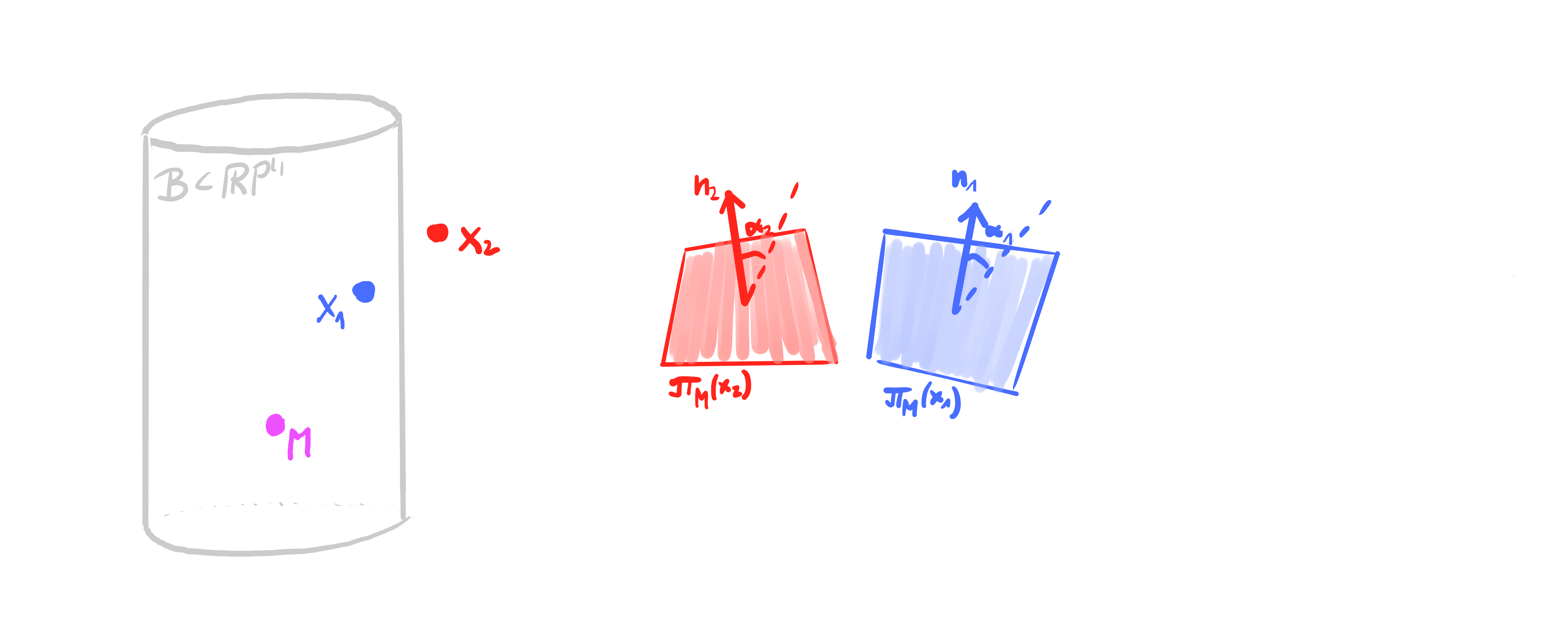
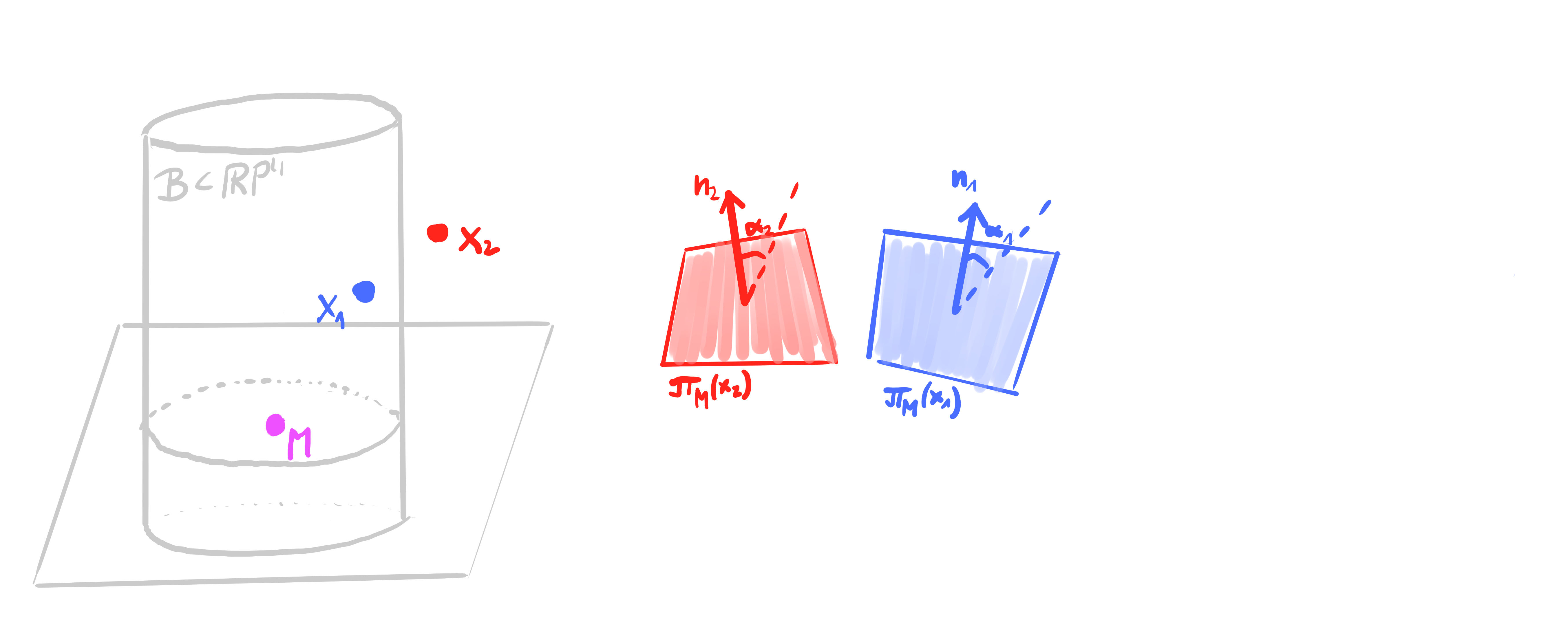
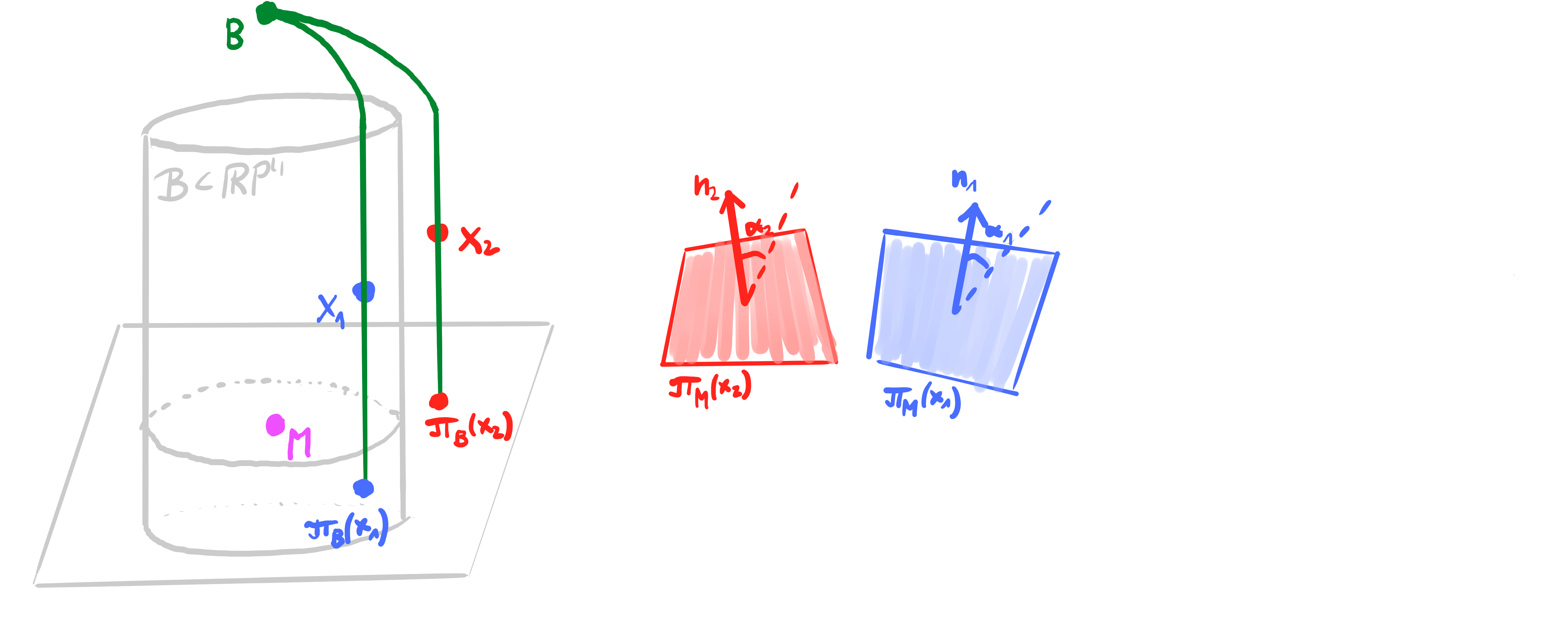
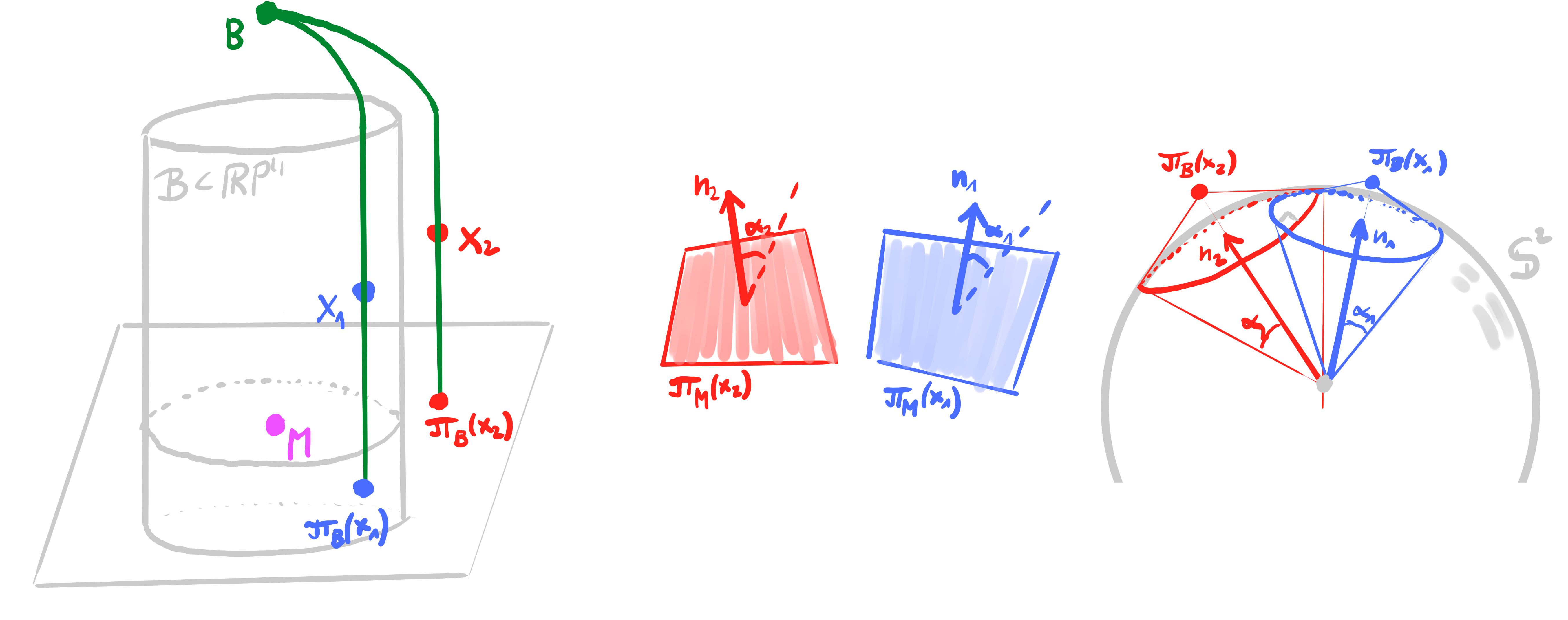
- a point outside $\mathcal{B}$ represents a plane with an angle
- $\mathbf{x}_1 \perp \mathbf{x}_2 \quad \Leftrightarrow \quad \pi_{\mathbf{B}(\mathbf{x}_1)} \perp \pi_{\mathbf{B}(\mathbf{x}_2)} \quad$ polar Gauss map
- orthogonal circles on $\mathbb{S}^2$
|
Definition: A binet $~ b : D \rightarrow \R^3 ~$ is called conjugate $\Leftrightarrow$ $b|_V$ and $b|_F$ are Q-nets. |
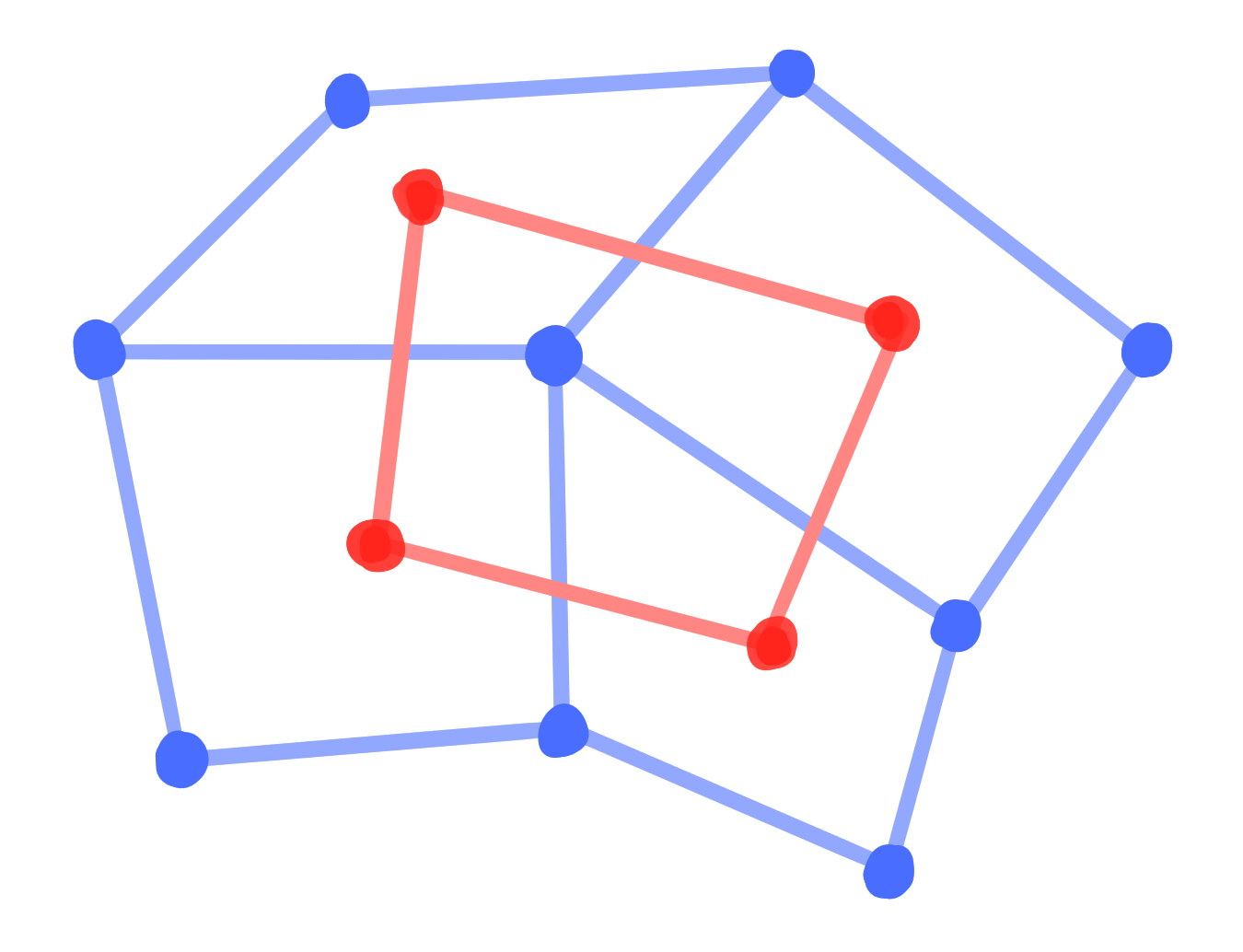
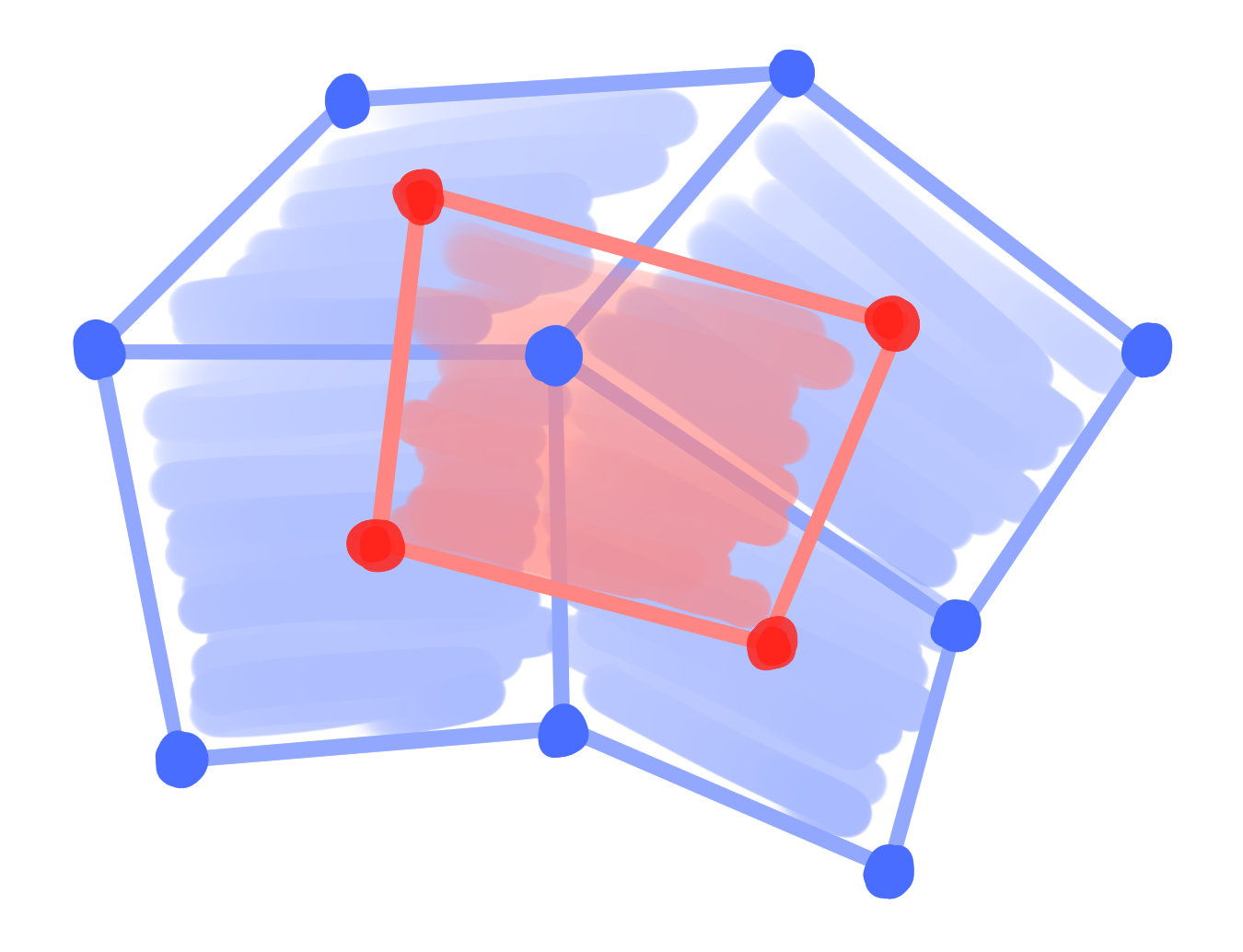
|
|
Definition: A bi*net $~ b : D \rightarrow \mathrm{Planes}(\R^3) ~$ is called conjugate $\Leftrightarrow$ $b|_V$ and $b|_F$ are Q*-nets. |
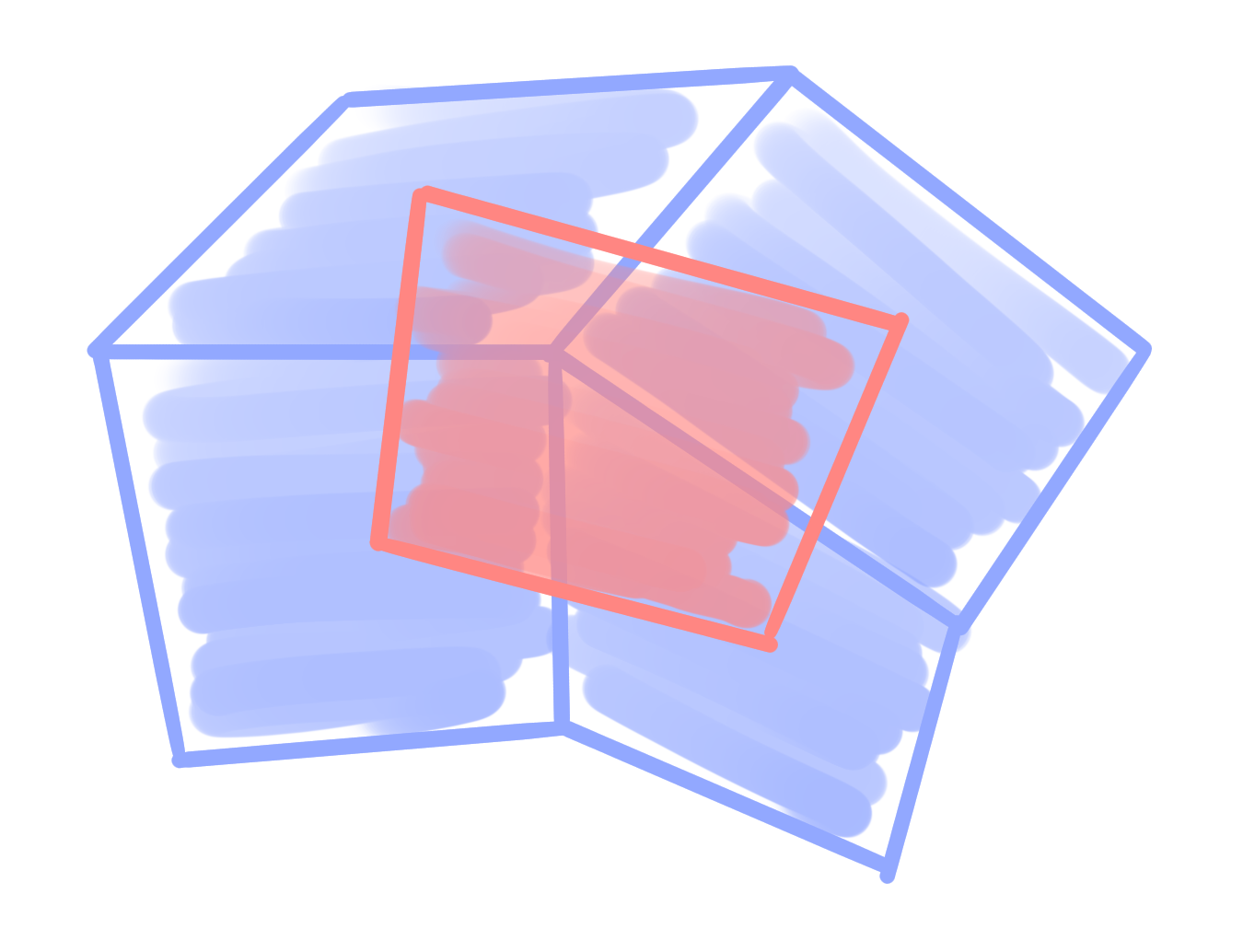

|
-
Every conjugate binet $b$ defines a conjugate bi*net $\square b$ by
$ \qquad \square b(d) = \bigvee \{ b(d') ~|~ d' \in D, ~ d' \text{ incident to } d \}, $ -
Vice versa, every conjugate bi*net $b$ defines a conjugate binet $\square^* b$ by
$ \qquad \square^* b(d) = \bigcap \{ b(d') ~|~ d' \in D, ~ d' \text{ incident to } d \}, $
Definition:
A principal binet $~ b : D \rightarrow \R^3 ~$ is a binet that is both conjugate and orthogonal.
A principal binet $~ b : D \rightarrow \R^3 ~$ is a binet that is both conjugate and orthogonal.
Definition:
A principal bi*net $~ b : D \rightarrow \mathrm{Planes}(\R^3) ~$ is a bi*net that is both conjugate and orthogonal.
A principal bi*net $~ b : D \rightarrow \mathrm{Planes}(\R^3) ~$ is a bi*net that is both conjugate and orthogonal.
Lemma:
Let $~ b : D \rightarrow \R^3 ~$ be a conjugate binet. Then \[ b \text{ orthogonal } \qquad \Leftrightarrow \qquad \square b \text{ orthogonal } \]
Let $~ b : D \rightarrow \R^3 ~$ be a conjugate binet. Then \[ b \text{ orthogonal } \qquad \Leftrightarrow \qquad \square b \text{ orthogonal } \]
Thus, principal binets come in pairs $(b, \square b)$.
Theorem:
Let $~b : D \rightarrow \R^3~$ be a principal binet.
Then its Möbius lift $~b_\mathcal{M} : D \rightarrow \R\mathrm{P}^4~$ is a conjugate polar binet.
Let $~b : D \rightarrow \R^3~$ be a principal binet.
Then its Möbius lift $~b_\mathcal{M} : D \rightarrow \R\mathrm{P}^4~$ is a conjugate polar binet.
-
Additional structure from planar sections of the Möbius quadric:
Circle per $d \in D$.
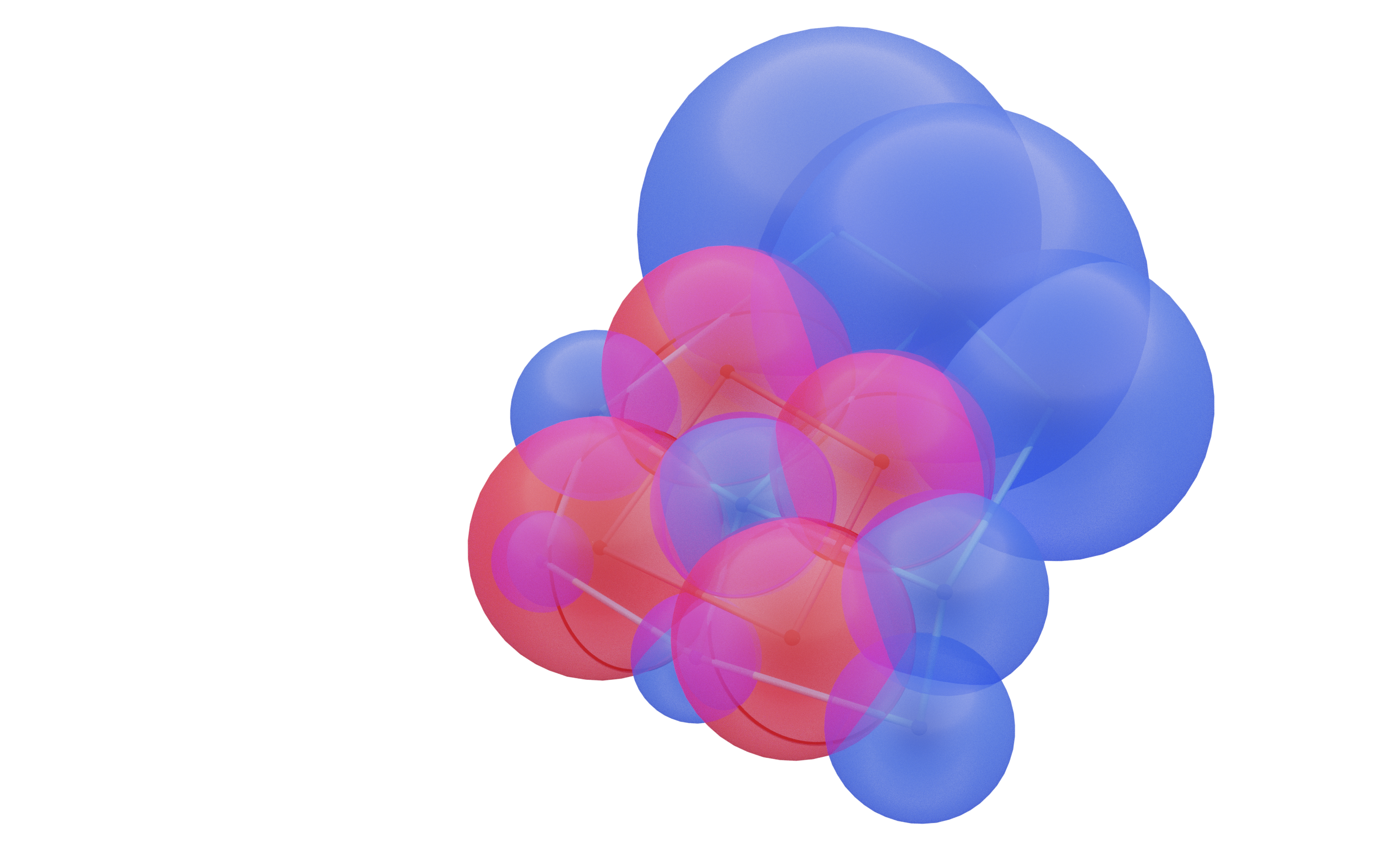
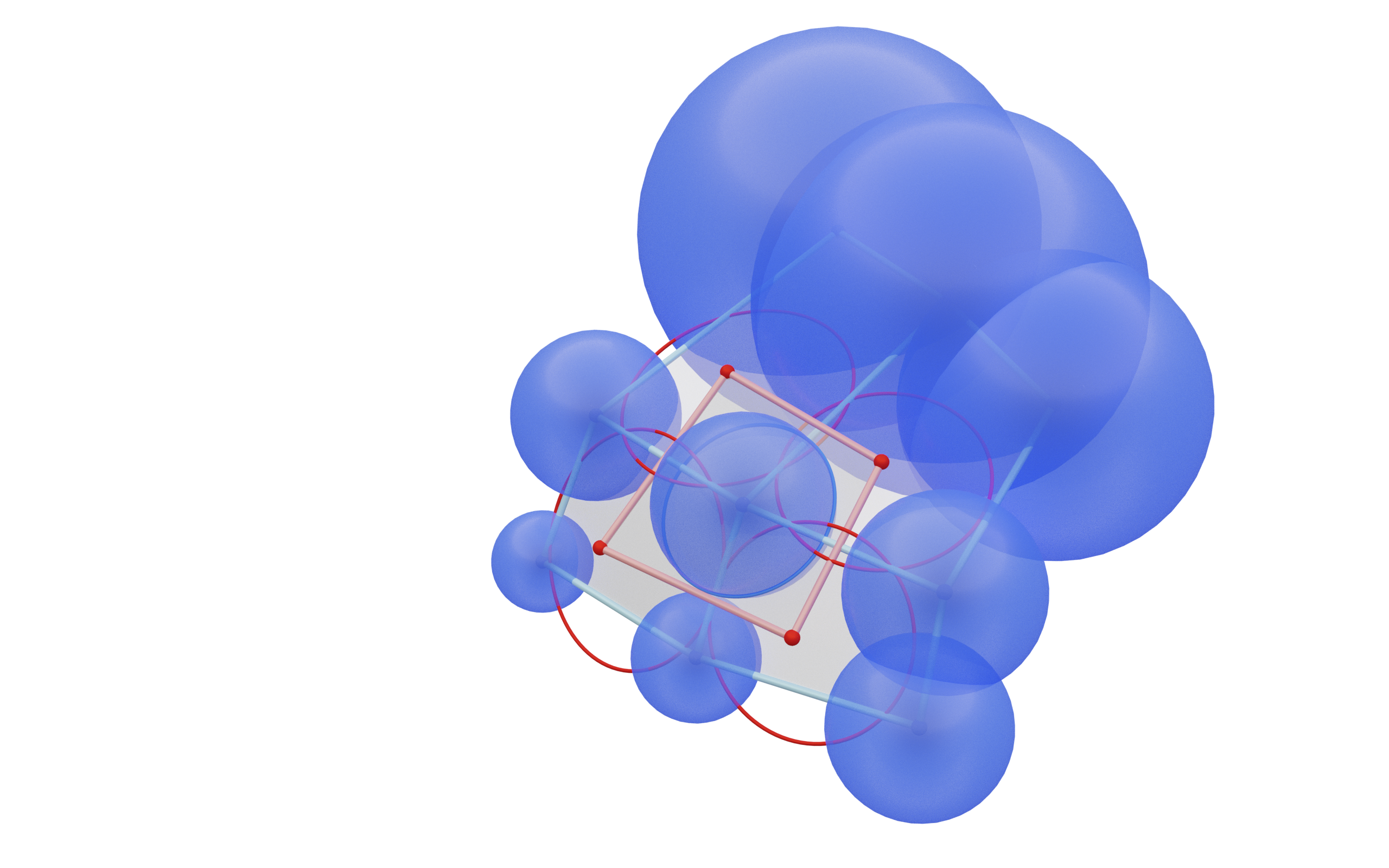
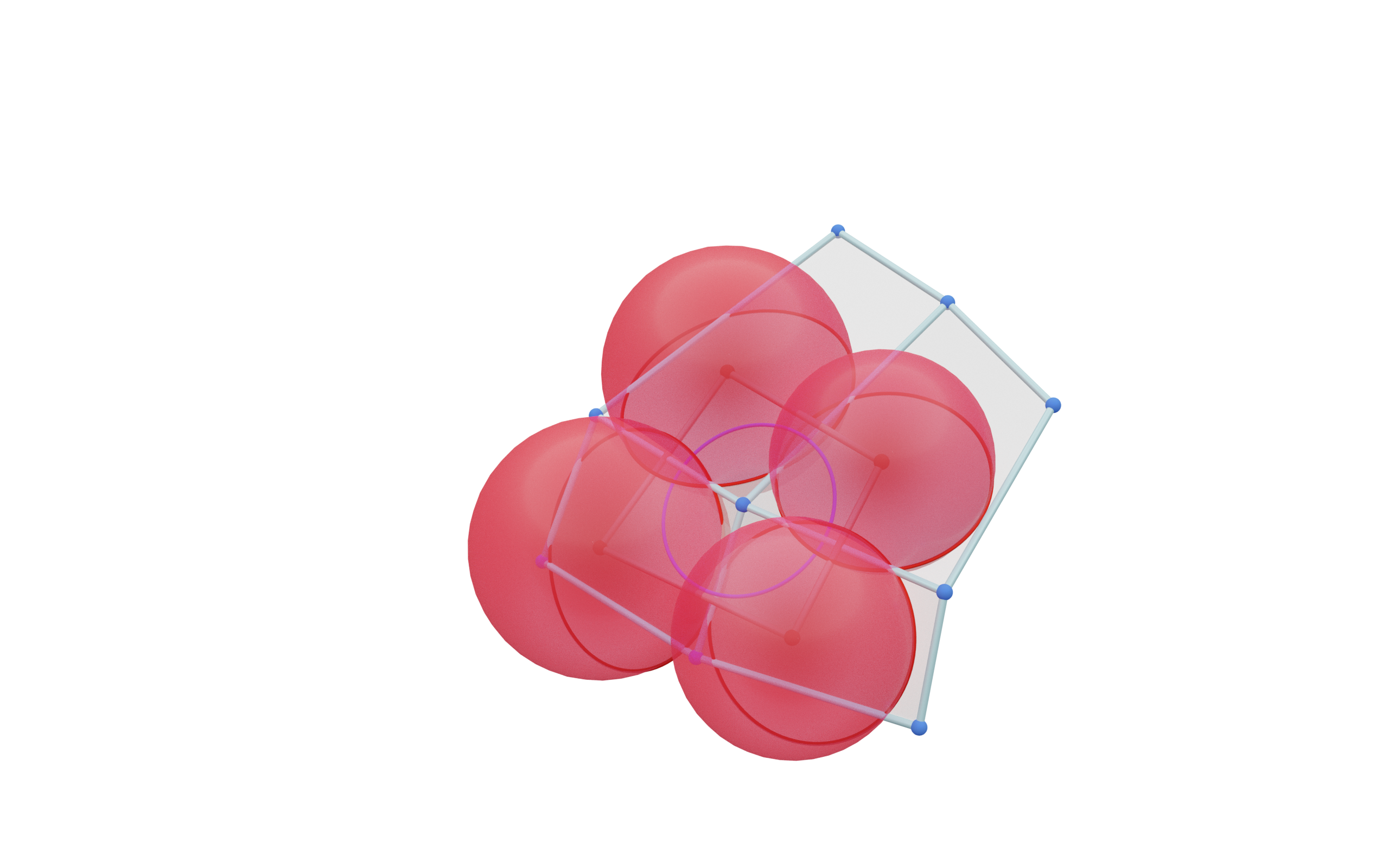
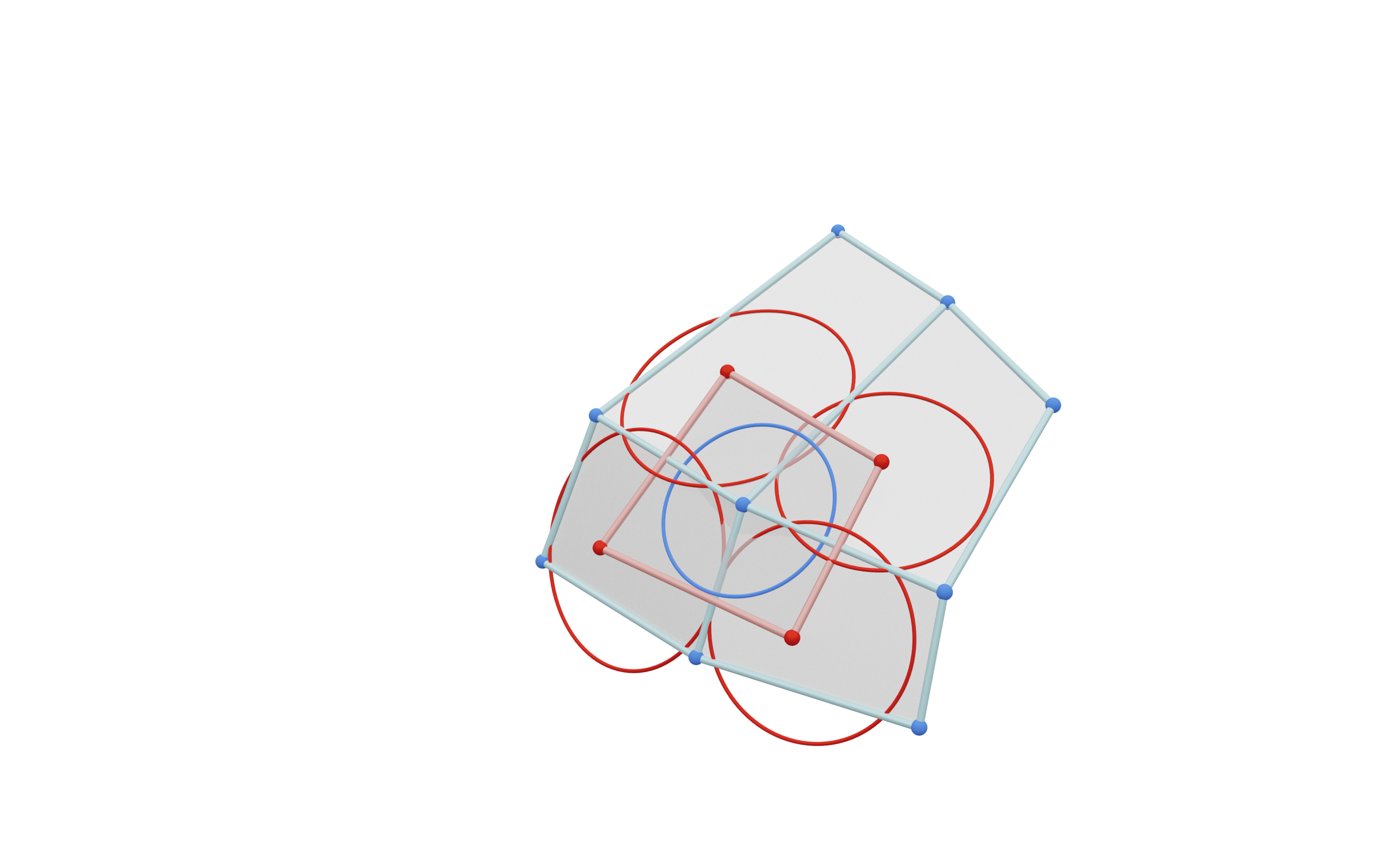
Theorem:
Let $~b : D \rightarrow \mathrm{Planes}(\R^3)~$ be a principal bi*net.
Then its Laguerre lift $~b_\mathcal{B} : D \rightarrow \R\mathrm{P}^4~$ is a conjugate polar binet.
Let $~b : D \rightarrow \mathrm{Planes}(\R^3)~$ be a principal bi*net.
Then its Laguerre lift $~b_\mathcal{B} : D \rightarrow \R\mathrm{P}^4~$ is a conjugate polar binet.
-
Additional structure from planar sections of the Blaschke cylinder:
Cone per $d \in D$.
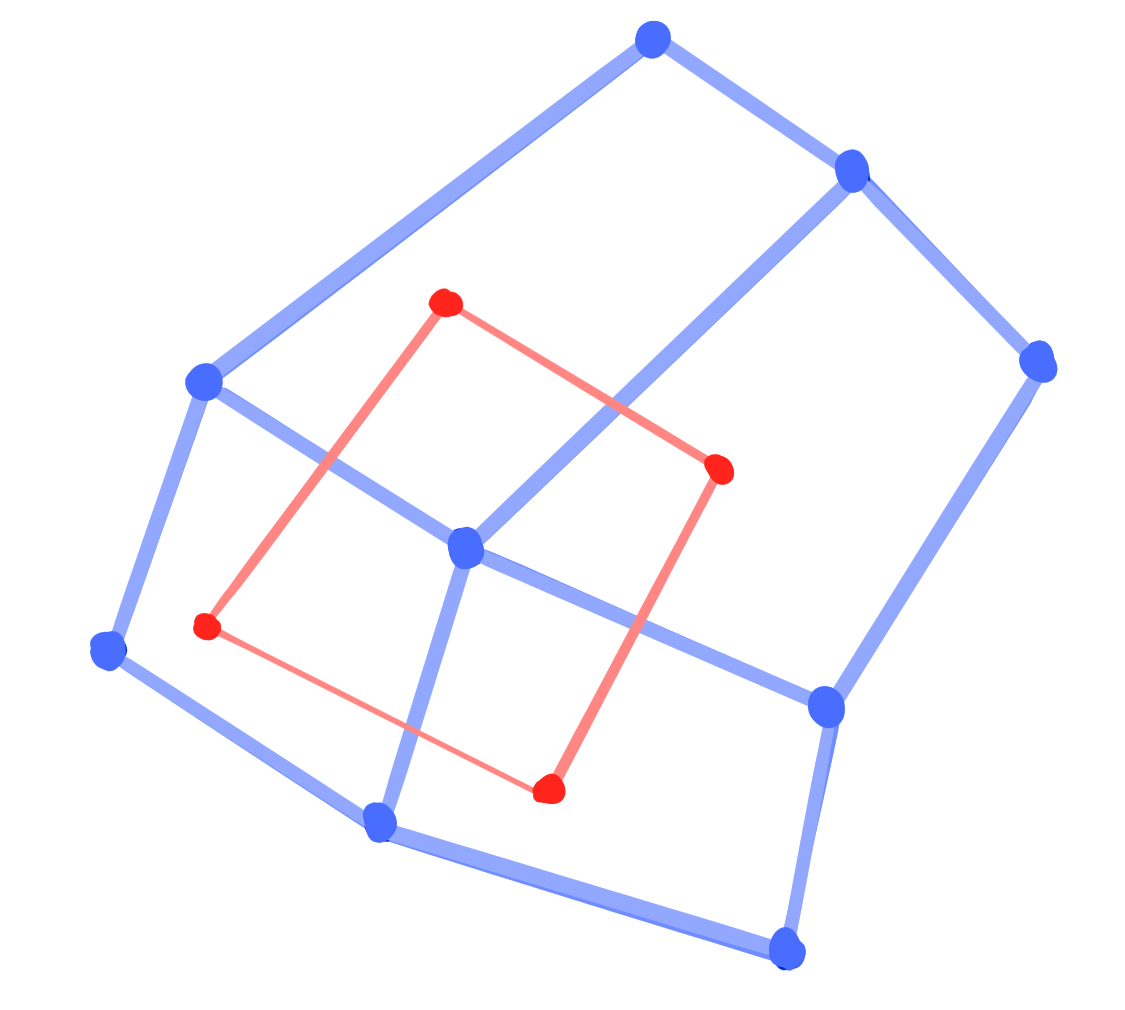
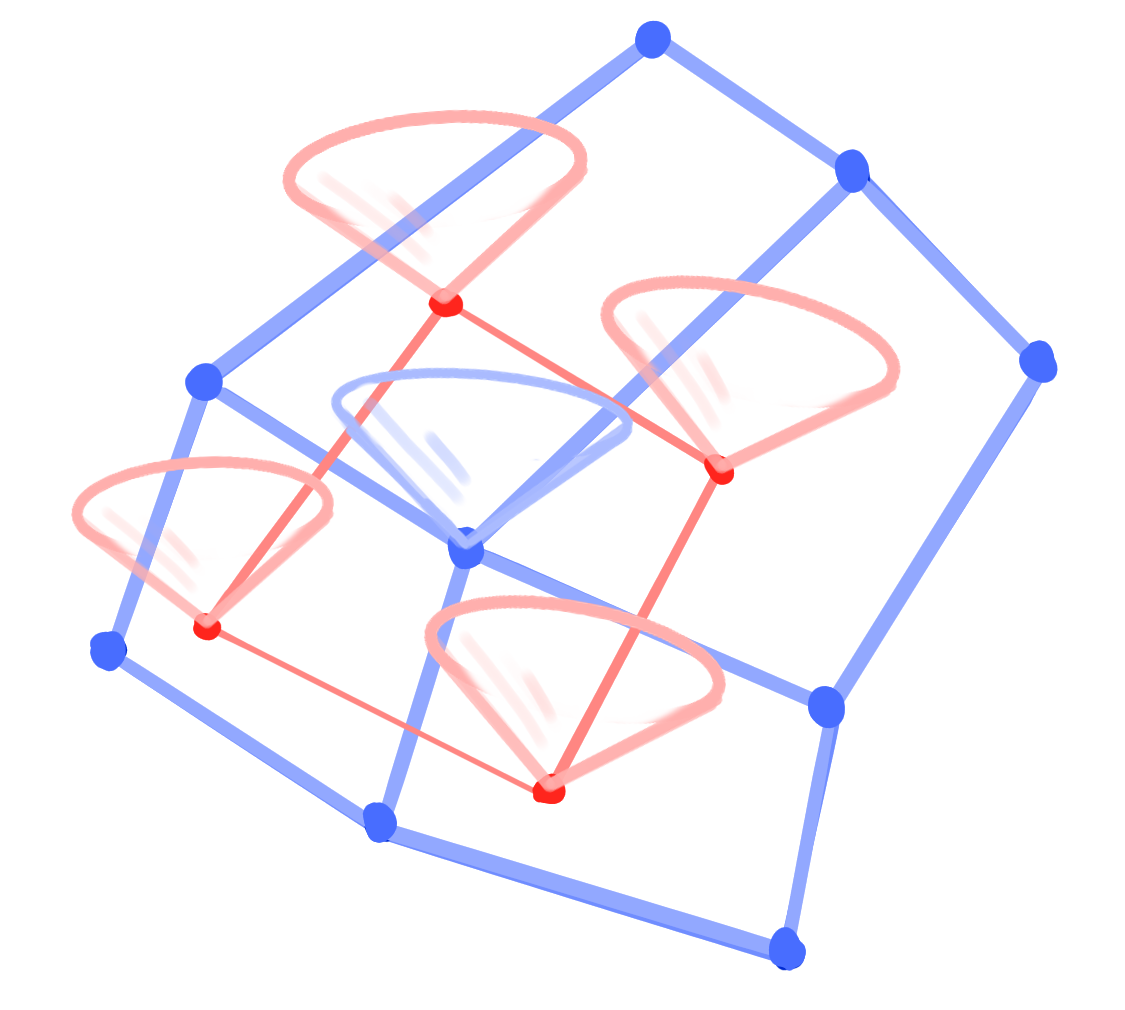
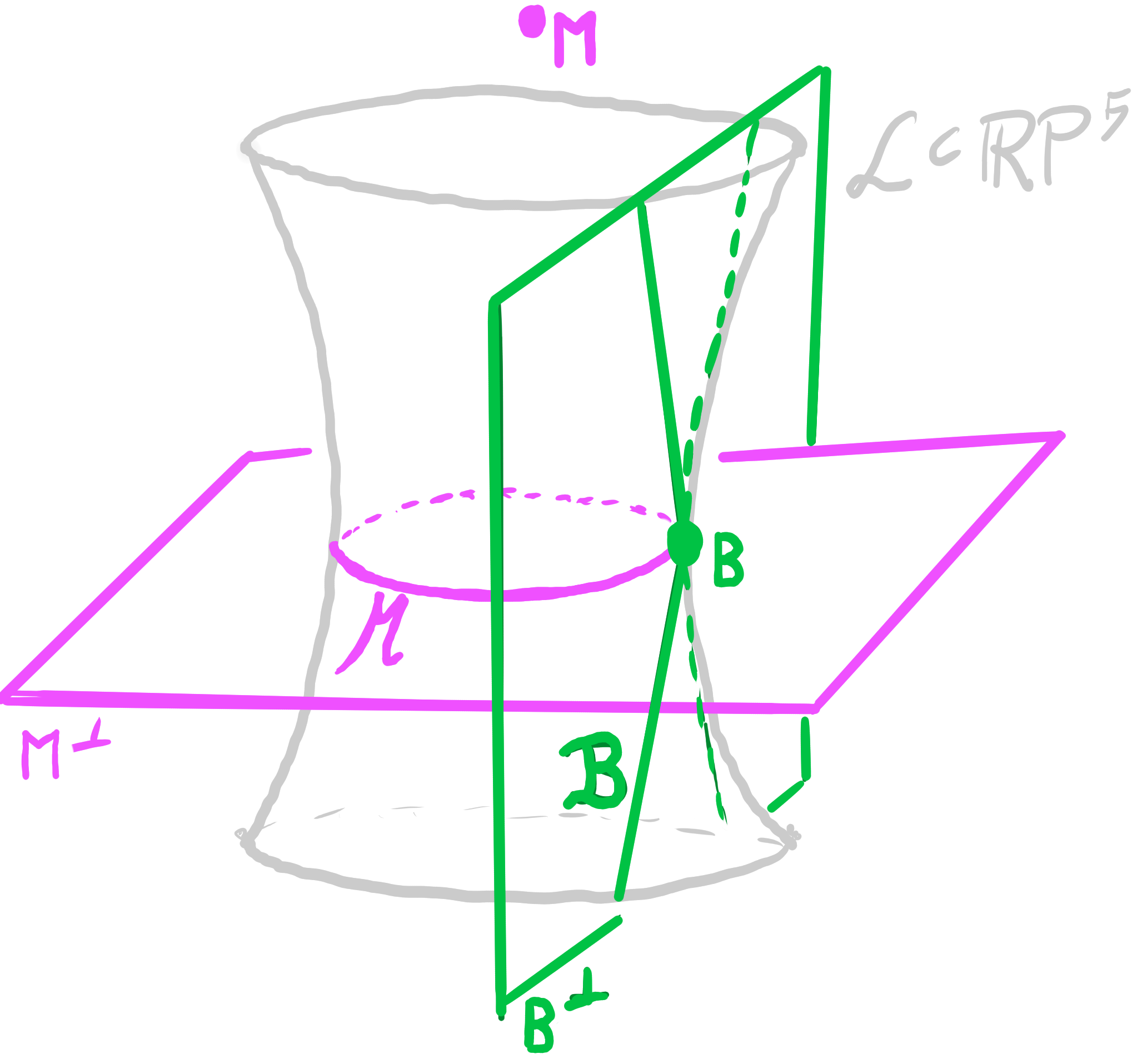
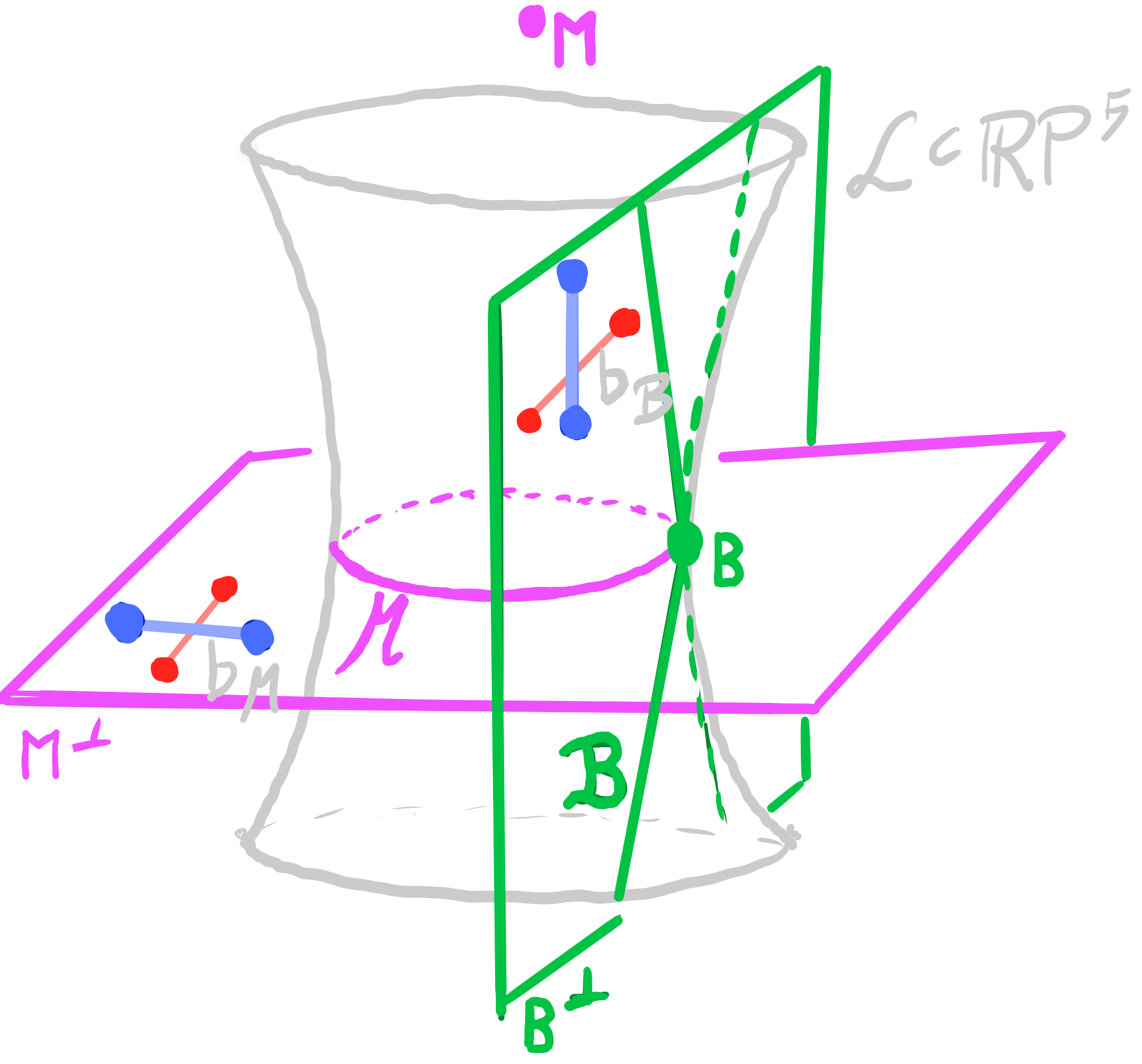
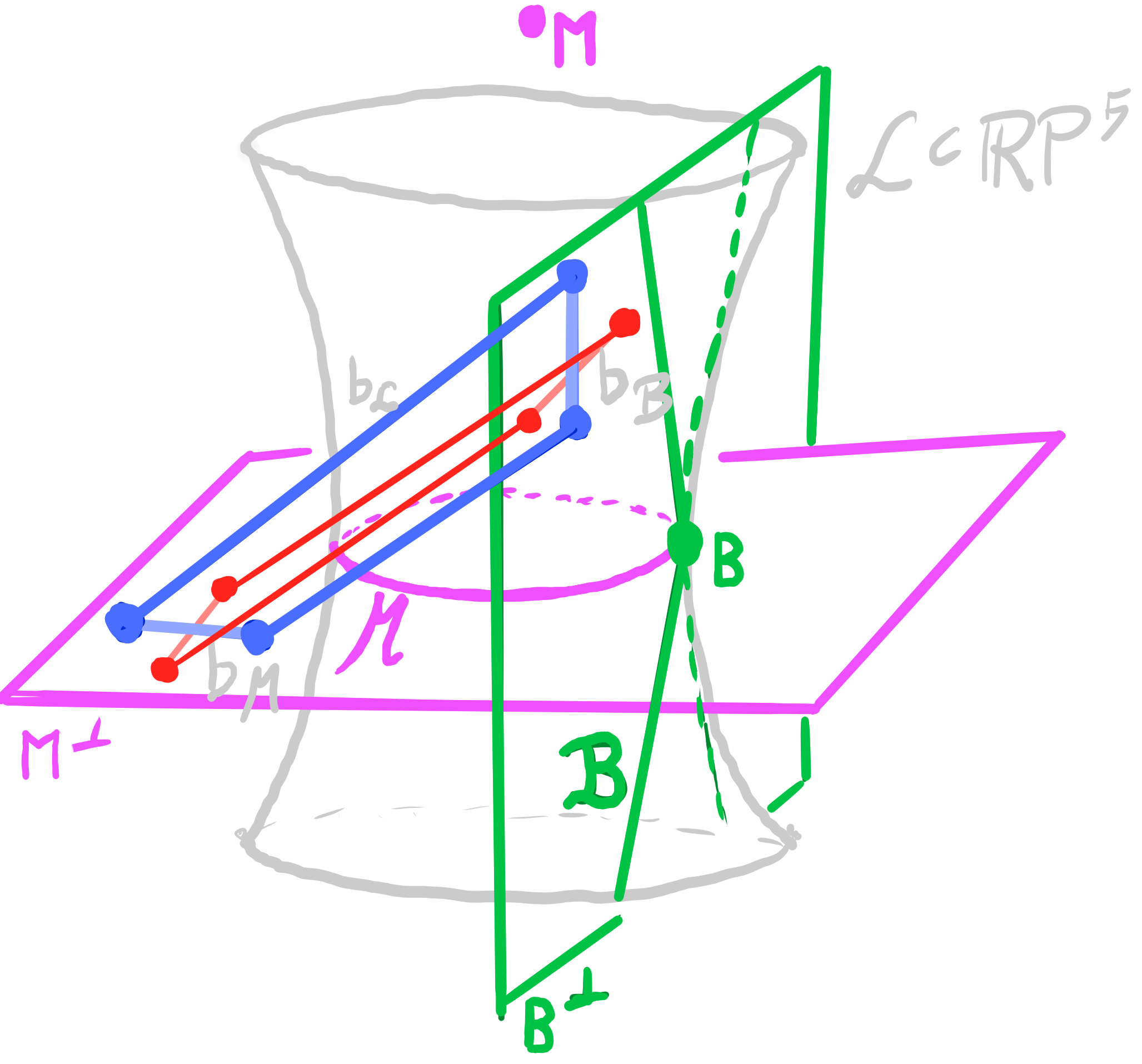
Definition:
Let $\quad b : D \rightarrow \R^3 \quad$ be a principal binet.
Let $\quad b_{\mathcal{M}} : D \rightarrow \mathbf{M}^\perp \subset \R\mathrm{P}^5 \quad$ be a Möbius lift of $b$,
and $\quad b_{\mathcal{B}} : D \rightarrow \mathbf{B}^\perp \subset \R\mathrm{P}^5 \quad$ be a Laguerre lift of $\square b$.
Then the map $\quad b_{\mathcal{L}} = b_{\mathcal{M}} \vee b_{\mathcal{B}} : D \rightarrow \mathrm{Lines}(\R\mathrm{P}^5) \quad$ is called a Lie lift of $b$.
Let $\quad b : D \rightarrow \R^3 \quad$ be a principal binet.
Let $\quad b_{\mathcal{M}} : D \rightarrow \mathbf{M}^\perp \subset \R\mathrm{P}^5 \quad$ be a Möbius lift of $b$,
and $\quad b_{\mathcal{B}} : D \rightarrow \mathbf{B}^\perp \subset \R\mathrm{P}^5 \quad$ be a Laguerre lift of $\square b$.
Then the map $\quad b_{\mathcal{L}} = b_{\mathcal{M}} \vee b_{\mathcal{B}} : D \rightarrow \mathrm{Lines}(\R\mathrm{P}^5) \quad$ is called a Lie lift of $b$.
Theorem:
The Lie lift $~ b_{\mathcal{L}} : D \rightarrow \left\{\text{lines in } \R P^5\right\} ~$ of a principal binet satisfies:
The Lie lift $~ b_{\mathcal{L}} : D \rightarrow \left\{\text{lines in } \R P^5\right\} ~$ of a principal binet satisfies:
- adjacent lines intersect
- $b_{\mathcal{L}}(v) \perp b_{\mathcal{L}}(f) \quad$ for incident $v \in V$ and $f \in F$
Remark:
The central projection of the lines of the Lie lift to $\R^3$ with center $\mathbf{M} \vee \mathbf{B}$ yields the normal bicongruence of the principal binet.
The central projection of the lines of the Lie lift to $\R^3$ with center $\mathbf{M} \vee \mathbf{B}$ yields the normal bicongruence of the principal binet.
Conclusion:
Principal binets in $\R^3$ can be lifted to polar line bicongruences in $\R\mathrm{P}^5$.
Vice versa, polar line bicongruences in $\R\mathrm{P}^5$ project to principal binets in $\R^3$.
Principal binets in $\R^3$ can be lifted to polar line bicongruences in $\R\mathrm{P}^5$.
Vice versa, polar line bicongruences in $\R\mathrm{P}^5$ project to principal binets in $\R^3$.
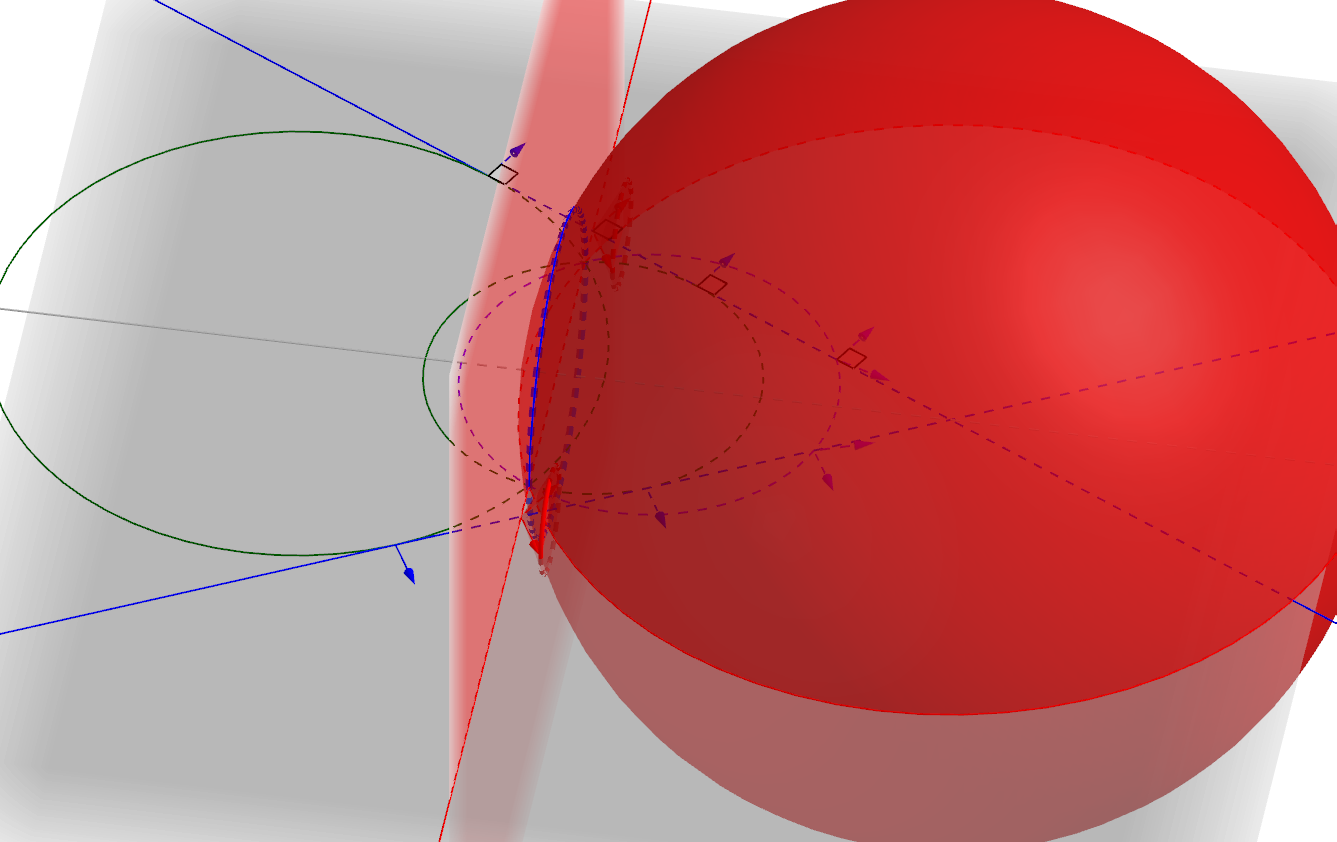
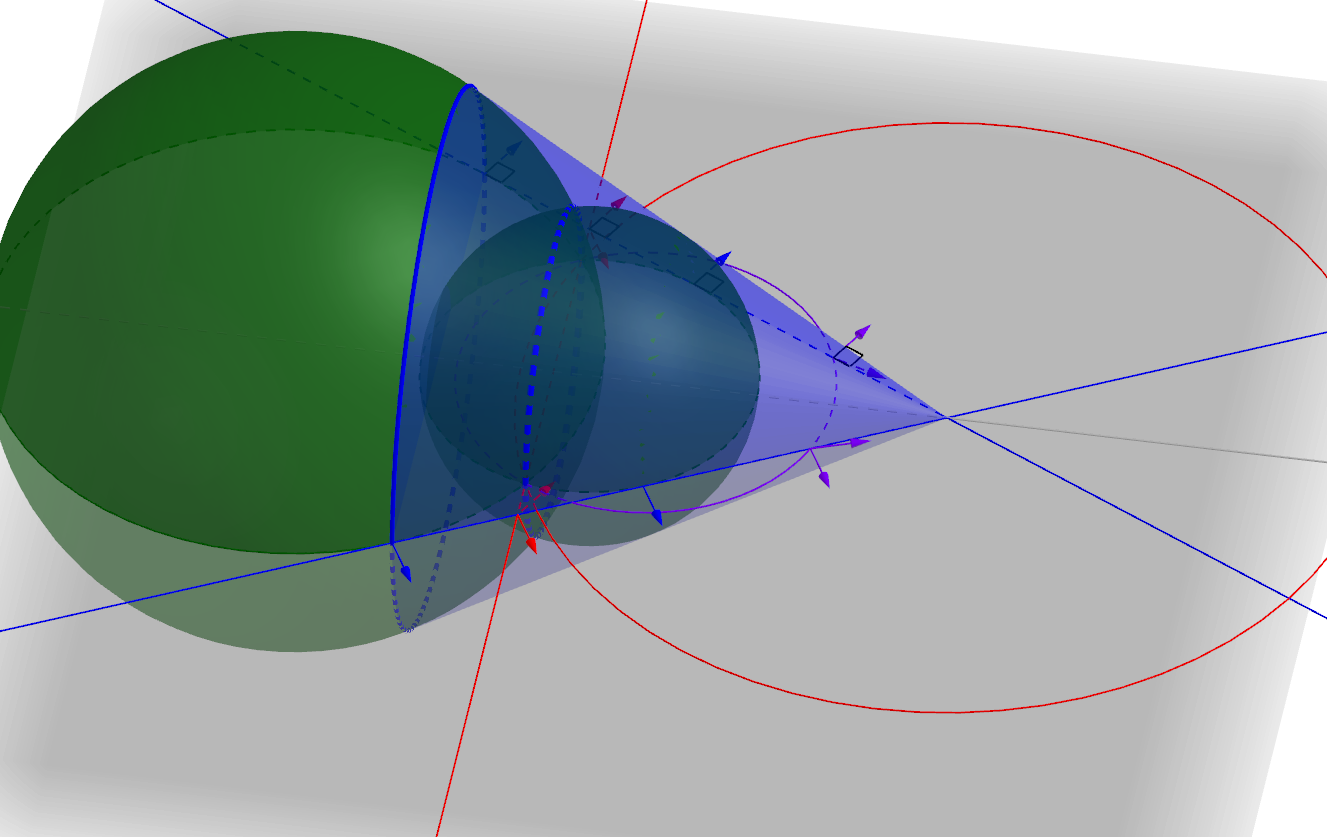
- Generalize circular nets (Möbius geometry) and conical nets (Laguerre geometry).
- Allow Möbius and Laguerre invariant descriptions in terms of polar binets.
- Allow Lie invariant descriptions in terms of polar bicongruences.
Remark:
- Binets allow for a natural definition of Koenigs nets, including Christoffel duality.
- Combining Koenigs binets with orthogonal binets yields isothermic binets.
Part 2: Consistency
- $V_N = V(\Z^N) = \Z^N$
- $E_N = E(\Z^N)$
- $F_N = F(\Z^N)$
- $D_N = V_N \cup F_N$
- $C_N = \left\{ (v, f, v', f') ~|~ v,v'\in V_N,\quad f, f'\in F_N,\quad v, v' \text{ incident to } f, f' \right\}$
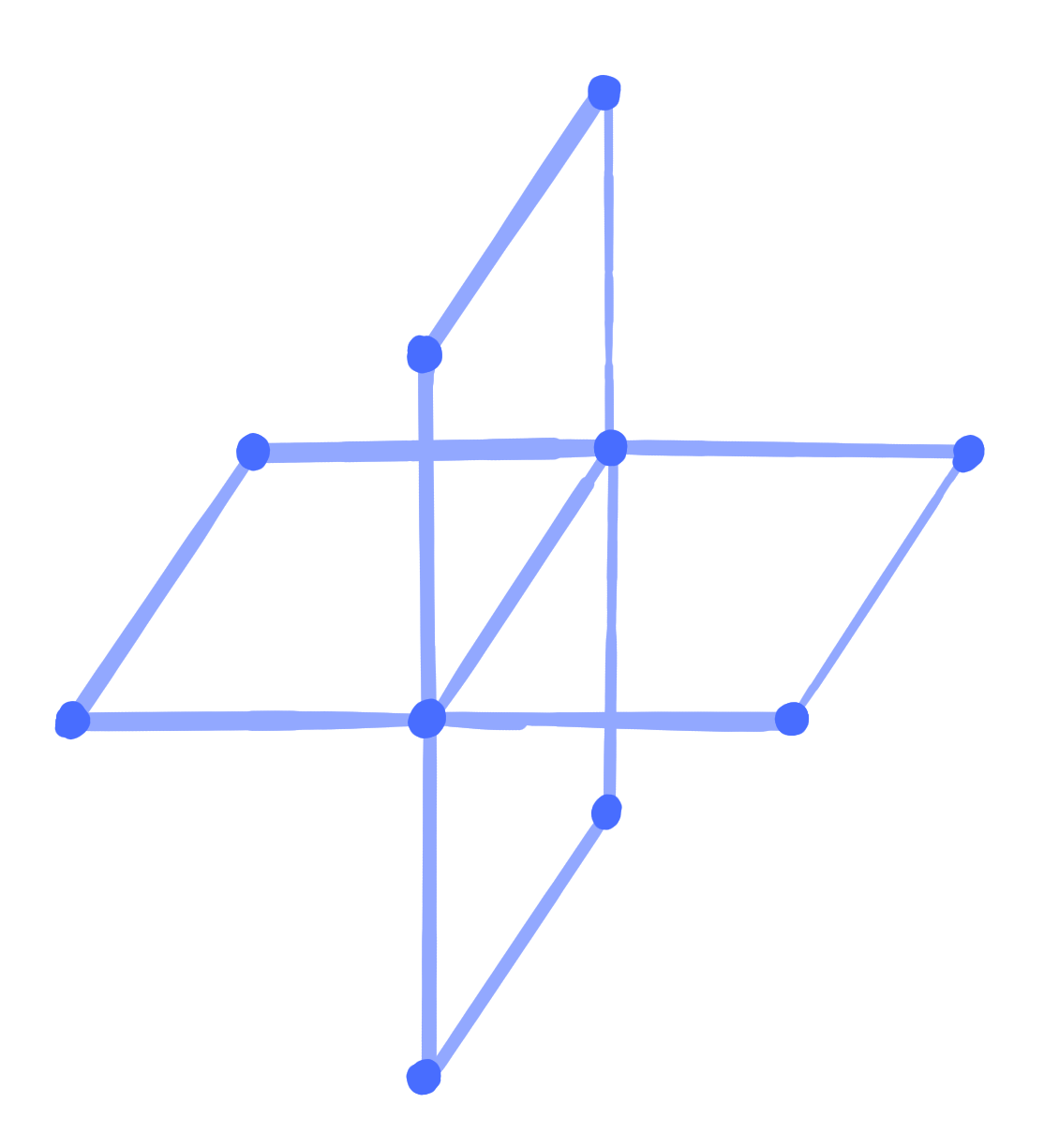
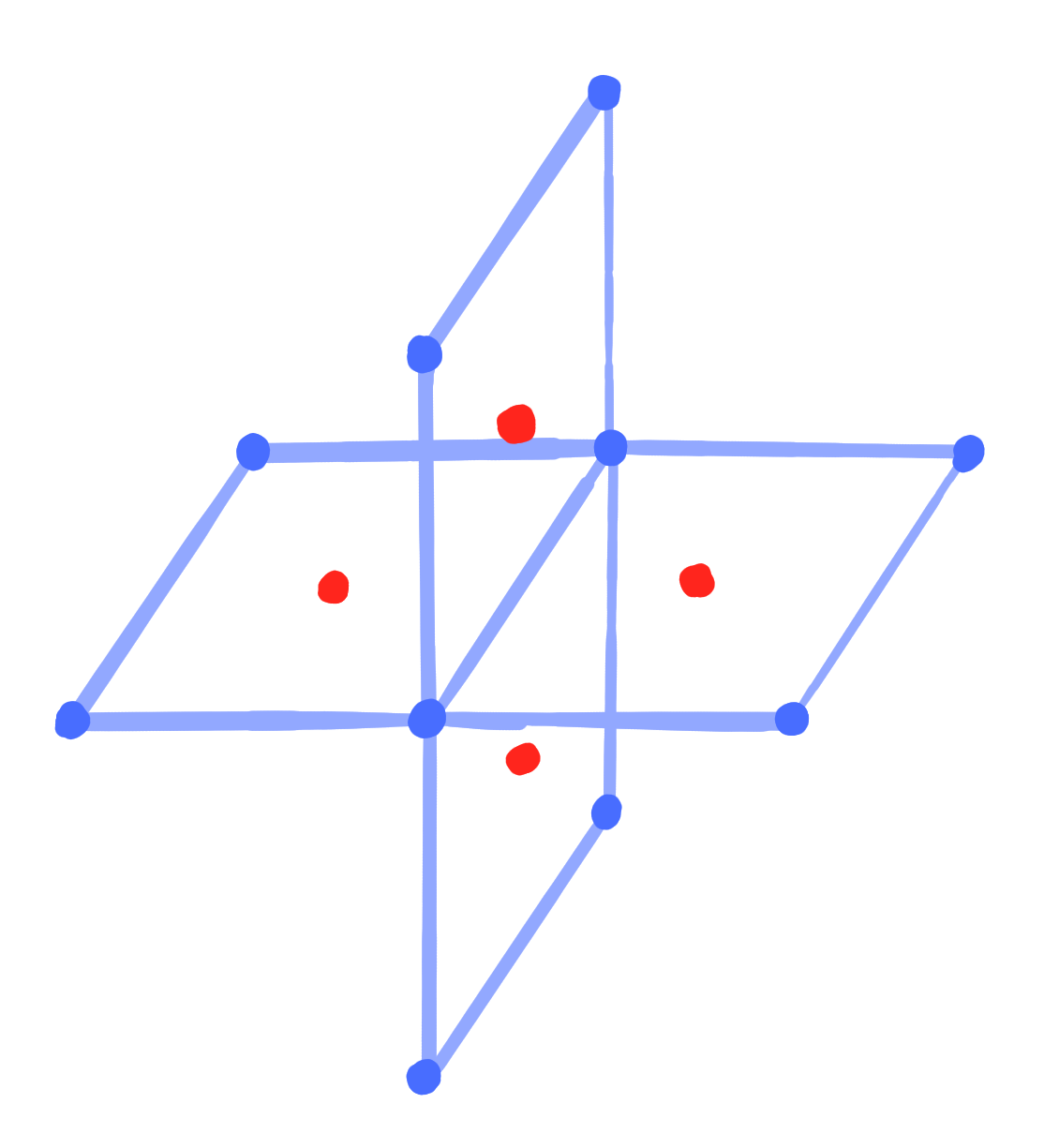
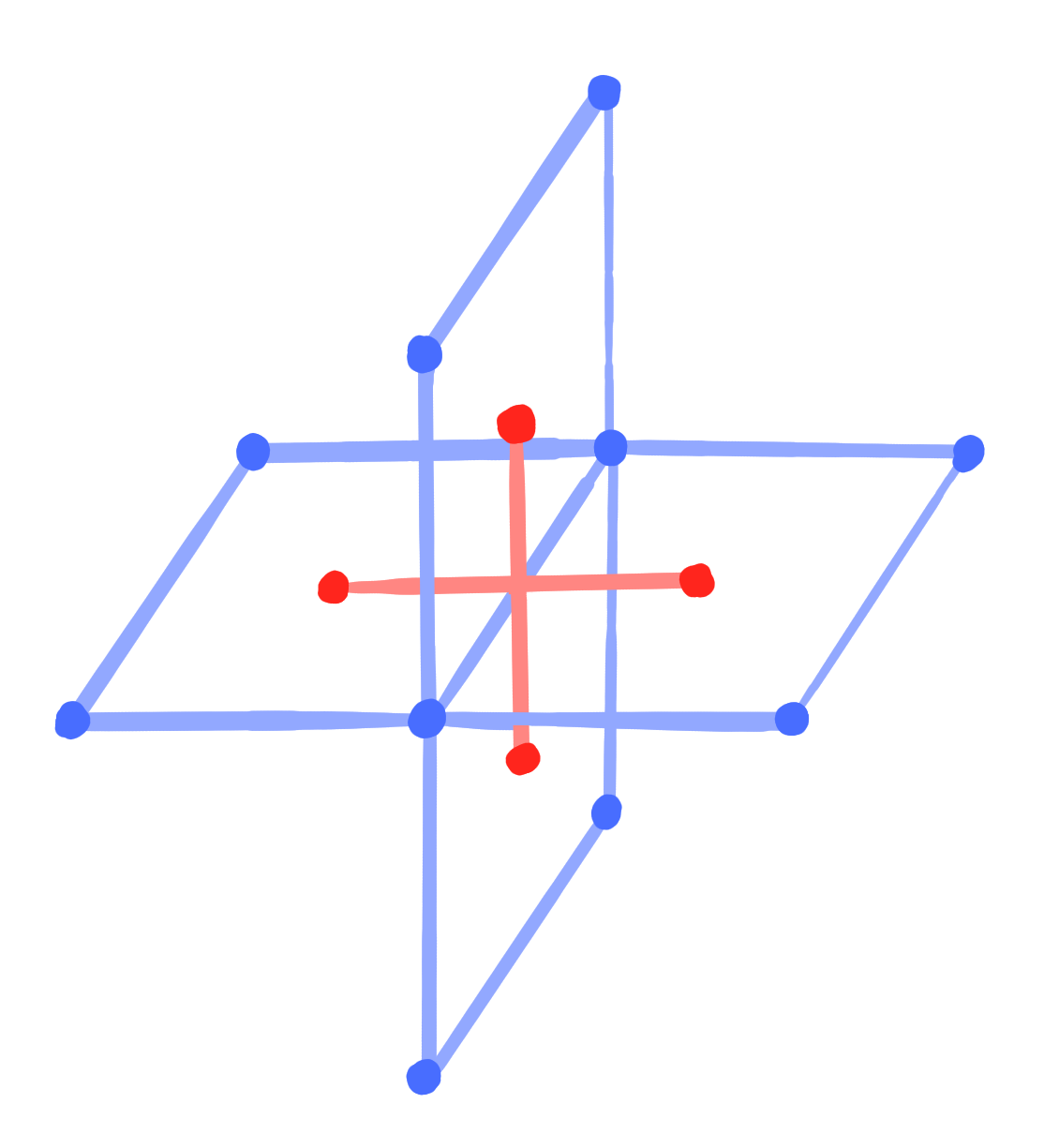
|
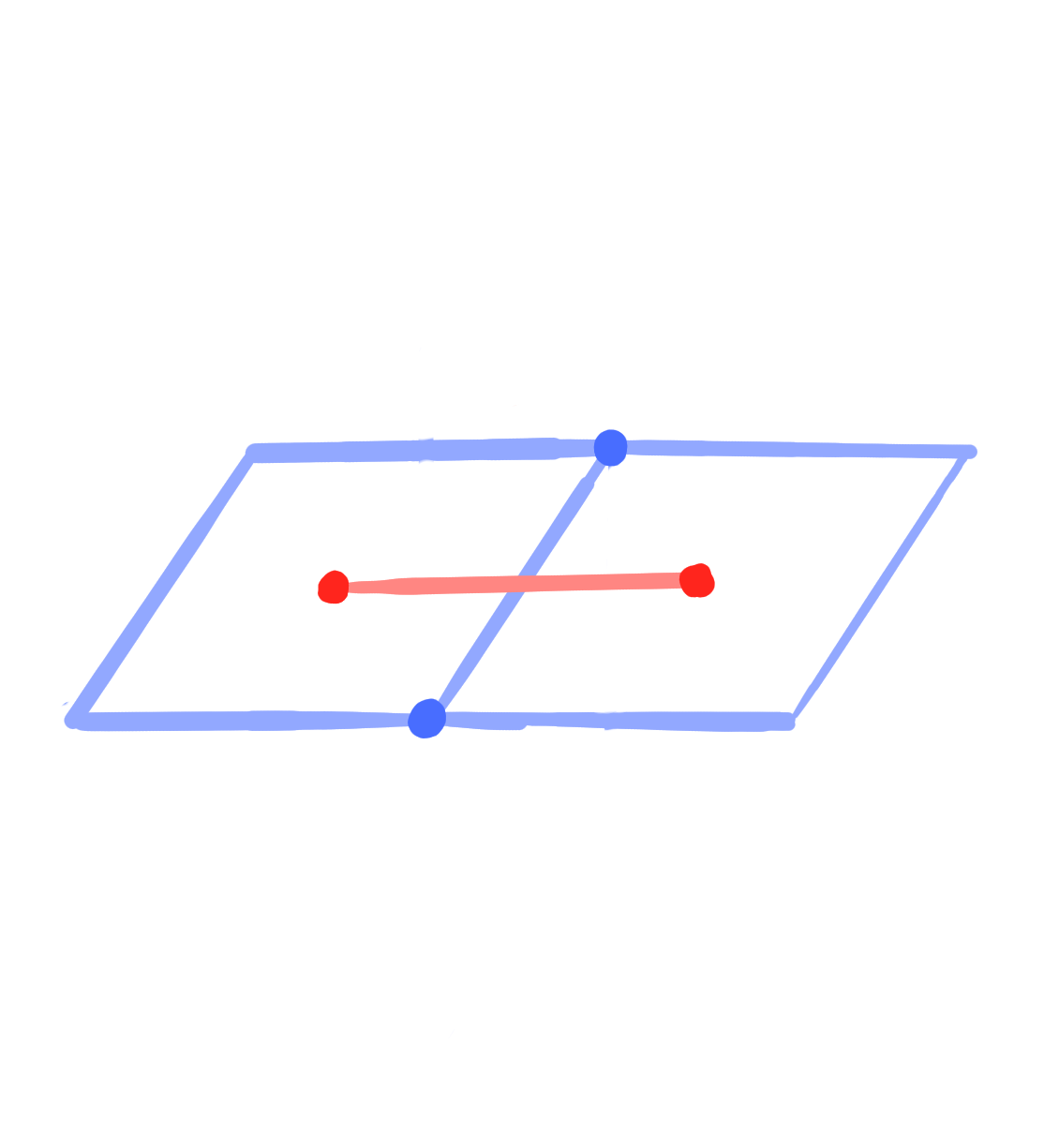
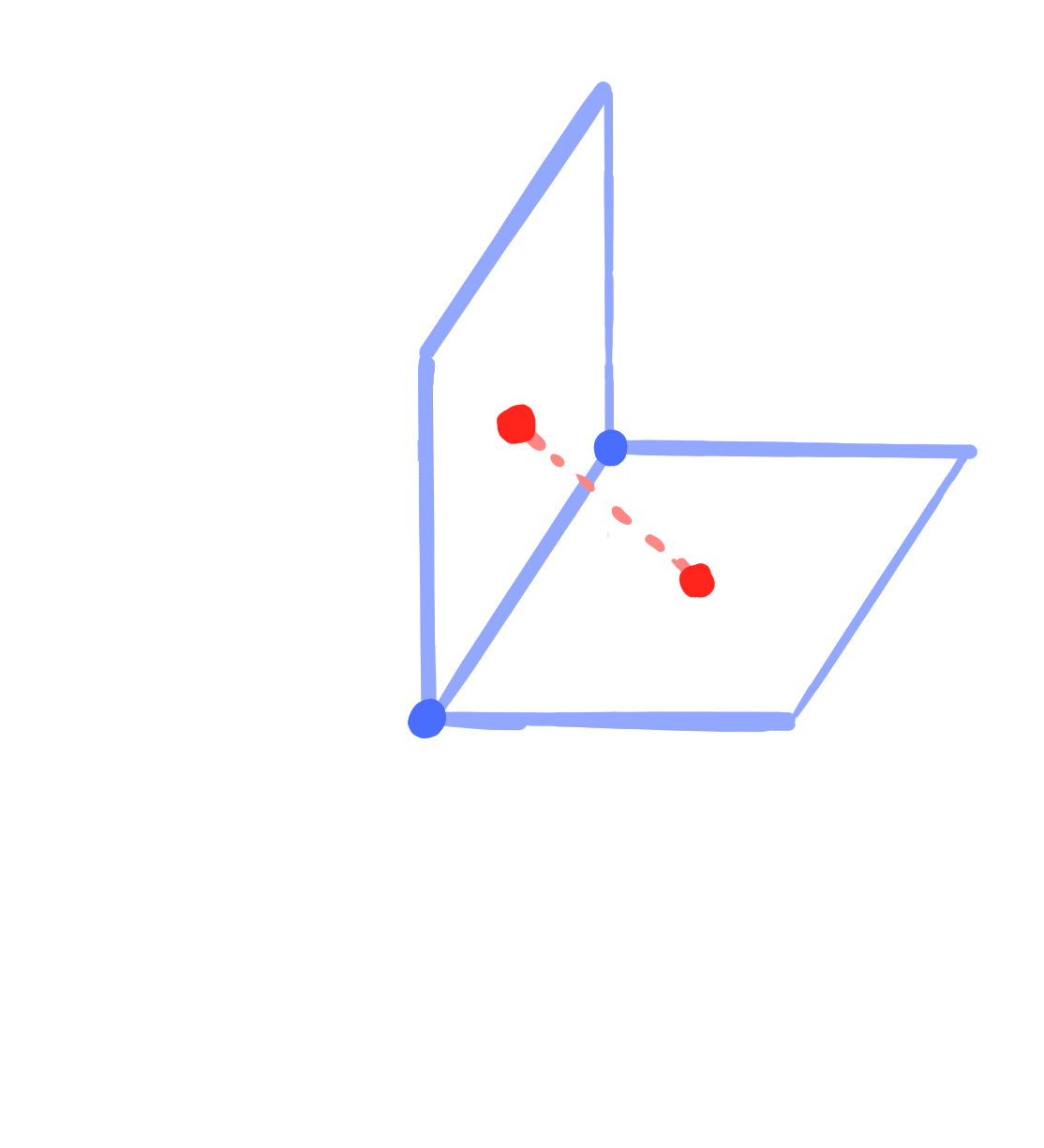
|
- An $N$-dimensional vertex-net is a map $~V_N \rightarrow \R\mathrm{P}^n$.
- An $N$-dimensional face-net is a map $~F_N \rightarrow \R\mathrm{P}^n$.
- An $N$-dimensional binet is a map $~D_N \rightarrow \R\mathrm{P}^n$.
Definition:
A conjugate vertex-net (Q-net) is a map $~g : V_N \rightarrow \R\mathrm{P}^n~$ such that
It defines a corresponding map $~\square g : F_N \rightarrow \mathrm{Planes}(\R\mathrm{P}^n)~$.
|
\[
\bigvee_{v \in f} g(v) \quad\text{is a plane for all} ~f \in F_N.
\qquad\qquad
\]
|

|
Definition:
A conjugate face-net is a map $~g : F_N \rightarrow \R\mathrm{P}^n~$ such that
It defines a corresponding map $~\square g : V_N \rightarrow \mathrm{Planes}(\R\mathrm{P}^n)~$.
|
\[
\bigvee_{f \ni v} g(f) \quad\text{is a plane for all} ~v \in V_N.
\]
|
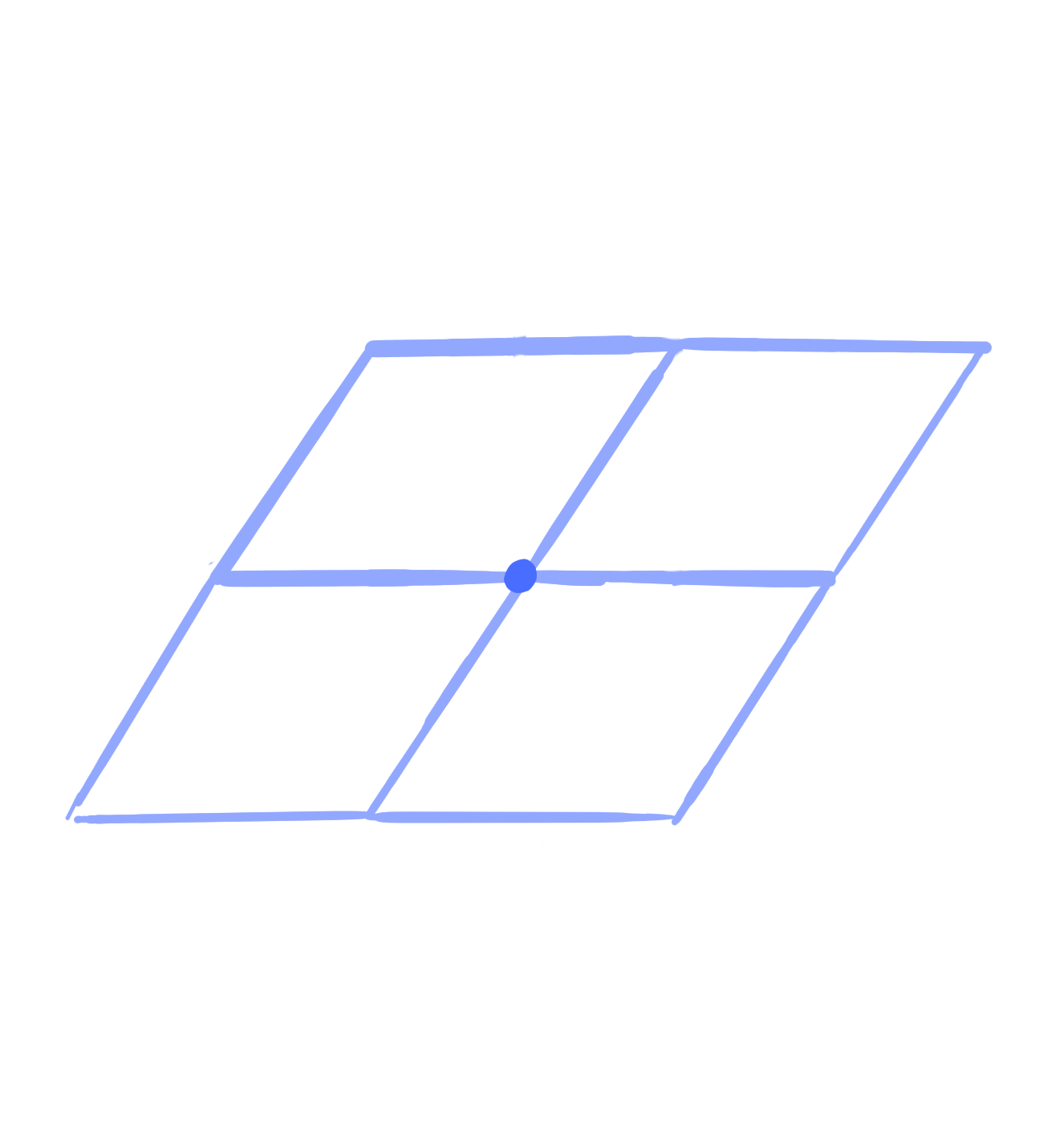
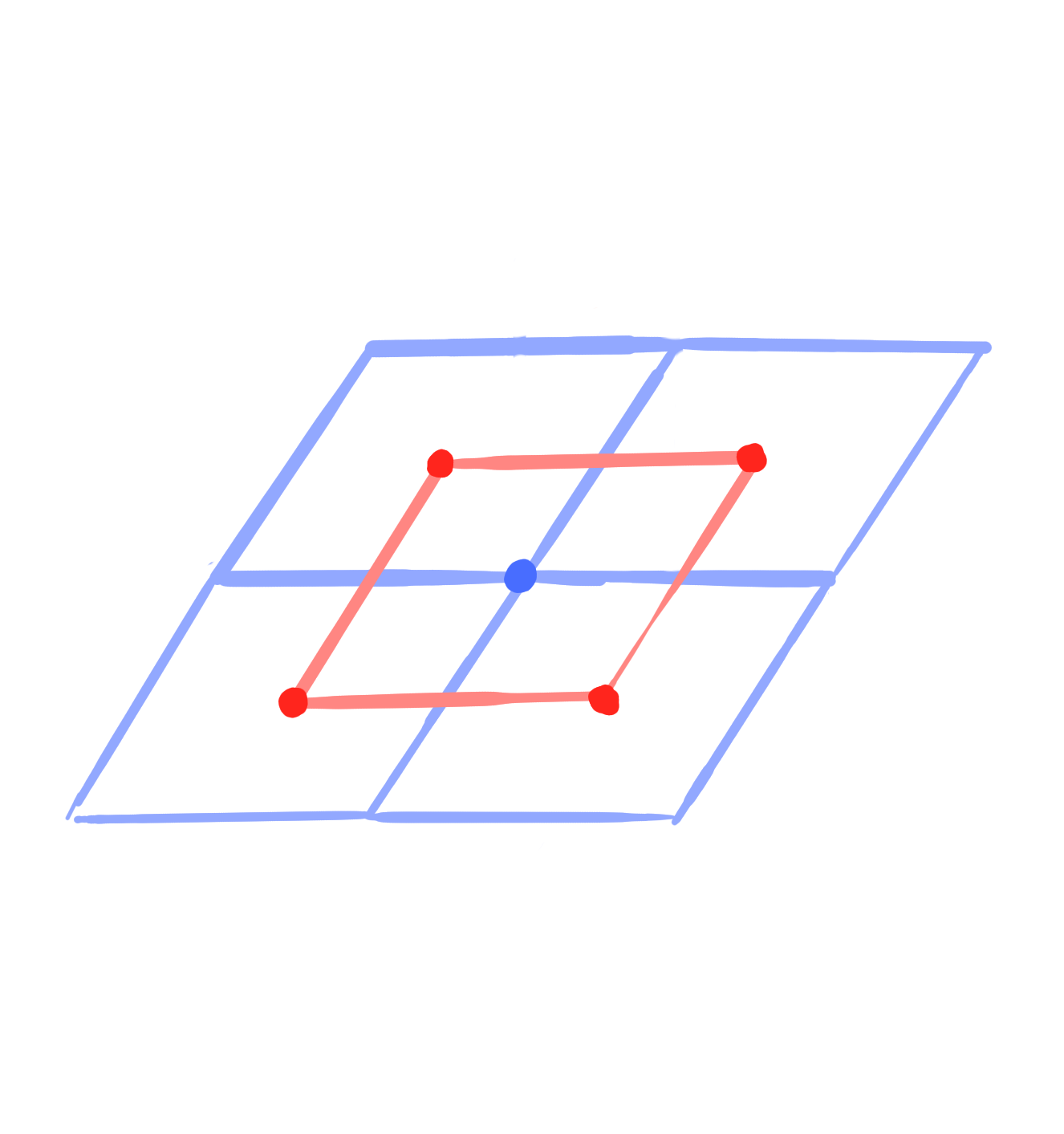
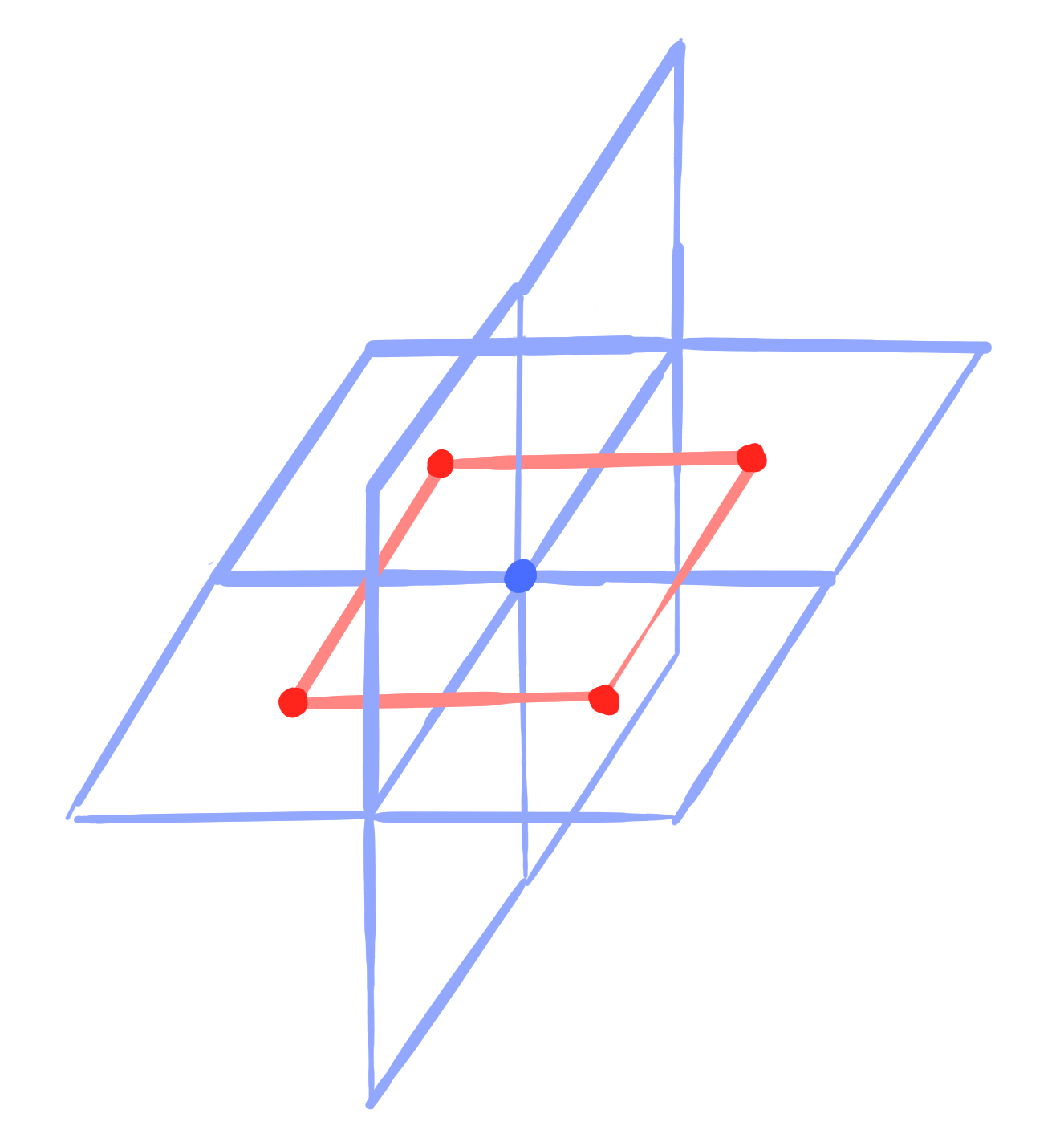
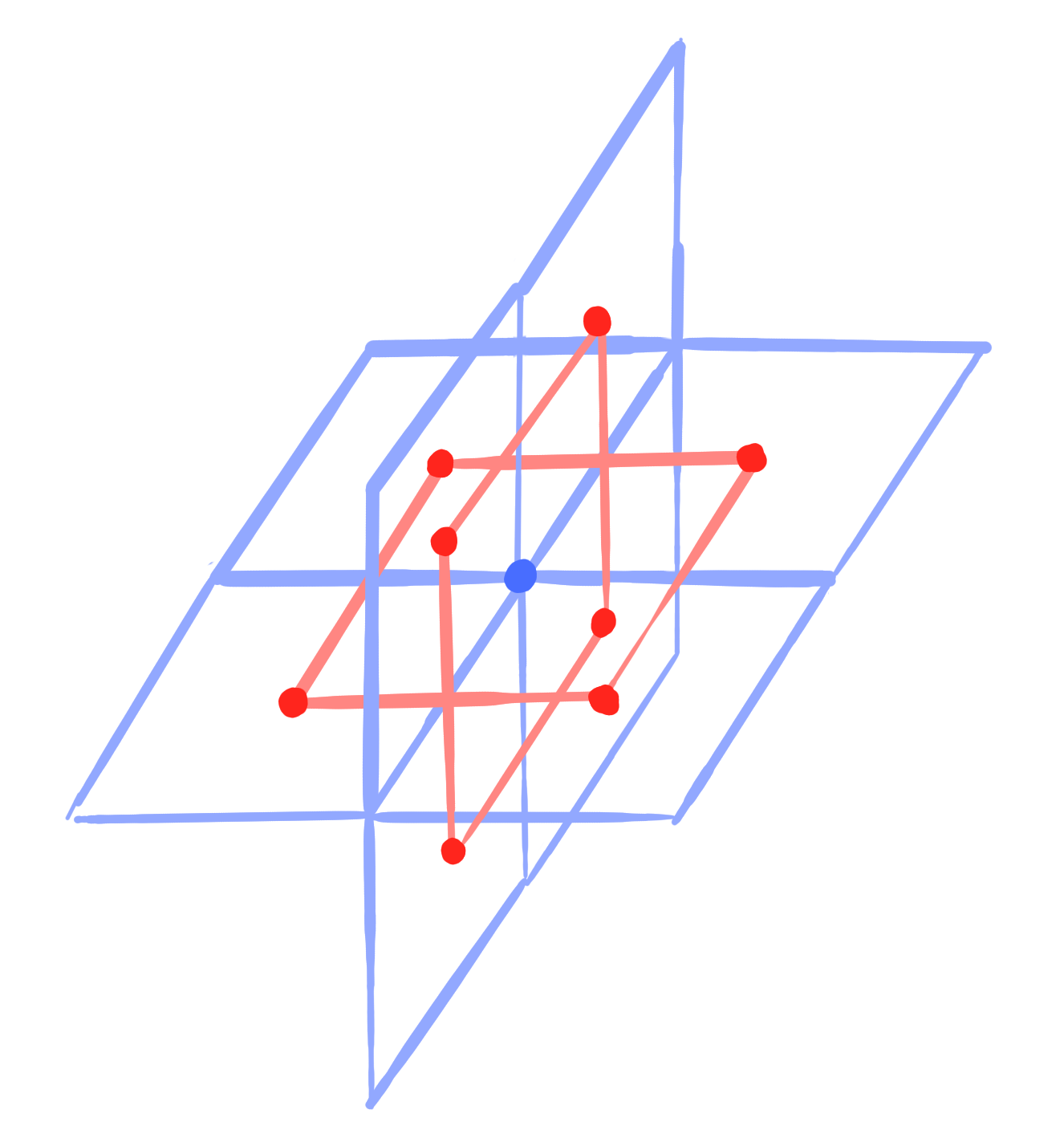
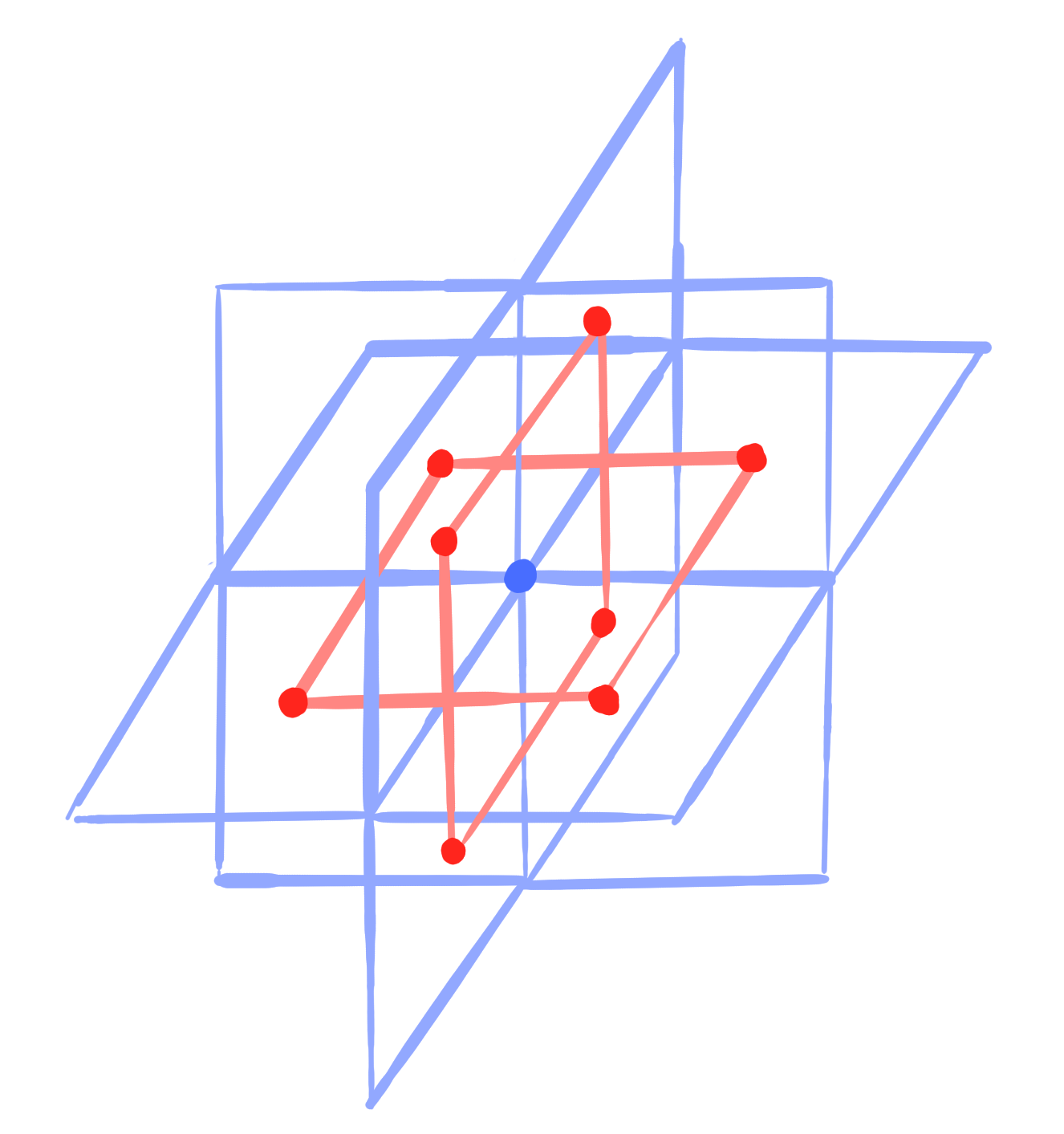
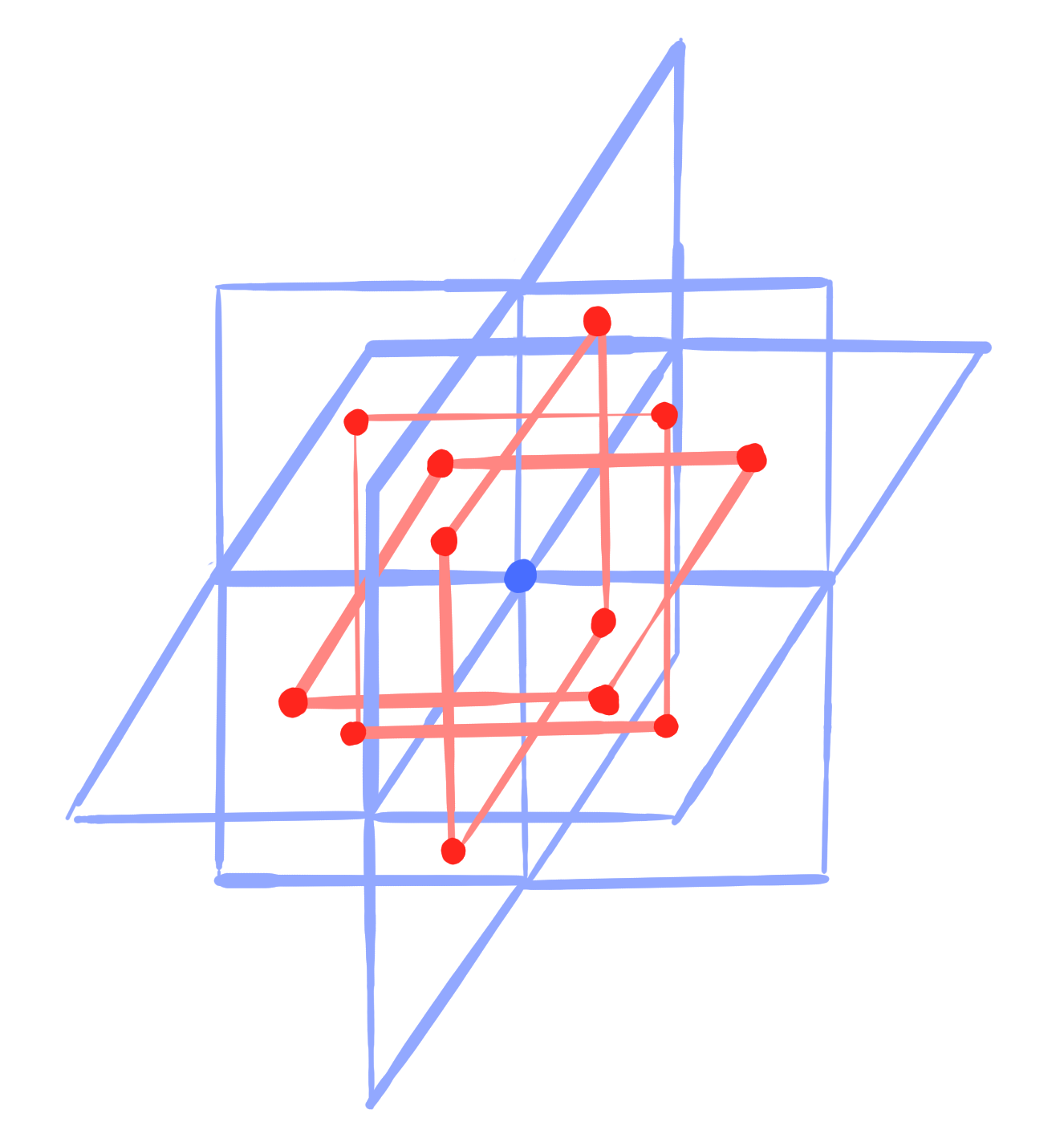
|
Theorem [DS97]:
Conjugate vertex-nets are multi-dimensionally consistent 3D-systems.
Question:
Are conjugate face-nets consistent?
Consider the restriction to faces only in a given $i,j$-direction:
\[
\small
F^{ij}_N = \left\{ \{r, r+e_i, r+e_i+e_j, r+e_j\} \in F_N ~|~ r \in \Z^N \right\} \cong \Z^N
\]
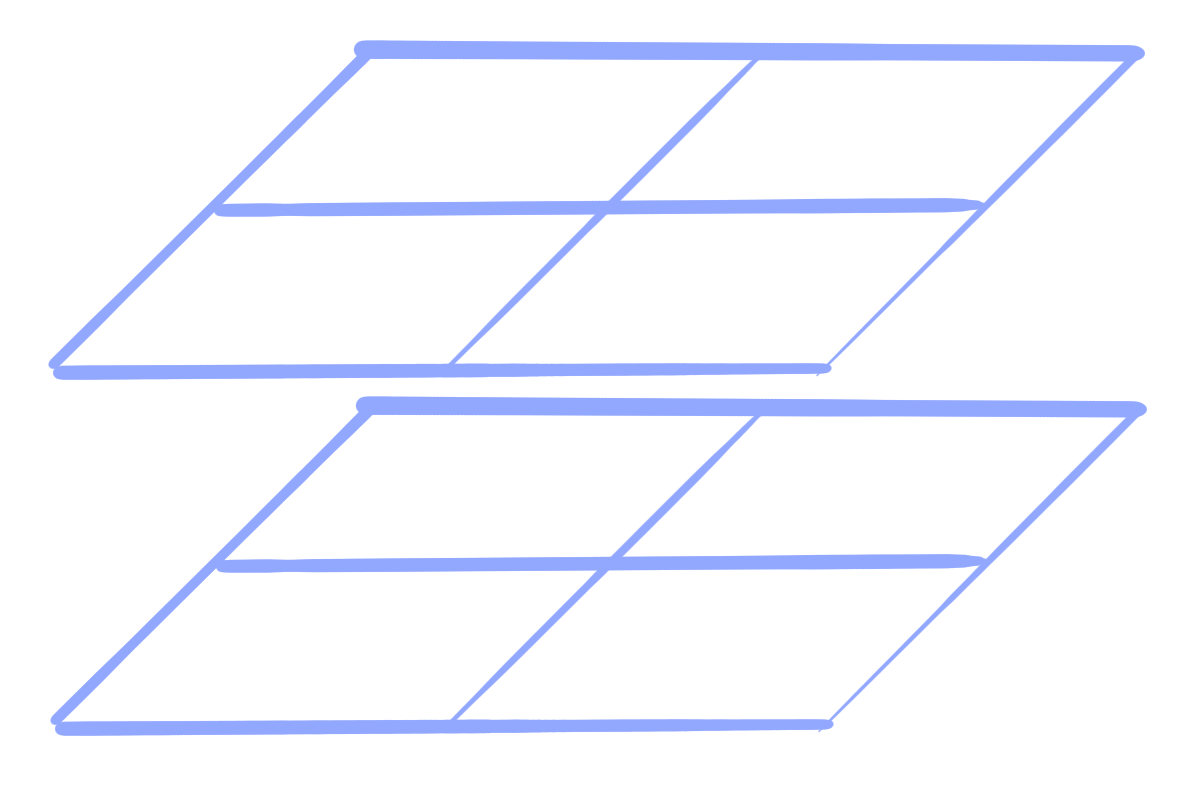
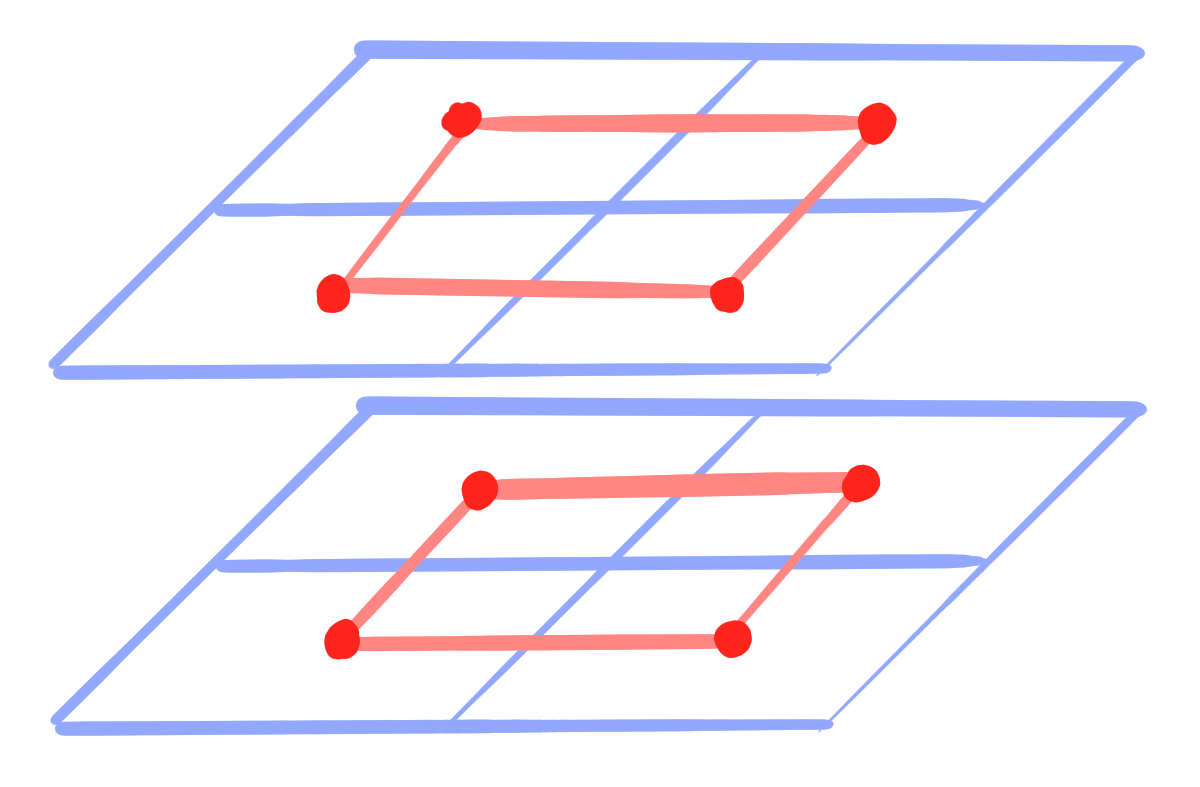
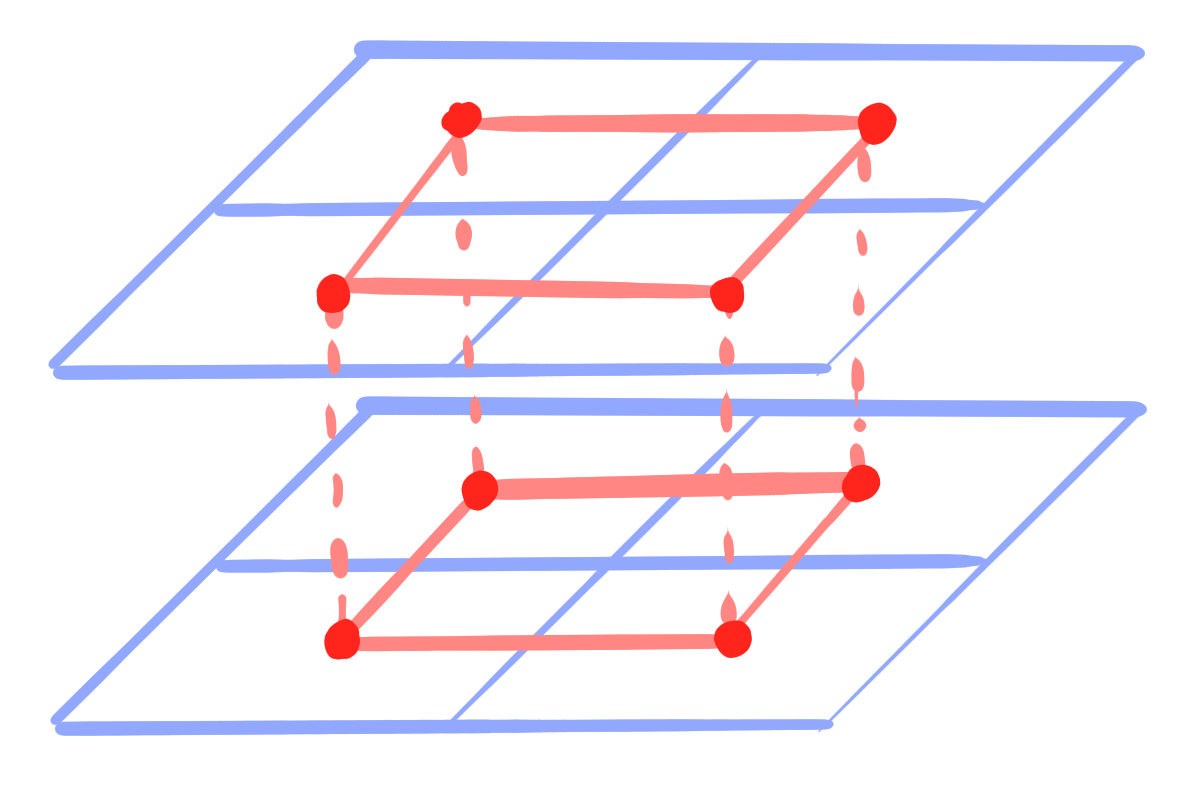
Lemma:
Let $g : F_N \rightarrow \R\mathrm{P}^n$ be a conjugate face-net.
Then its restriction
\[
\small
g^{ij} = g|_{F^{ij}_N} : {F^{ij}_N} \cong \Z^N \longrightarrow \R\mathrm{P}^n
\]
is a conjugate vertex-net.
Vice versa, consider a conjugate vertex-net $~g : F^{ij}_N \rightarrow \R\mathrm{P}^n$.
- All planes $~\square g : V_N \rightarrow \mathrm{Planes}(\R\mathrm{P}^n)~$ are already defined.
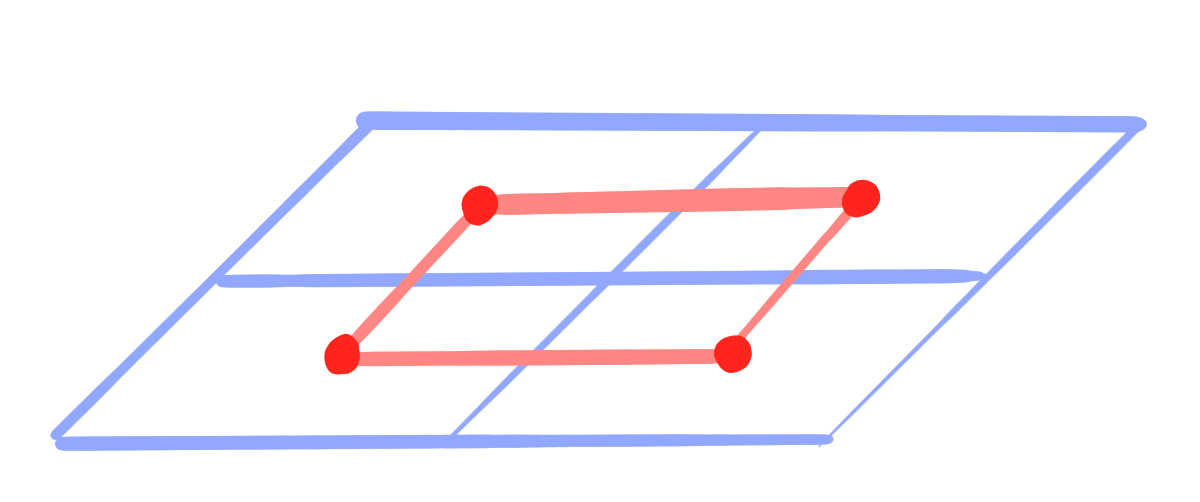
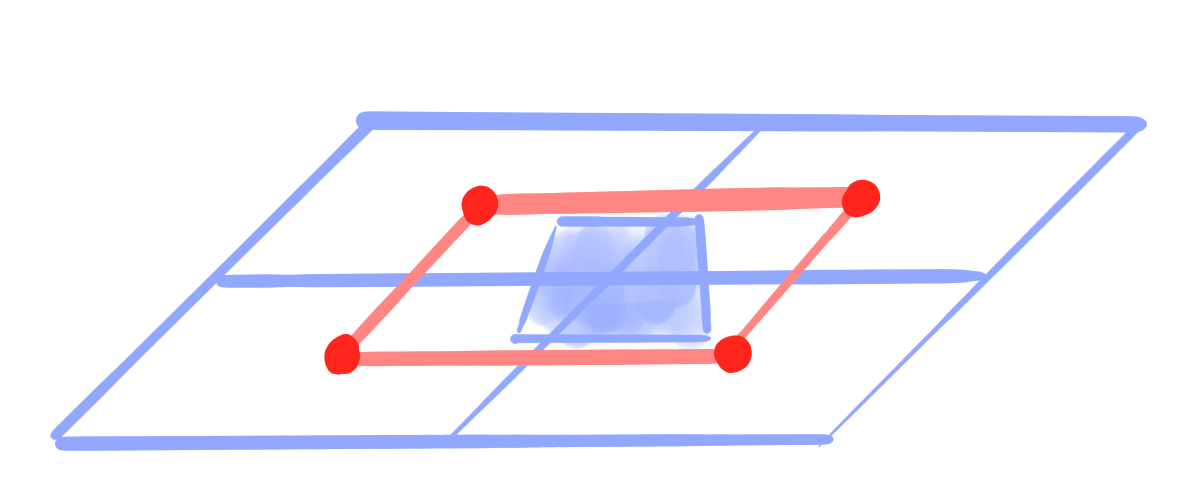
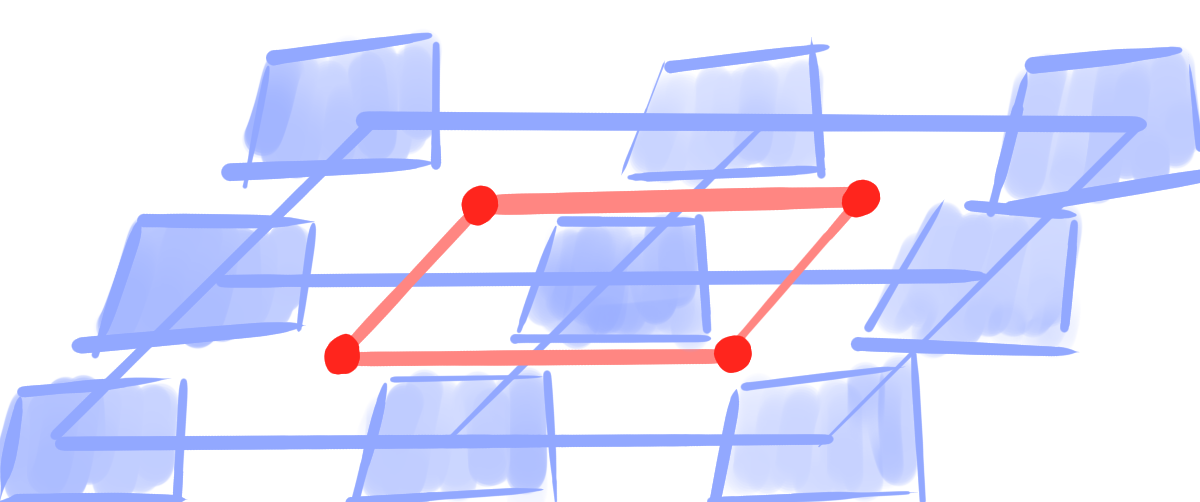
- The points of the remaining faces can be reconstructed by \[ \small \lceil g \rceil(f) = \bigcap_{v \in f} \square g(v). \]
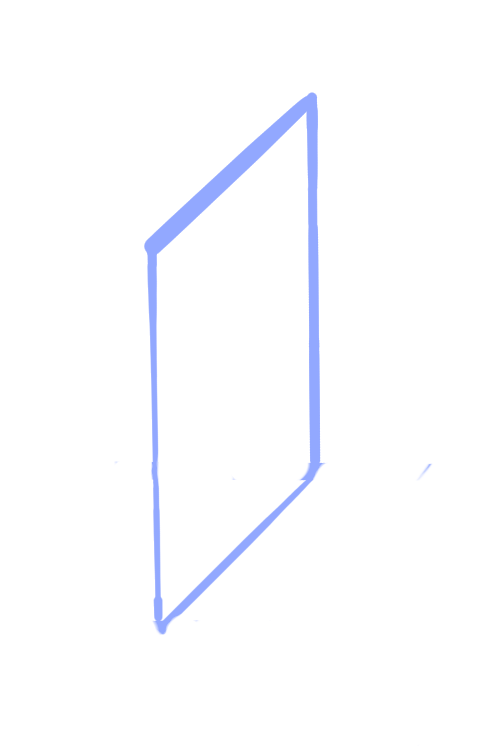
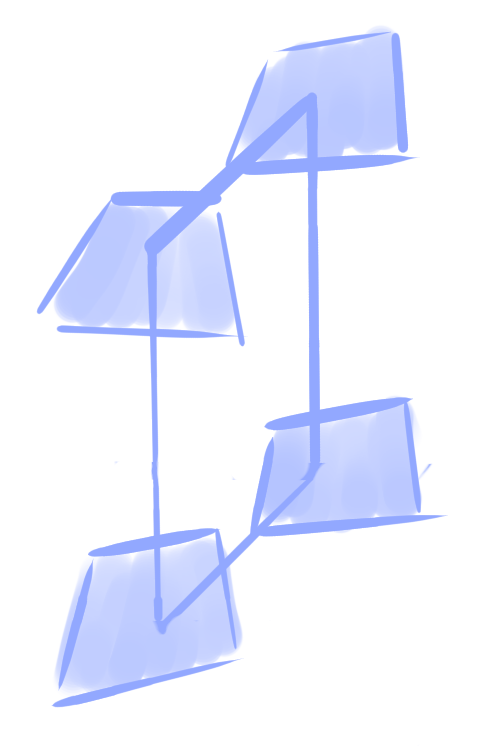
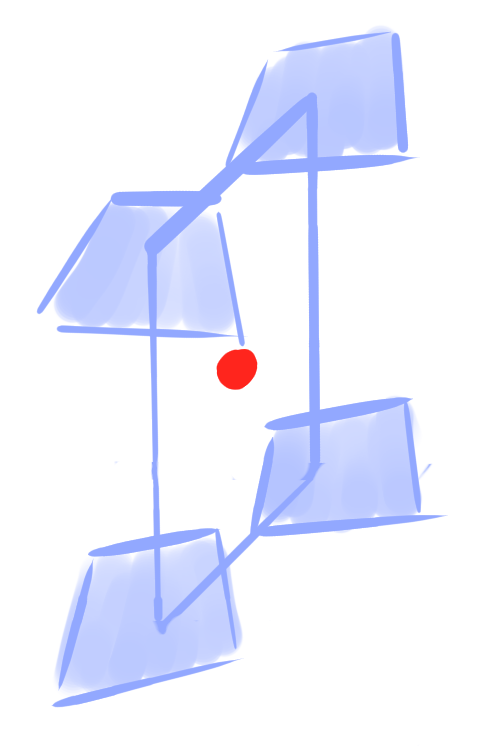
Lemma:
Let $~g : F^{ij}_N \rightarrow \R\mathrm{P}^n~$ be a conjugate vertex-net.
Then there exists a unique conjugate face-net $~\lceil g \rceil : F_N \rightarrow \R\mathrm{P}^n~$ that restricts to $g$ on $F^{ij}_N$.
Bijection: conjugate face-nets on $F_N$ $~\longleftrightarrow~$ conjugate vertex-nets on $F_N^{ij}$
Theorem:
Conjugate face-nets are multi-dimensionally consistent 3D-systems.
Definition:
A conjugate binet is a map $~b : D_N \rightarrow \R\mathrm{P}^n~$ such that
$b|_{V_N}$ is a conjugate vertex-net and $b|_{F_N}$ is a conjugate face-net.
It defines a corresponding map $~\square g : D_N \rightarrow \mathrm{Planes}(\R\mathrm{P}^n)~$.
A conjugate binet is a map $~b : D_N \rightarrow \R\mathrm{P}^n~$ such that
$b|_{V_N}$ is a conjugate vertex-net and $b|_{F_N}$ is a conjugate face-net.
It defines a corresponding map $~\square g : D_N \rightarrow \mathrm{Planes}(\R\mathrm{P}^n)~$.
Theorem:
Conjugate binets are multi-dimensionally consistent 3D-systems.
Definition:
Let $\mathcal{Q} \subset \R\mathrm{P}^n$ be a quadric.
A polar binet is a map $~ b : D_N \rightarrow \R\mathrm{P}^n ~$ such that \[ \small b(v) \perp b(f) \qquad \text{for all incident} ~ v \in V_N, f \in F_N \]
A polar binet is a map $~ b : D_N \rightarrow \R\mathrm{P}^n ~$ such that \[ \small b(v) \perp b(f) \qquad \text{for all incident} ~ v \in V_N, f \in F_N \]

|

|
Theorem:
Polar conjugate binets are a consistent reduction of conjugate binets.
Proof:
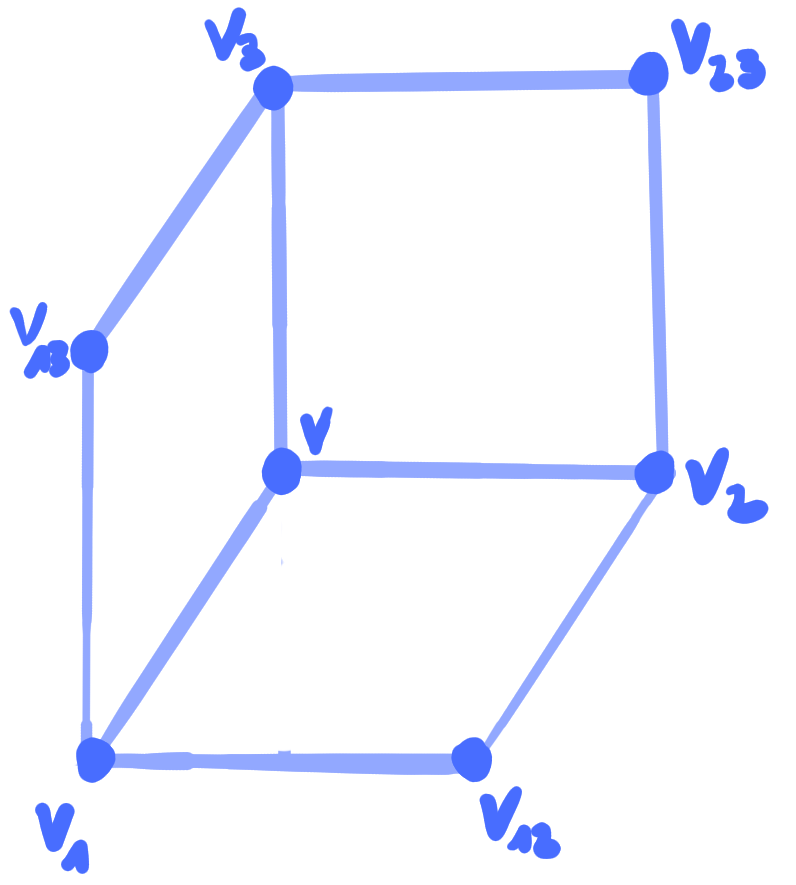
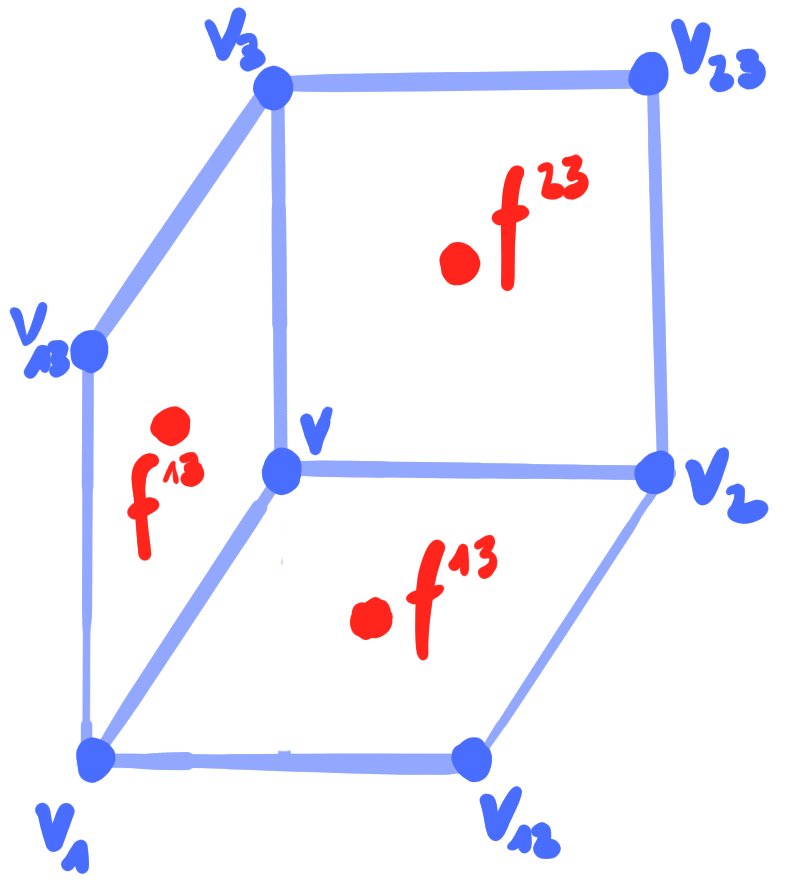
|
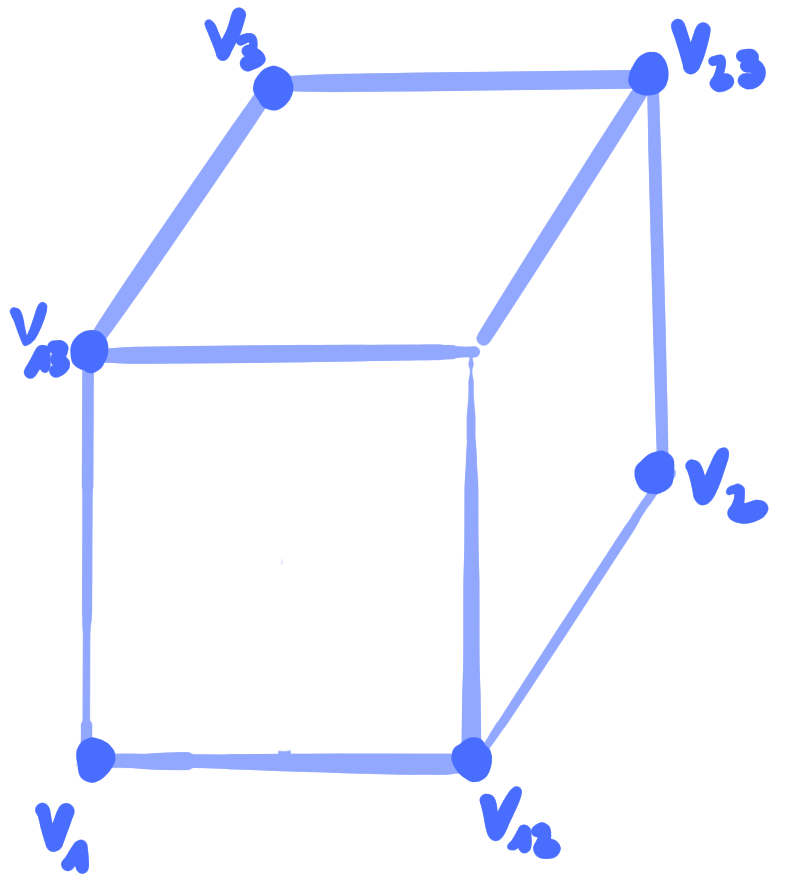
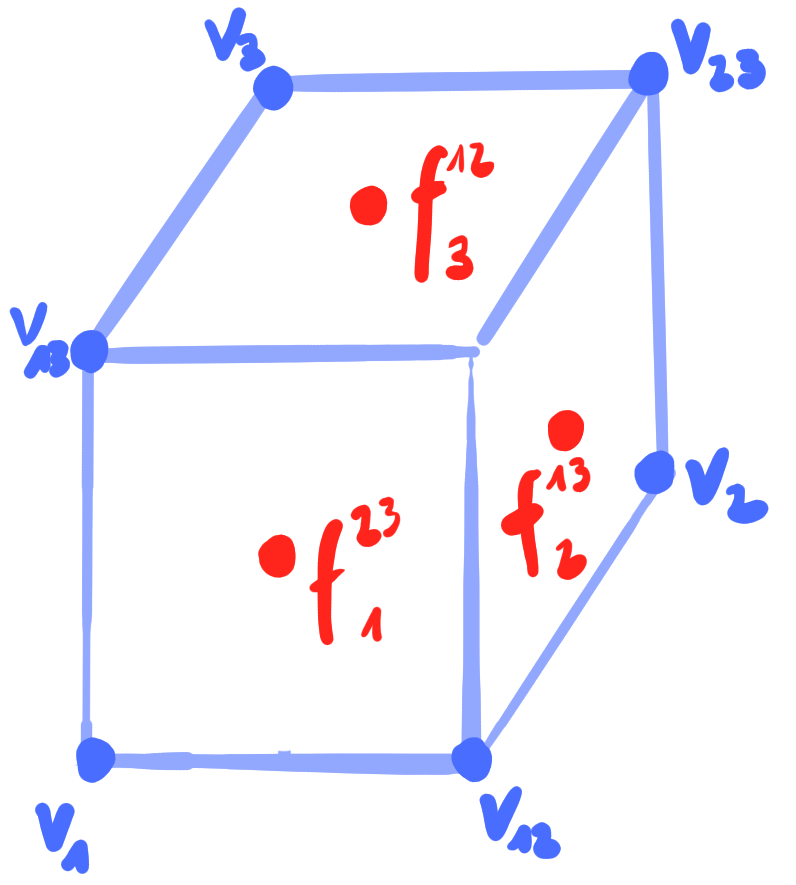
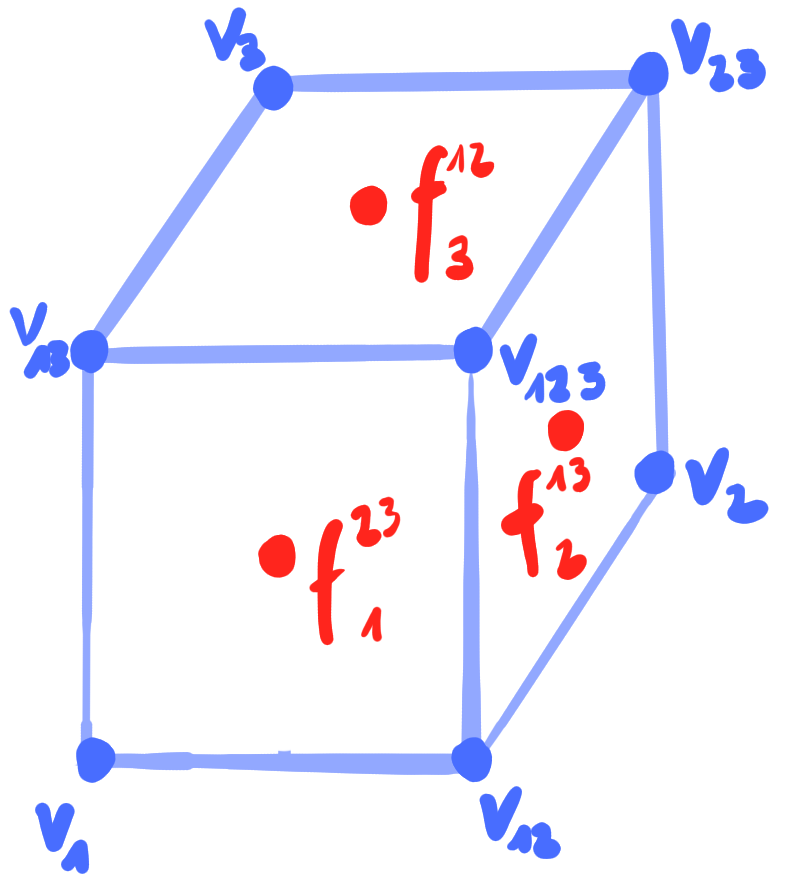
|
For conjugate binets the polarity condition is equivalent to
$
~\square b(d) \subset b(d)^\perp.
$
\[
\scriptsize
\begin{aligned}
\square b(f_3^{12}) &= b(v_{23}) \vee b(v_{3}) \vee b(v_{13})\\
&\subset \square b(v_{23})^\perp \vee \square b(v_{3})^\perp \vee \square b(v_{13})^\perp
= (\square b(v_{23}) \cap \square b(v_{3}) \cap \square b(v_{13}))^\perp
= b(f^{12}_3)^\perp
\end{aligned}
\]
\[
\scriptsize
\begin{aligned}
\square b(v_{123}) &= b(f_3^{12}) \vee b(f_2^{13}) \vee b(f_1^{23})\\
&\subset \square b(f_3^{12})^\perp \vee \square b(f_2^{13})^\perp \vee \square b(f_1^{23})^\perp
= (\square b(f_3^{12}) \cap \square b(f_2^{13}) \cap \square b(f_1^{23}))^\perp
= b(v_{123})^\perp.
\end{aligned}
\]
Recall: Principal binets in $\R^3$ can be lifted to polar conjugate binets in $\R\mathrm{P}^4$.
Corollary:
Principal binets in $\R^3$ are a consistent reduction of conjugate binets in $\R^3$.